Sasakawa International Center for Space Architecture (SICSA)
The only one of its kind in the world, the Cullen College’s space architecture program involves engineers and technical architects teaming up to design missions and operations from the ground up. The operational center for the program is the Sasakawa International Center for Space Architecture, or SICSA, which is internationally recognized as the center that both defines and leads the space architecture field.
The Sasakawa International Center for Space Architecture (SICSA) is a unique interdisciplinary research, design and teaching academic center that supports the world’s only Master of Science (MS) degree in Space Architecture. In 2015 The Texas Higher Education Coordinating Board approved changing the degree to a master of science with a STEM — science, technology, engineering and math — designation. We are academic leaders in the field of space architecture and are also active in the planning and designing of facilities for extreme environments on Earth. These include ocean facilities, polar research stations and human disaster accommodations. Graduates will also conduct trade studies and learn about operational factors which contribute to the design, such as logistics, orbital mechanics, transportation cost trades, etc. Our collaborators have included NASA, The Boeing Company, Oceaneering, and the Houston Airport System/Houston Spaceport.
SICSA offers two types of MS-Space Architecture curriculum , one for full-time students (3 semesters) and another for part-time local industry employees (5 semesters). The program is also developing a professional 3 course certification and will be able to deliver selected content on-line. Students with various bachelor of science (BS) degrees and background are eligible to apply, as well as 5th year Architecture degrees with appropriate technical qualifications. One of the signature courses includes a group 2 semester “studio” in which students work as a team on a real design. All graduate student application review and acceptance processes follow academic procedures and standards established by the University and College which are administered by the Associate Dean, Assistant Dean and Graduate Program Director. Upon verification that these requirements are satisfied, SICSA faculty participate in the final candidate selection decisions. Admission requirements can be found here .
Space architecture is an interdisciplinary field that involves the planning and design of facilities in extreme environments on earth and in space, including ocean facilities, polar research stations, human disaster accommodations and orbiting space stations. Their work includes orbital mechanics, human habitats, logistics, design for extreme environments, life support systems, human factors and launch capability trades.

View More SICSA News

Students Final Presentations
View the Projects
- College of Engineering News
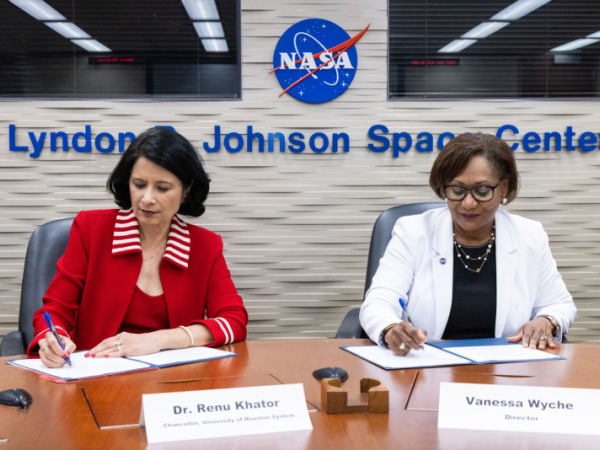
View More College of Engineering News
- SICSA Background and Overview
- Administrative, Research, and Teaching Staff
- Aerospace Engineering Dual Degree
- Research Areas
- Facilities and Laboratories
- Centers and Consortia
- Industrial Relations
- Conferences
- SICSA Lecture Series
- Publications & Reports
- Joint-degree Programs
- Undergraduate Studies
- The Jim Vlock First Year Building Project
- Summer Programs
- Rome Program
- Visualization 1
- Awards and Fellowships
- Explore all Courses
- Requirements
- Tuition and Fees
- Financial Aid
- International Students
- Academic Calendar
- Exhibitions
- Retrospecta
- History and Objectives
- Tribal Lands Acknowledgement
- Yale Urban Design Workshop
- Yale Center for Ecosystems in Architecture
- Advanced Technology
- Explore all Faculty
- Endowed Professorships
- Student Affairs
- Recent Graduates
- Student Work
- Student Groups
- Career Development

Introduction
Past dissertations, forms and resources.
The doctoral program in Architecture currently offers two tracks of study: History and Theory of Architecture, and Ecosystems in Architectural Sciences. Both tracks aim to educate teachers capable of effectively instructing future architects in their own field and its manifold connections with the culture at large. The program forges a unique combination of professional knowledge with a historical and analytical grasp of architecture, deepening awareness of the field’s current state and the critical issues it faces.
The History and Theory track provides sound training in historical study and historiography, and cultivates understanding of intellectual trends that inform the reception and role of architecture in the world at large. It prepares candidates for careers in university teaching, cultural advocacy and administration, museum curatorship, and publishing, among others. Students draw on a wide range of disciplines including, but not limited to, the history of science and technology, social and political history, media theory, as well as the fine arts, literature, and popular culture.
The Ecosystems in Architectural Sciences track provides preparation in interdisciplinary scientific inquiry, qualifying students to incorporate scientific methods into experimental design frameworks in order to research and develop novel material and informational ecosystems. Students in this track engage in research related to the behaviors of living ecosystems, emphasizing their interconnection with the built environment.
Joan Ockman, Director of Doctoral Studies
Ateya Khorakiwala Granularities: Concrete and the “Gray Architecture” of Grain Storage in 1960s and 70s India
Albena yaneva the craft of architectural archiving, eeva-liisa pelkonen in conversation with nicola suthor untimely moderns: how 20th century architecture reimagined the past, current candidates and students, publications by current and graduated phd students.
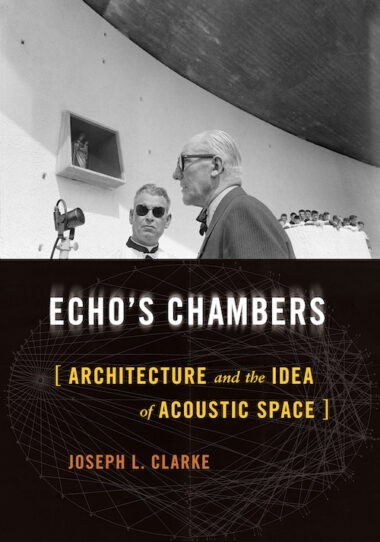
Echo’s Chambers: Architecture and the Idea of Acoustic Space
University of pittsburgh press.

Avant-Garde as Method: Vkhutemas and the Pedagogy of Space, 1920-1930

Babel’s Present
Standpunkte dokumente.

Perspecta 46
Aaron tobey and jia weng win 2023 carter manny awards for writing and research, cea phd student phoebe mankiewicz wins lafargeholcim award for indoor plant module, tim altenhof (ph.d. ‘18) wins theron rockwell field prize for his dissertation “breathing space: the architecture of pneumatic beings”, david turturo.
Caryatid: Architecture and the Framing of Bodies (2022). View dissertation.
Theodossios Issaias
Architectures of the Humanitarian Front, 1915-1930: The American Red Cross and the Refugee Settlement Commission of the League of Nations (2021). View dissertation.
A Theory of Common Form in Aesthetic Perception (2019). Abstract.
Skender Luarasi
Where Do You Stop? A Critical Inquiry into Style, Geometry, and Parametricism in History (2018). Abstract.
Tim Altenhof
Breathing Space: The Architecture of Pneumatic Beings (2018). Abstract.
Teaching Architecture to the Masses: Vkhutemas and the Pedagogy of Space, 1920-1930 (2017). Abstract
Surry Schlabs
Waiting for Architecture: John Dewey and the Limits of Modern Art (2017). Abstract.
Kyle Dugdale
Architecture After the Death of God: Uriel Birnbaum’s Der Kaiser und derArchitekt (2015). Abstract.
Joseph Clarke
The Architectural Discourse of Reverberation, 1750-1900 (2014). Abstract.
- Request to Take Course at Architecture School ((Non-YSoA Grad & Professional Students))
- Graduate School Forms
Graduate Research Assistant and Teaching Fellow Experience
Master’s degree, required courses, history and theory track.
551a, Ph.D. Seminar I 1 credit. (Required in, and limited to, Ph.D. first year, fall term.) This seminar centers on a thorough examination of fundamental ideas of historiography, centering on Rome and exploring aspects of geology, culture, mapping, site development, the establishment of institutions, and the construction of buildings across several millennia, as well as a study of literature on the urbs and its worldwide impact. Faculty
552b, Ph.D. Seminar II 1 credit. (Required in, and limited to, Ph.D. first year, spring term.) This seminar centers on concepts of history and their application to architecture from Jacob Burckhardt to the present and a close reading of historiographic theories, including ethnography, modernity, and the emergence of the profession of architecture in the light of present-day critique. Faculty
553a, Ph.D. Seminar III 1 credit. (Required in, and limited to, Ph.D. second year, fall term.) Seminar content to be announced. Faculty
554b, Ph.D. Dissertation Preparation 1 credit. (Required in, and limited to, Ph.D. second year, spring term.) Ph.D. tutoring in preparation for oral examinations and formulation of a thesis topic. Faculty
Required Courses, Ecosystems in Architectural Sciences Track
558a, Ph.D. Seminar: Ecosystems in Architecture I 1 credit. (Required in, and limited to, Ph.D. first year, fall term.)
559b, Ph.D. Seminar: Ecosystems in Architecture II 1 credit. (Required in, and limited to, Ph.D. first year, spring term.)
568a, Ph.D. Seminar: Ecosystems in Architecture III 1 credit. (Required in, and limited to, Ph.D. second year, fall term.)
569b, Ph.D. Seminar: Ecosystems in Architecture IV 1 credit. (Required in, and limited to, Ph.D. second year, spring term.)
History and Theory 4
Urbanism and landscape 1.
MA & PhD in Architecture
Ucla architecture and urban design offers two academic graduate degrees: the master of arts in architecture (ma) and doctor of philosophy in architecture (phd)..
The programs produce students whose scholarship aims to provoke and operate within architecture’s public, professional, and scholarly constituencies. Both programs are supported by the Standing Committee, made up of five faculty members: Michael Osman (interim program director), Cristóbal Amunátegui , Dana Cuff , Samaa Elimam , and Ayala Levin . A number of visiting faculty teach courses to expand the range of offerings.
Applications for the MA/PhD program (Fall 2024 matriculation) are completed via the UCLA Application for Graduate Admission , and are due January 6, 2024. Candidates will be notified of decisions in March 2024; admitted candidates who wish to accept the offer of matriculation must submit their Statement of Intent to Register (SIR) by April 15, 2024.
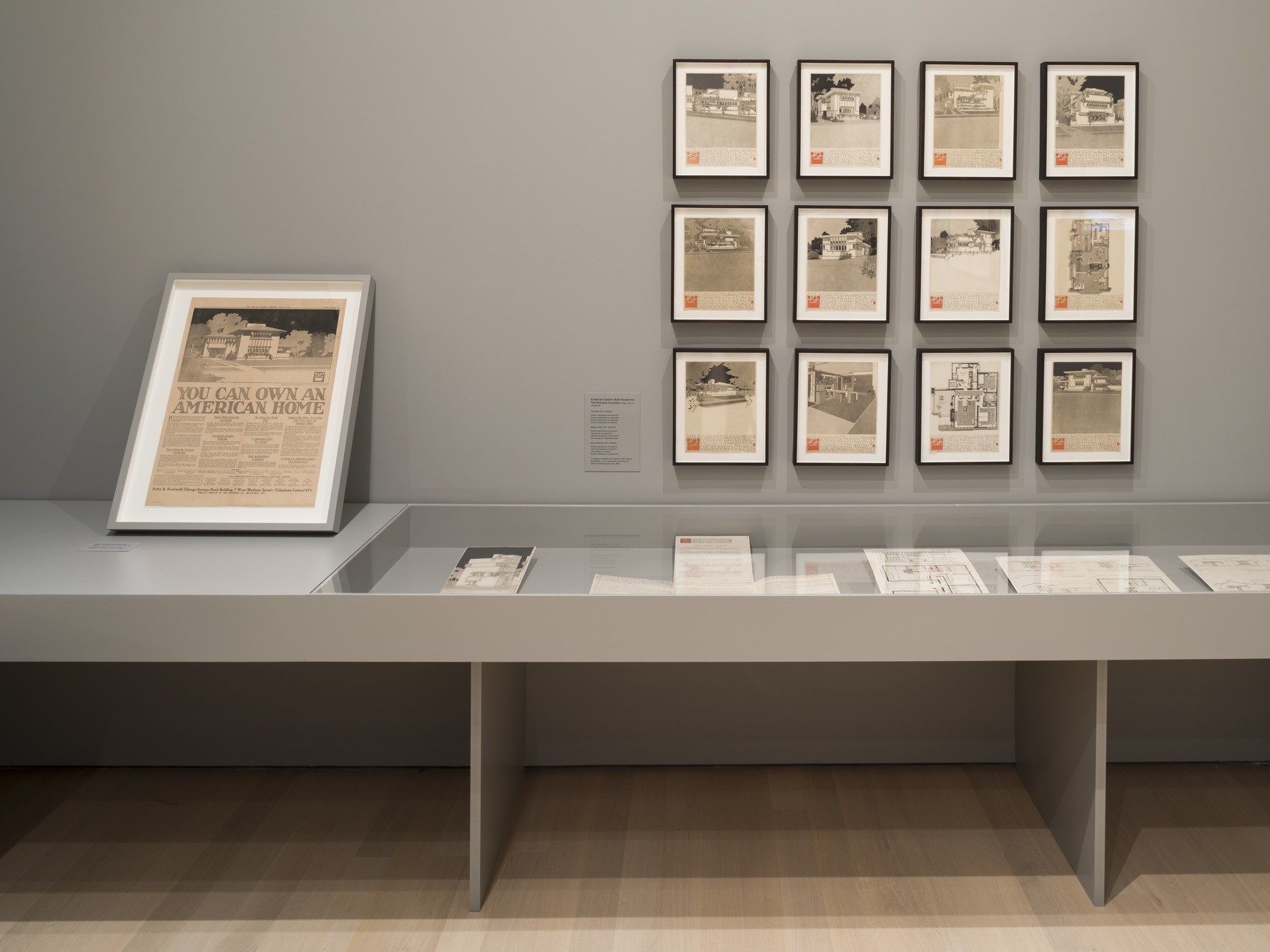
All MA and PhD students are required to enroll in a two-year colloquium focused on methods for writing, teaching, and researching in the field of architecture. The six courses that constitute the colloquium train students in the apparatus of academic scholarship. Over the two-year sequence, students produce original research projects and develop skills in long-format writing.
Research Opportunities
The intellectual life of the students in the MA and PhD programs are reinforced by the increasing number of opportunities afforded to students through specialized faculty-led research projects. These include cityLAB-UCLA and the Urban Humanities Institute .
MA in Architecture
This program prepares students to work in a variety of intellectual and programmatic milieus including historical research, cultural studies, and interdisciplinary studies with particular emphasis on connections with geography, design, art history, history of science and literary studies, as well as studio and design based research.
Beyond the core colloquium, MA students take a series of approved courses both at UCLA AUD and across campus. The MA program is a two-year degree, culminating in a thesis. The thesis is developed from a paper written by the student in their coursework and developed in consultation with the primary advisor and the standing committee. In addition to courses and individual research, students often participate in collective, project-based activities, including publications, symposia and exhibitions.
The program is distinguished by its engagement with contemporary design and historical techniques as well by the unusual balance it offers: fostering great independence and freedom in the students’ courses of study while providing fundamental training in architectural scholarship.
Recent MA Theses
- Jacqueline Meyer, “Crafting Utopia: Paolo Soleri and the Building of Arcosanti.”
- Joseph Maguid, “The Architecture of the Videogame: Architecture as the Link Between Representational and Participatory Immersion.”
- Meltem Al, “The Agency of Words and Images in the Transformation of Istanbul: The Case of Ayazma.”
- Courtney Coffman, “Addressing Architecture and Fashion: On Simulacrum, Time and Poché.”
- Joseph Ebert, “Prolegomena to a Poiesis of Architectural Phenomenology.”
- Jamie Aron, “Women Images: From the Bauhaus Weaving Workshop to the Knoll Textile Division.”
- Gustave Heully, “Moldy Assumptions.”
- Brigid McManama, “Interventions on Pacoima Wash: Repurposing Linear Infrastructure into Park Spaces.”
MA Typical Study Program
Phd in architecture.
This program prepares students to enter the academic professions, either in architectural history, architectural design, or other allied fields. PhD students are trained to teach courses in the history and theory of architecture while also engaging in studio pedagogy and curatorial work. In addition to the colloquium, PhD students take a series of approved courses both at UCLA Architecture and Urban Design and across campus. They select these courses in relation to their own research interests and in consultation with their primary advisor. The priorities for selection are breadth of knowledge and interdisciplinary experience that retains a focused area of expertise. To this end, the students identify Major and Minor Fields of study. The Minor Field is generally fulfilled by satisfactorily completing three courses given by another department and the Major Field by five courses offered by UCLA Architecture and Urban Design.
Once coursework is completed, PhD students move to the Comprehensive Exam, Qualifying Exam, and the writing of a dissertation, and final defense, if deemed appropriate by the doctoral committee. In the transition from coursework to exams, PhD students work on one paper beyond its original submission as coursework. The paper begins in the context of a departmental seminar, but often continues either in the context of an independent study, summer mentorship, or a second seminar with faculty consent. Upon the research paper’s acceptance, students begin preparing for their comprehensive exam. Before their third year, students must also satisfactorily complete three quarters of language study or its equivalent according to University standards. The particular language will be determined in consultation with the Standing Committee. The Comprehensive Exam is administered by at least two members of the Standing Committee and at most one faculty member from another Department at UCLA, also a member of the Academic Senate.
The Comprehensive Exam tests two fields: the first covers a breadth of historical knowledge—300 years at minimum—and the second focuses on in-depth knowledge of a specialization that is historically and thematically circumscribed. Students submit an abstract on each of these fields, provide a substantial bibliography, and prepare additional documentation requested by their primary advisor. These materials are submitted to the committee no less than two weeks before the exam, which occurs as early as the end of the second year. Students are encouraged to complete the Comprehensive Exam no later than the end of their third year of study.
The Comprehensive Exam itself consists of two parts: an oral component that takes place first, and then a written component. The oral component is comprised of questions posed by the committee based on the student’s submitted materials. The goal of the exam is for students to demonstrate their comprehensive knowledge of their chosen field. The written component of the exam (which may or may not be waived by the committee) consists of a written response to a choice of questions posed by the committee. The goal of this portion of the exam is for students to demonstrate their research skills, their ability to develop and substantiate an argument, and to show promise of original contribution to the field. Students have two weeks to write the exam. After the committee has read the exam, the advisor notifies the student of the committee’s decision. Upon the student’s successful completion of the Comprehensive Exam, they continue to the Qualifying Exam.
Students are expected to take the Qualifying Exam before the beginning of the fourth year. The exam focuses on a dissertation prospectus that a student develops with their primary advisor and in consultation with their PhD committee. Each student’s PhD committee consists of at least two members of the Standing Committee and one outside member from another department at the University (and a member of the Faculty Senate). Committees can also include faculty from another institution. All committees are comprised of at least three members of UCLA Academic Senate. The prospectus includes an argument with broad implications, demonstrates that the dissertation will make a contribution of knowledge and ideas to the field, demonstrates mastery of existing literature and discourses, and includes a plan and schedule for completion.
The PhD dissertation is written after the student passes the qualifying exam, at which point the student has entered PhD candidacy. The dissertation is defended around the sixth year of study. Students graduating from the program have taken posts in a wide range of universities, both in the United States and internationally.
Recent PhD Dissertations
- Marko Icev, "Building Solidarity: Architecture After Disaster and The Skopje 1963 Post-Earthquake Reconstruction." ( Read )
- Anas Alomaim, "Nation Building in Kuwait, 1961-1991."
- Tulay Atak, “Byzantine Modern: Displacements of Modernism in Istanbul.”
- Ewan Branda, “Virtual Machines: Culture, telematique, and the architecture of information at Centre Beaubourg, 1968–1977.”
- Aaron Cayer, "Design and Profit: Architectural Practice in the Age of Accumulation"
- Per-Johan Dahl, “Code Manipulation, Architecture In-Between Universal and Specific Urban Spaces.”
- Penelope Dean, “Delivery without Discipline: Architecture in the Age of Design.”
- Miriam Engler, “Gordon Cullen and the ‘Cut-and-Paste’ Urban Landscape.”
- Dora Epstein-Jones, “Architecture on the Move: Modernism and Mobility in the Postwar.”
- Sergio Figueiredo, “The Nai Effect: Museological Institutions and the Construction of Architectural Discourse.”
- Jose Gamez, “Contested Terrains: Space, Place, and Identity in Postcolonial Los Angeles.”
- Todd Gannon, “Dissipations, Accumulations, and Intermediations: Architecture, Media and the Archigrams, 1961–1974.”
- Whitney Moon, "The Architectural Happening: Diller and Scofidio, 1979-89"
- Eran Neuman, “Oblique Discourses: Claude Parent and Paul Virilio’s Oblique Function Theory and Postwar Architectural Modernity.”
- Alexander Ortenberg, “Drawing Practices: The Art and Craft of Architectural Representation.”
- Brian Sahotsky, "The Roman Construction Process: Building the Basilica of Maxentius"
- Marie Saldana, “A Procedural Reconstruction of the Urban Topography of Magnesia on The Maeander.”
- David Salomon, “One Thing or Another: The World Trade Center and the Implosion of Modernism.”
- Ari Seligmann, “Architectural Publicity in the Age of Globalization.”
- Zheng Tan, “Conditions of The Hong Kong Section: Spatial History and Regulatory Environment of Vertically Integrated Developments.”
- Jon Yoder, “Sight Design: The Immersive Visuality of John Lautner.”
A Sampling of PhD Alumni and Their Pedagogy
Iman Ansari , Assistant Professor of Architecture, the Knowlton School, Ohio State University
Tulay Atak , Adjunct Associate Professor, Pratt School of Architecture
Shannon Starkey , Associate Professor of Architecture, University of San Diego
Ece Okay , Affiliate Research, Université De Pau Et Des Pays De L'adour
Zheng Tan , Department of Architecture, Tongji University
Pelin Yoncaci , Assistant Professor, Department Of Architecture, Middle East Technical University
José L.S. Gámez , Interim Dean, College of Arts + Architecture, UNC Charlotte
Eran Neuman , Professor, School of Architecture, Tel Aviv University
Marie Saldana , Assistant Professor, School of Interior Architecture, University of Tennessee - Knoxville
Sergio M. Figueiredo , Assistant Professor, Eindhoven University of Technology
Rebecca Choi , Assistant Professor of Architecture History, School of Architecture, Tulane University
Will Davis , Lecturer in History, Theory and Criticism, Department of Architecture, National University of Singapore
Maura Lucking , Faculty, School of Architecture & Urban Planning, University of Wisconsin - Milwaukee
Kyle Stover , Assistant Professor, School of Architecture, Montana State University
Alex Maymind , Assistant Professor of Architecture and Director of Undergraduate Studies in Architecture, University of Minnesota
Gary Riichirō Fox , visiting faculty member at Southern California Institute of Architecture (SCI-Arc) and lecturer at USC School of Architecture
Randy Nakamura , Adjunct Professor, College of Arts and Sciences, University of San Francisco
Aaron Cayer , Assistant Professor of Architecture History, School of Architecture + Planning, University of New Mexico
Whitney Moon , Associate Professor of Architecture, School of Architecture & Urban Planning, University of Wisconsin - Milwaukee
Todd Gannon , Professor of Architecture, the Knowlton School, Ohio State University
Dora Epstein Jones , Professor of Practice, School of Architecture, the University of Texas at Austin
Sarah Hearne , Assistant Professor, College of Architecture and Planning, University of Colorado Denver
PhD Typical Study Program
*The choice of language to fulfill this requirement must be discussed with the Ph.D. Standing Committee
Our Current PhD Cohort
AUD's cohort of PhD candidates are leaders in their fields of study, deepening their scholarship at AUD and at UCLA while sharing their knowledge with the community.
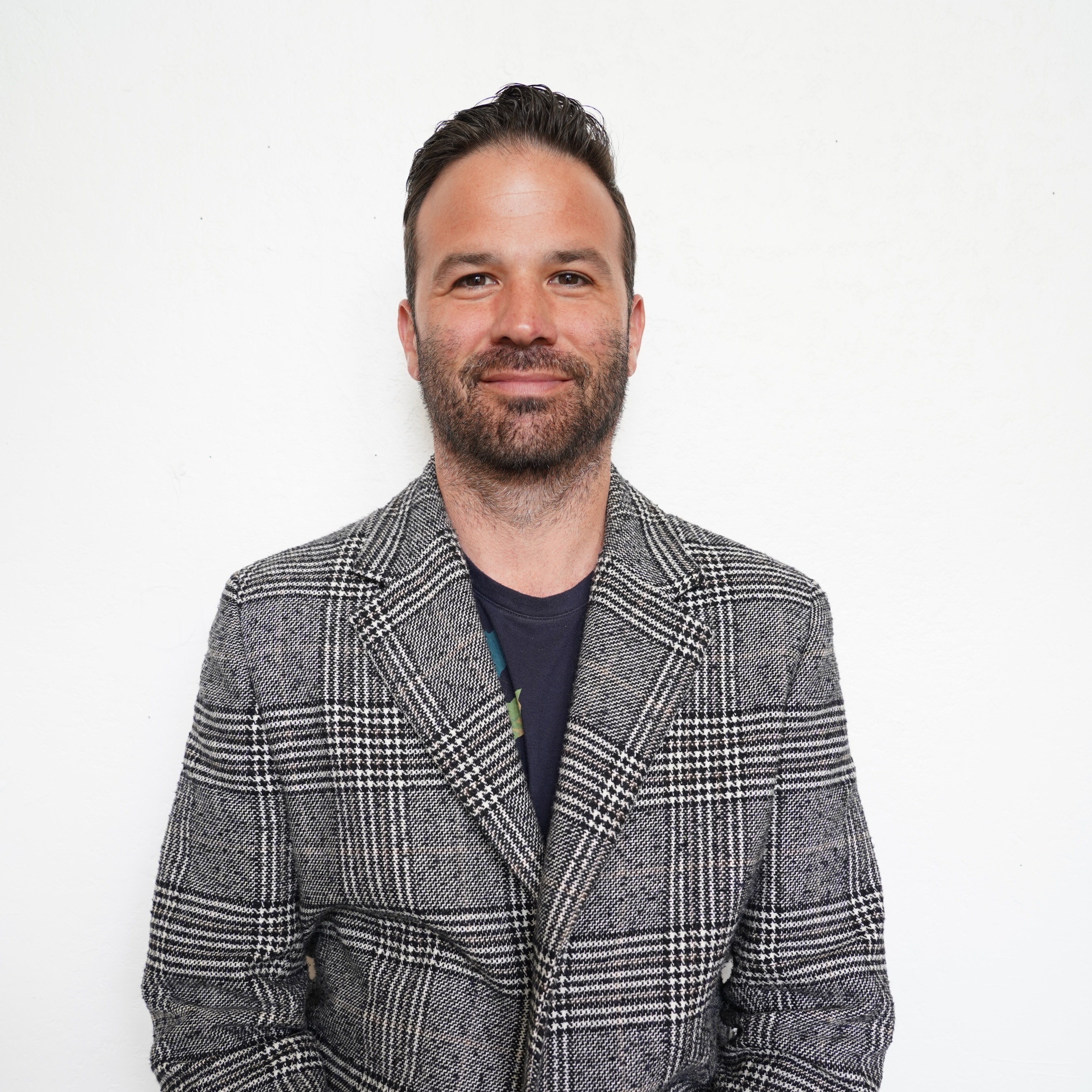
Adam Boggs is a sixth year Ph.D candidate and interdisciplinary artist, scholar, educator and Urban Humanist. His research and teaching interests include the tension between creativity and automation, craft-based epistemologies, and the social and material history of architecture at the U.S.-Mexico border. He holds a BFA in Sculpture Cum Laude from the Ohio State University, and an MFA in Visual Art from the State University of New York at Purchase College. Prior to joining the doctoral program at UCLA he participated in courses in Architecture (studio and history) at Princeton University and Cornell University. His dissertation analyzes the history of indigenous labor during the Mexican baroque period to form a comparative analysis with the 20th century Spanish revival architecture movement in Southern California and how the implementation of the style along the U.S.-Mexico border might function as a Lefebvrian “thirdspace” that disrupts binary thinking. In Spring 2024 he will teach an undergraduate seminar course at AUD on the history of architecture at the U.S.-Mexico border as part of the CUTF program.

Hanyu Chen is a second-year doctoral student at UCLA AUD. Her research focuses on the intersection between (sub)urban studies, heritage conservation, and the genders of the space. Specifically, it concerns the dynamics of genders in (sub)urban areas and how these dynamics are conserved as heritage. Born and raised in China for her first 18 years, Hanyu chose the conservation of comfort stations in China as her master's thesis at the University of Southern California, where she earned her master’s degree in Heritage Conservation and officially started her journey in architecture. Her thesis discusses the fluidity and genders of comfort stations and how they survive in contemporary China’s heritage conservation policies.
Hanyu also holds a Bachelor of Science degree in AMS (Applied Mathematics and Statistics) and Art History from Stony Brook University.
Yixuan Chen

Yixuan Chen is an architectural designer and a first-year doctoral student in the Department of Architecture and Urban Design at UCLA. Driven by an impulse to demystify both the grand promises and trivial familiarities of architecture, her research embarks on the notion of everydayness to elucidate the power dynamics it reveals. She investigates the conflicts between these two ends and focuses on modernization across different times and places.
Prior to joining UCLA AUD, she was trained as an architect and graduated from the University of Nottingham's China Campus with a first-class honors degree. Her graduation project “Local Culture Preservation Centre,” which questioned the validity of monumental architecture in the climate crisis, was nominated for the RIBA President's Medal in 2016.
She also holds a Master of Arts degree with distinction in Architectural History from the Bartlett School of Architecture, University College London. Her dissertation, “Shijing, on the Debris of Shijing,” explores the vanishing shijing places, or urban villages, where rural migrant workers negotiate their urban identity in Chinese cities, revealing shifting power relations. Additionally, she authored an article in Prospectives Journal titled "Architectural Authorship in ‘the Last Mile,’" advocating for a change to relational architectural authorship in response to the digital revolution in architecture.
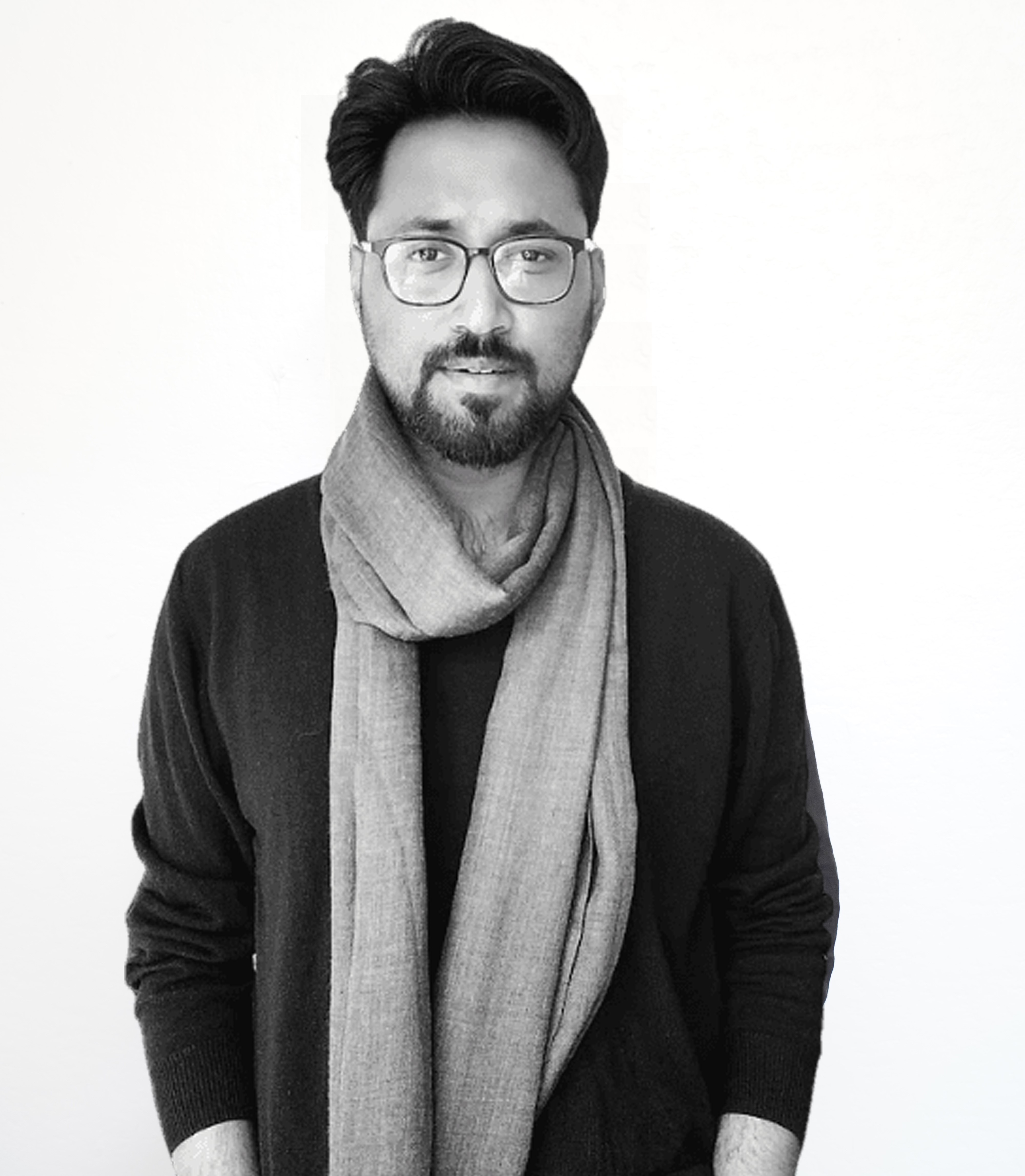
Pritam Dey is an urban designer and second-year doctoral student at UCLA AUD. His research interest lies at the intersection of colonial urbanism, sensorial history, and somatic inquiries. His architecture thesis investigated the crematorium and temple as sensorial infrastructure, and was presented at World Architecture Congress at Seoul in 2017. Previously Dey worked in the domain of urban design, specifically informal markets, as a shaper of urbanism in Indian cities. Prior to joining the AUD doctoral program, his past research focused on investigating the role of informal and wholesale markets in shaping up urbanity in the Indian city cores and co-mentored workshops on Urbanity of Chitpur Road, Kolkata with ENSAPLV, Paris which was both exhibited at Kolkata and Paris. He also co-mentored the documentation of the retrospective landscape of Hampi with the support of ENSAPLV and French Embassy. His investigations on the slums of Dharavi title ‘The tabooed city’ was published in the McGill University GLSA Research series 2021 under the theme: the city an object or subject of law?
An urban designer and architect, Pritam Dey pursued his post graduation from School of planning and Architecture, Delhi. During his academic tenure at SPA, he was the recipient of 2018 Design Innovation Center Fellowship for Habitat design allowing him to work on the social infrastructure for less catered communities in the Sub Himalayan Villages. In 2022 He mentored a series of exhibitions on the theme of Water, Mountains and Bodies at Ahmadabad.
He was the 2022-23 Urban Humanities Initiatives Fellow at UCLA and recipient of 2023 UCLA Center for India and South Asia fellowship for his summer research.
Carrie Gammell

Carrie Gammell is a doctoral candidate working at the intersection of architectural history, property law, and political economy. Her research focuses on claims, investments, and intermediary organizations in the United States, from the Homestead Act of 1862 to the Housing Act of 1934.
Carrie is also a Senior Research Associate at cityLAB UCLA, where she studies state appropriations for California community college student housing. In the past, she contributed to Education Workforce Housing in California: Developing the 21st Century Campus, a report and companion handbook that provides a comprehensive overview of the potential for land owned by school districts to be designed and developed for teachers and other employees.
Prior to joining AUD, Carrie worked as an architectural designer in Colombia and the United States, where she built a portfolio of affordable housing, multi-family residential, and single-family residential projects as well as civic and cultural renovations and additions. She holds a Bachelor of Architecture from Rice University and a Master in Design Studies (Critical Conservation) from the Harvard Graduate School of Design.
Anirudh Gurumoorthy
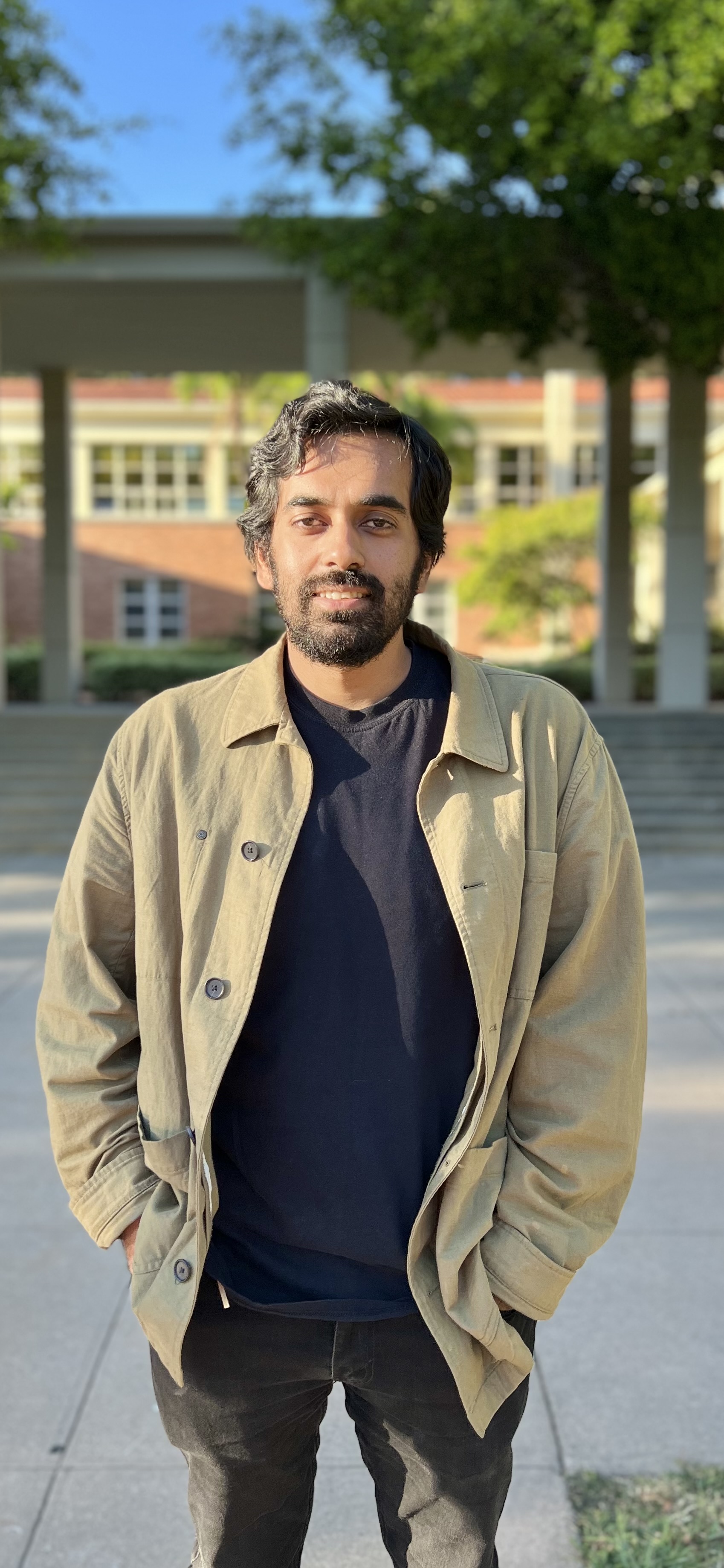
Anirudh Gurumoorthy is a PhD candidate at UCLA AUD. His dissertation, tentatively titled (Un)Certain Tropics and the Architecture of Certain Commodities, 1803-1926, focuses on the spatial and environmental histories of natural history/sciences in the long-nineteenth century as it related to the political economy of empire within South Asia. He is interested in the ways the materiality of commodity extraction and production contends with how, where, and why certain ‘tropical’ animals, vegetables, and minerals are attributed with a metropolitan sense of ‘value’. Moving from the United States to Britain (and back) through various parts of the Indian Ocean world as markets for singular forms of ice, rubber, and cattle form, peak, and collapse, the dissertation ultimately aims to reveal interconnected spatial settings of knowledge, control, regulation, display, and labor where knowledge systems, technical limits, human and nonhuman action/inaction, differentiated senses of environments and value continually contend with each other to uphold the fetishes of the world market. Gurumoorthy holds a B.Arch. from R.V. College of Architecture, Bangalore, and an M.Des in the History and Philosophy of Design and Media from the Harvard Graduate School of Design.
Chi-Chia Hou
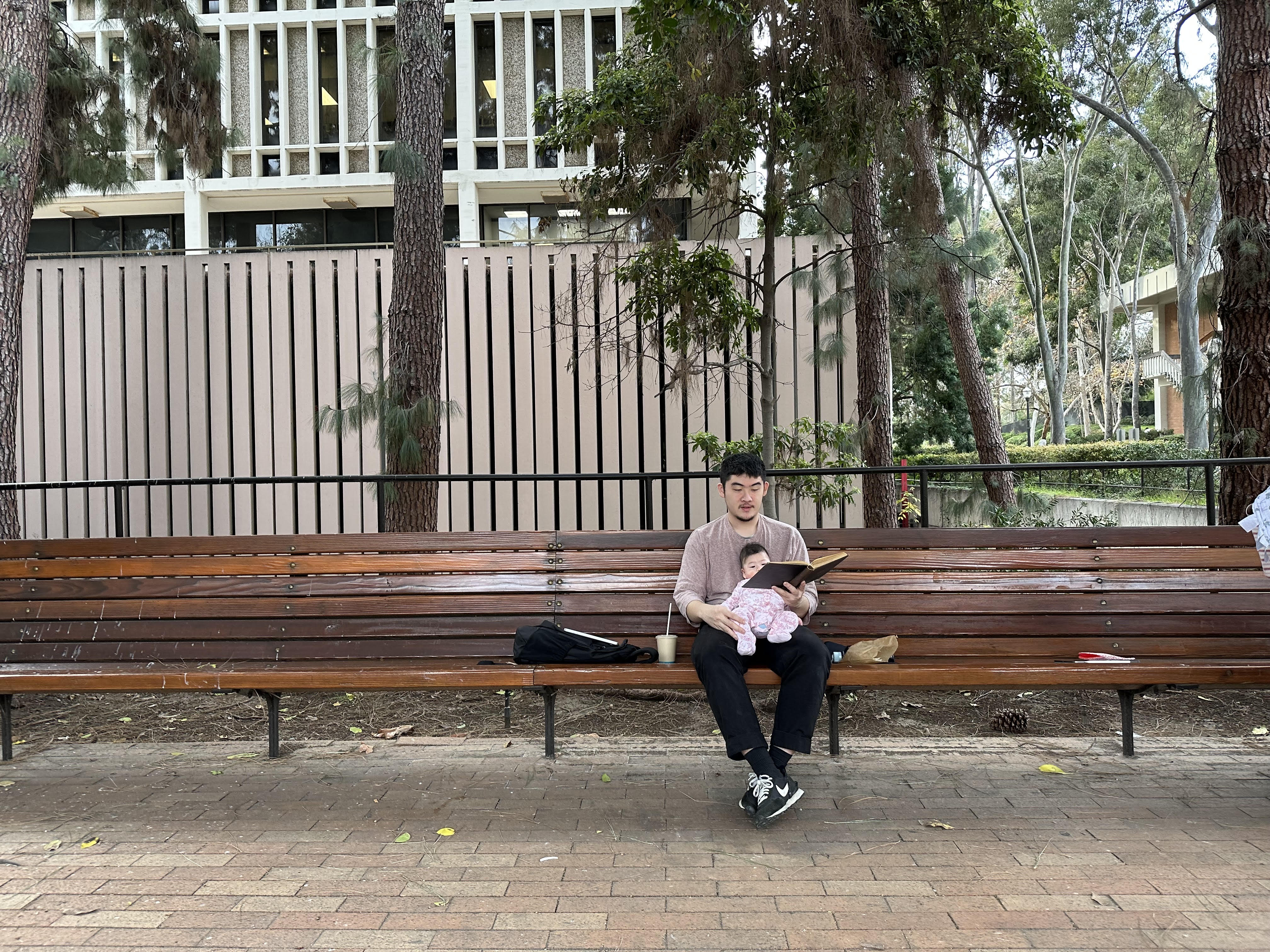
Chi-Chia Hou is a doctoral candidate in his sixth year at UCLA AUD. His working dissertation, “New Frontier: Architecture and Service 1893-1960,” explores his interest in architecture and wealth, changing ideas of profit and management, and social scientific discourses for measuring work and worker, self and others, and values of landed property.
His research locates moments of theorizing methodologies to manage income-generating properties in schools of agriculture, home economics, and hotel studies. The schools taught their students theories, while instilling the imminence of faithful direction of oneself, of self-as-property. The pedagogies, existing beyond the purview of Architecture, were of immense architectural consideration.
Chi-Chia Hou took a break from school in the previous academic year to learn from his daughter and has now returned to school to learn from his brilliant cohorts.
Adam Lubitz

Adam Lubitz is an urban planner, heritage conservationist, and doctoral student. His research engages the intersection of critical heritage studies and migration studies, with an emphasis on how archival information can inform reparations. His community-based research has been most recently supported by the Columbia GSAPP Incubator Prize as well as the Ziman Center for Real Estate and Leve Center for Jewish Studies at UCLA.
Prior to joining AUD, Adam worked at World Monuments Fund within their Jewish Heritage Program, and taught GIS coursework at Barnard College. His master's thesis applied field research with experimental mapping techniques in the old town of a municipality in Palestine. Adam holds MS degrees in Historic Preservation and Urban Planning from Columbia University and a BA in Urban Studies from New College of Florida.

José Monge is a PhD candidate in the Department of Architecture and Urban Design. His dissertation, titled Maritime Labor, Candles, and the Architecture of the Enlightenment (1750-1872) , focuses on the role that whale-originated illuminants, specifically spermaceti candles and oil, played in the American Enlightenment as an intellectual project and the U.S. as a country. By unravelling the tension between binaries such as intellectual and manual labor–the consumers that bought these commodities and the producers that were not able to afford them–the project understands architecture as a history of activities that moved from sea to land and land to sea, challenging assumptions about the static “nature” of architecture.
Kurt Pelzer

Kurt Pelzer is a fourth-year PhD candidate at UCLA AUD. Their research explores the relational histories, material flows, and politics of land in and beyond California in the long nineteenth century during the United States parks, public lands, and conservation movements.
Their current scholarship traces the settler possession and exhibitionary display of a Giant Sequoia (Sequoiadendron giganteum) in the 1850s; an act that contested the ways Miwok peoples ancestral to California's Sierra Nevada knew and related to life and land. Their broader interests include histories of colonialism and capitalism in the Americas, environmental history, and Blackness and Indigeneity as a methodological analytic for political solidarities and possibilities.
Prior to arriving at UCLA, Pelzer worked at the San Francisco Museum of Modern Art in the Architecture and Design Curatorial Department participating in exhibitions, programming, and collections work. Pelzer completed a Master of Advanced Architectural Design in the History, Theory, and Experiments program from California College of the Arts in San Francisco, and earned their Bachelor's degree in Landscape Architecture from the College of Design at Iowa State University.
Shota Vashakmadze
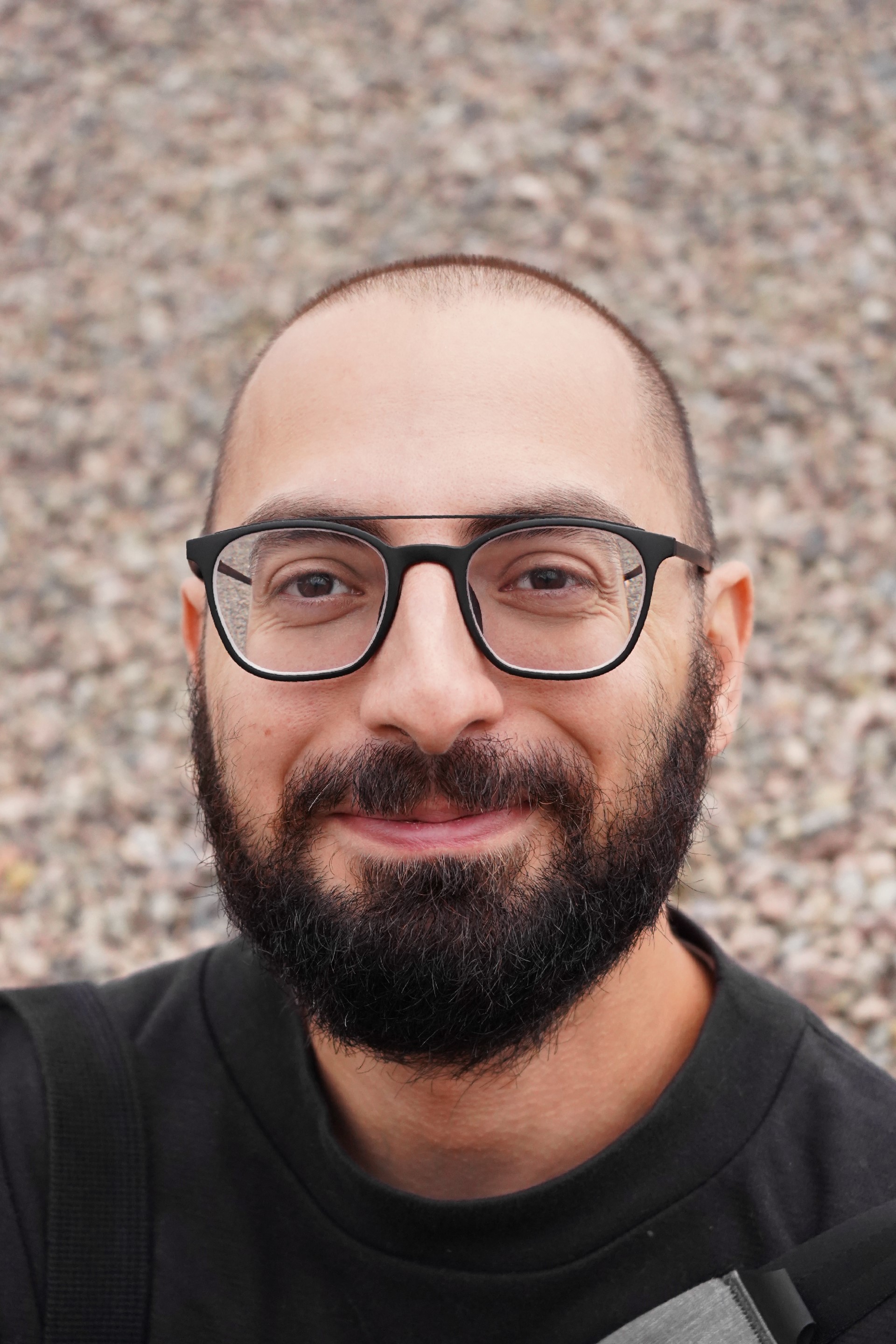
Email Shota Vashakmadze
Shota Vashakmadze is a sixth-year PhD candidate at UCLA AUD. His dissertation traces the conjoined histories of architectural computing, environmental design, and professional practice in the late 20th century, adopting critical approaches to architecture’s technical substrates—the algorithms, softwares, and user protocols of computation—to examine their social and political dispositions. In his scholarship and pedagogy, he aims to situate forms of architectural labor within the profession’s ongoing acculturation to environmental crisis. Most recently, he has been leading the development of the interdisciplinary “Building Climates” cluster, a year-long course sequence at UCLA, and co-organizing an initiative dedicated to fostering discourse on climate change and architecture, including a two-day conference entitled “Architecture After a Green New Deal.”
His research has been supported by the Canadian Centre for Architecture and appeared in journals including Architectural Theory Review , The Avery Review, and Pidgin Magazine. He is currently completing a contribution to a collection on landscape representation and a chapter for an edited volume on architecture, labor, and political economy.
Shota holds an MArch from Princeton University and has a professional background in architecture, landscape, and software development. Before coming to UCLA, he researched methods for designing with point cloud data and wrote Bison, a software plugin for landscape modeling.
Alexa Vaughn
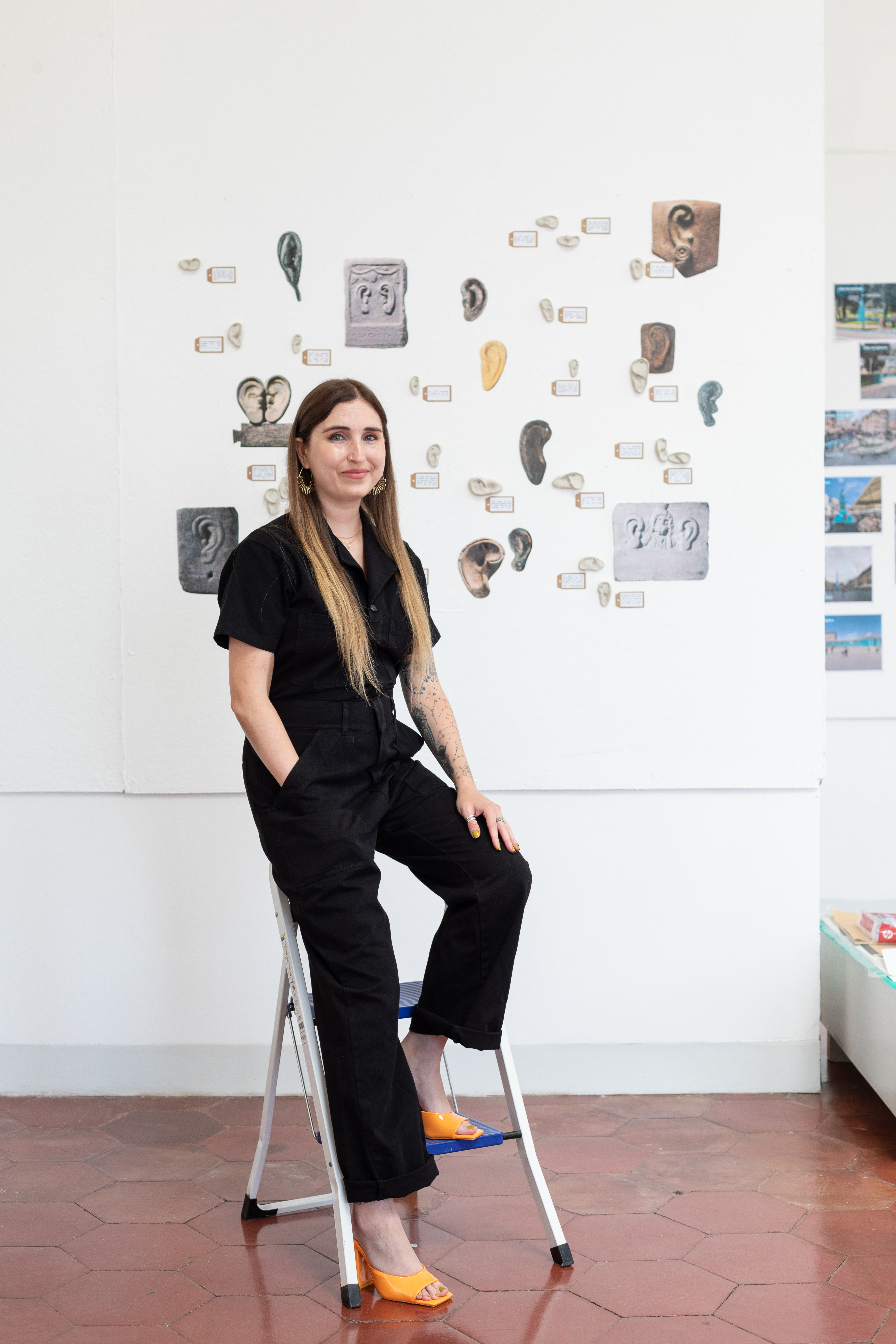
Alexa Vaughn (ASLA, FAAR) is a first year PhD student in Architecture + Urban Design and a Eugene V. Cota-Robles Fellow , from Long Beach, California. She is a Deaf landscape designer, accessibility specialist, consultant, and recent Fellow of the American Academy in Rome (2022-23). She is a visionary speaker, thought leader, prolific writer and researcher, and the author of “ DeafScape : Applying DeafSpace to Landscape,” which has been featured in numerous publications.
Her professional work is centered upon designing public landscapes with and for the Deaf and disabled communities, applying legal standards and Universal Design principles alongside lived experience and direct participation in the design process. She is an expert in designing landscapes for the Deaf community (DeafScape) and in facilitation of disabled community engagement. Prior to joining the A+UD program, Alexa worked for several landscape architecture firms over the course of six years, including OLIN and MIG, Inc.
Through a disability justice lens, her dissertation will seek to formally explore the historical exclusionary and inaccessible design of American urban landscapes and public spaces, as well as the response (activism, policy, and design) to this history through the present and speculative future. She will also actively take part in activist- and practice-based research with cityLAB and the Urban Humanities Institute .
Alexa holds both a BA in Landscape Architecture (with a minor in Conservation and Resource Studies) and a Master’s degree in Landscape Architecture (MLA) from the University of California, Berkeley, with specialization in accessible and inclusive design. Much of her work can be found at www.designwithdisabledpeoplenow.com and on Instagram: @DeafScape.
Yashada Wagle
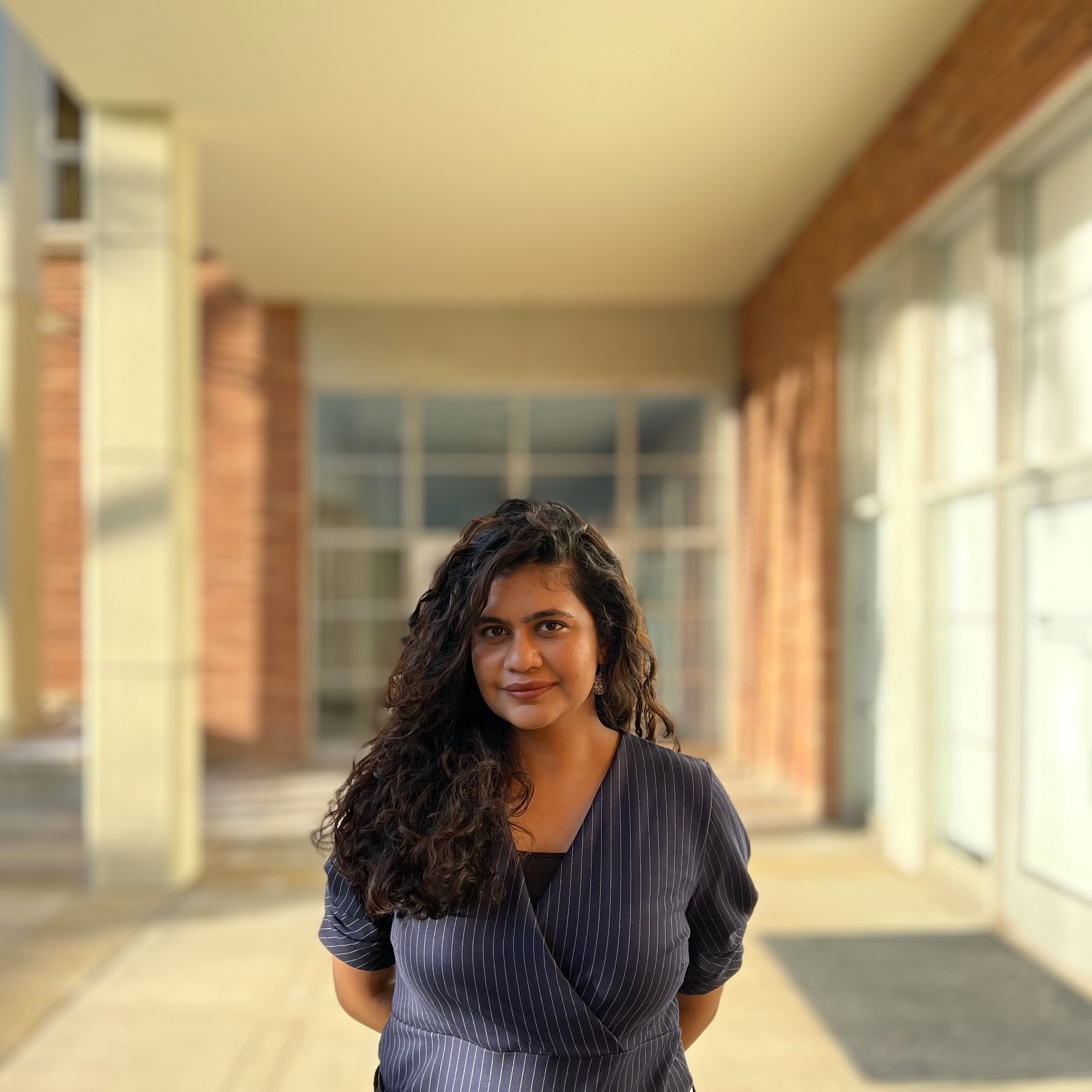
Yashada Wagle is a third year PhD student in Critical Studies at UCLA AUD, and a recipient of the department's Moss Scholarship. Her research focuses on imperial environmental-legislative regimes in British colonial India in the late nineteenth century. She is interested in exploring questions around the histories of spaces of extraction and production as they network between the metropole and the colony, and their relationship with the conceptions of laboring bodies therein. Her master's thesis focused on the Indian Forest Act of 1865, and elucidated the conceptualization of the space of the ‘forest’ through the lenses of its literary, legislative, and biopolitical trajectories, highlighting how these have informed its contemporary lived materiality.
Wagle holds a Bachelor in Architecture (BArch) from the Savitribai Phule Pune University in India, and a Master in Design Studies (History and Philosophy of Design and Media) from the Harvard Graduate School of Design. She was previously a Research Fellow at the Kamla Raheja Vidyanidhi Institute for Architecture and Environmental Studies (KRVIA) in Mumbai, India.
In her spare time, Wagle enjoys illustrating and writing poetry, some of which can be found here .
Dexter Walcott

Dexter Walcott is a registered architect currently in his fifth year with the Critical Studies of Architecture program at UCLA. His research focuses on the Latrobe family and early nineteenth century builders in the Mississippi and Ohio river valleys. He is interested in the role of the built environment in histories of labor, capitalism, steam-power, and industry.

Born and raised in Hong Kong, Joy is a fifth-year PhD student in architecture history. Her research explores geology as antiquity from early 19th – 20th century British colonial Hong Kong and China. She holds a B.A. in Comparative Literature with a focus in German from Middlebury College in 2017, and is a graduate of The New Normal program at Strelka Institute, Moscow in 2018. Previously, she has taught in the Department of Architecture at University of Hong Kong, as well as the Department of Design at Hong Kong Polytechnic University.
After working as a curatorial assistant at Tai Kwun Contemporary in 2019, she has continued the practice of art writing and translation, collaborating with many local Hong Kong artists as well as international curators such as Raimundas Malašauskas. In her spare time, she practices long-distance open water swimming. In 2022, she completed a 30km course at the South of Lantau Island, Hong Kong.
The MA and PhD programs welcome and accept applications from students with a diverse range of backgrounds. These programs are designed to help those interested in academic work in architecture develop those skills, so we strongly encourage that you become familiar with fundamental, celebrated works in the history and theory of architecture before entering the program.
Applicants to the academic graduate programs must hold a Bachelor’s degree, or the foreign equivalent. All new students must enter in the fall quarter. The program is full-time and does not accept part-time students.
Applications for the MA and PhD programs (Fall 2024 matriculation) will be available in Fall 2023, with application deadline of January 6, 2024; please revisit this page for updates. Accepted candidates who wish to enroll must file an online Statement of Intent to Register (SIR) by April 15, 2024.
How to Apply
Applying to the MA and PhD programs is an online process via the UCLA Application for Graduate Admission (AGA).
Completing the requirements will take some time, so we strongly recommend logging in to the AGA in advance to familiarize yourself with the site and downloading the documents and forms you will need to complete your application.
You can also download this checklist to make sure you have prepared and submitted all the relevant documents to complete your application.
Your Statement of Purpose is a critical part of your application to the MA and PhD programs. It is your opportunity to introduce yourself and tell us about your specific academic background, interests, achievements, and goals. Our selection committee use it to evaluate your aptitude for study, as well as consideration for merit-based financial support.
Your statement can be up to 1500 words in length. Below are some questions you might want to consider. You don’t need to answer every question; just focus on the elements that are most relevant to you.
- What is your purpose in applying to the MA or PhD program? Describe your area(s) of research interest, including any areas of concentration and specialization.
- What experiences have prepared you for this program? What relevant skills have you gained from these experiences? Have your experiences led to specific or tangible outcomes that would support your potential to contribute to this field (e.g. performances, publications, presentations, awards or recognitions)?
- What other information about your past experience might help the selection committee in evaluating your suitability for this program? E.g. research, employment, teaching, service, artistic or international experiences through which you have developed skills in leadership, communication, project management, teamwork, or other areas.
- Why is UCLA Architecture and Urban Design the best place for you to pursue your academic goals?
- What are your plans for your career after earning this degree?
Your Personal Statement is your opportunity to provide additional information to help the selection committee evaluate your aptitude for study. It will also be used to consider candidates for UCLA Graduate Division fellowships related to diversity. You can read more about the University of California Diversity Statement here .
Your statement can be up to 500 words in length. Below are some questions you might want to consider. You don’t need to answer every question; just focus on the elements that are most relevant to you.
- Are there educational, personal, cultural, economic, or social experiences, not described in your Statement of Purpose, that have shaped your academic journey? If so, how? Have any of these experiences provided unique perspective(s) that you would contribute to your program, field or profession?
- Describe challenge(s) or barriers that you have faced in your pursuit of higher education. What motivated you to persist, and how did you overcome them? What is the evidence of your persistence, progress or success?
- How have your life experiences and educational background informed your understanding of the barriers facing groups that are underrepresented in higher education?
- How have you been actively engaged (e.g., through participation, employment, service, teaching or other activities) in programs or activities focused on increasing participation by groups that have been historically underrepresented in higher education?
- How do you intend to engage in scholarly discourse, research, teaching, creative efforts, and/or community engagement during your graduate program that have the potential to advance diversity and equal opportunity in higher education?
- How do you see yourself contributing to diversity in your profession after you complete your academic degree at UCLA Architecture and Urban Design?
A Curriculum Vitae (résumé of your academic and professional experience) is recommended but not required.
Applicants must upload a scanned copy of the official transcripts from each college or university you have attended both in the U.S. and abroad. If you are accepted into the program you will be required to submit hard copies. These can either be sent directly from each institution or hand-delivered as long as they remain in the official, signed, sealed envelopes from your college or university. As a general rule, UCLA Graduate Division sets a minimum required overall grade-point average of 3.0 (B), or the foreign equivalent.
As of this Fall 2023 cycle, the GRE is NOT required as part of your application to UCLA AUD. No preference will be given to those who choose to submit GRE scores as part of their application.
However, if you do take the GRE exam and wish to include it as part of your application: More information on this standardized exam can be found at www.ets.org/gre . In addition to uploading your GRE scores, please direct ETS to send us your official score sheets. Our ETS codes for the GRE are below:
UCLA Architecture and Urban Design Institution Code: 4837 Department Code: 4401
We recommend you take the exam at least three weeks before the application deadline as it usually takes 2-3 weeks for ETS to send us the test scores.
If you have received a Bachelor’s degree in a country where the official language of instruction and primary spoken language of daily life is not English, you must submit either a Test of English as a Foreign Language (TOEFL) or an International English Language Testing System (IELTS). Exempt countries include Australia, Barbados, Canada, Ireland, Jamaica, New Zealand and the United Kingdom. This is a requirement that is regardless of your visa or citizenship status in the United States.
To be considered for admission to the M.Arch. program, international students must score at least a 92 on the TOEFL or a 7 on the IELTS exam. Because processing, sending, and receiving TOEFL and IELTS scores can take several weeks, international students must schedule their exam no later than October 31 in order to meet UCLA deadlines. TOEFL scores must be sent to us directly and uploaded as part of the online submission. Our ETS codes for the TOEFL are below:
UCLA Architecture and Urban Design Institution Code: 4837 Department Code: 12
If your score is less than 100 on the TOEFL or 7.5 on the IELTS, you are also required to take the English as a Second Language Placement Examination (ESLPE) on arrival at UCLA. The results of this test will determine any English as a Second Language (ESL) courses you need to take in your first term of residence. These courses cannot be applied towards your minimum course requirements. As such, you should expect to have a higher course load than students not required to take ESL courses.
If you have earned a degree or completed two years of full-time college-level coursework in the following countries, your TOEFL / IELTS and ESLPE requirements will be waived: U.S., U.K., Canada (other than Quebec), Australia, and New Zealand. Please provide official transcripts to demonstrate course completion. Unfortunately, we cannot accept any other documentation to demonstrate language proficiency.
Three (3) letters of recommendation are required. These letters should be from individuals who are familiar with your academic and professional experiences and can evaluate your capacity to successfully undertake graduate studies at UCLA. If you do not have an architecture background please note that we are looking for letters that evaluate your potential as a graduate student, not necessarily your architecture experience.
Letters of recommendation must be sent electronically directly to UCLA by the recommender. When logged in, you can enter the name and email address of each of your recommenders. They will be contacted by email with a request to submit a letter on your behalf. You can track which letters have and have not been received. You can also send reminders to your recommenders to send their letters.
Writing samples should illustrate an applicant’s capacities for research, analytical writing and scholarly citation. Texts may include seminar papers, theses, and/or professional writing.
Please complete and submit the Department Supplement Form to confirm your intention to apply to the MA or PhD program.
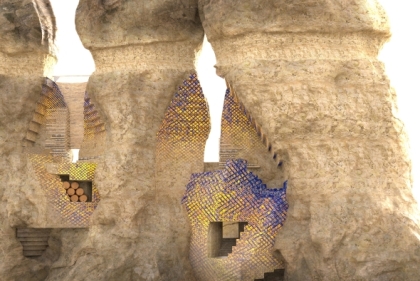
Stuart Weitzman School of Design 102 Meyerson Hall 210 South 34th Street Philadelphia, PA 19104
215.898.3425
Get Directions
Get the latest Weitzman news in your Inbox:
Phd / ms in architecture.
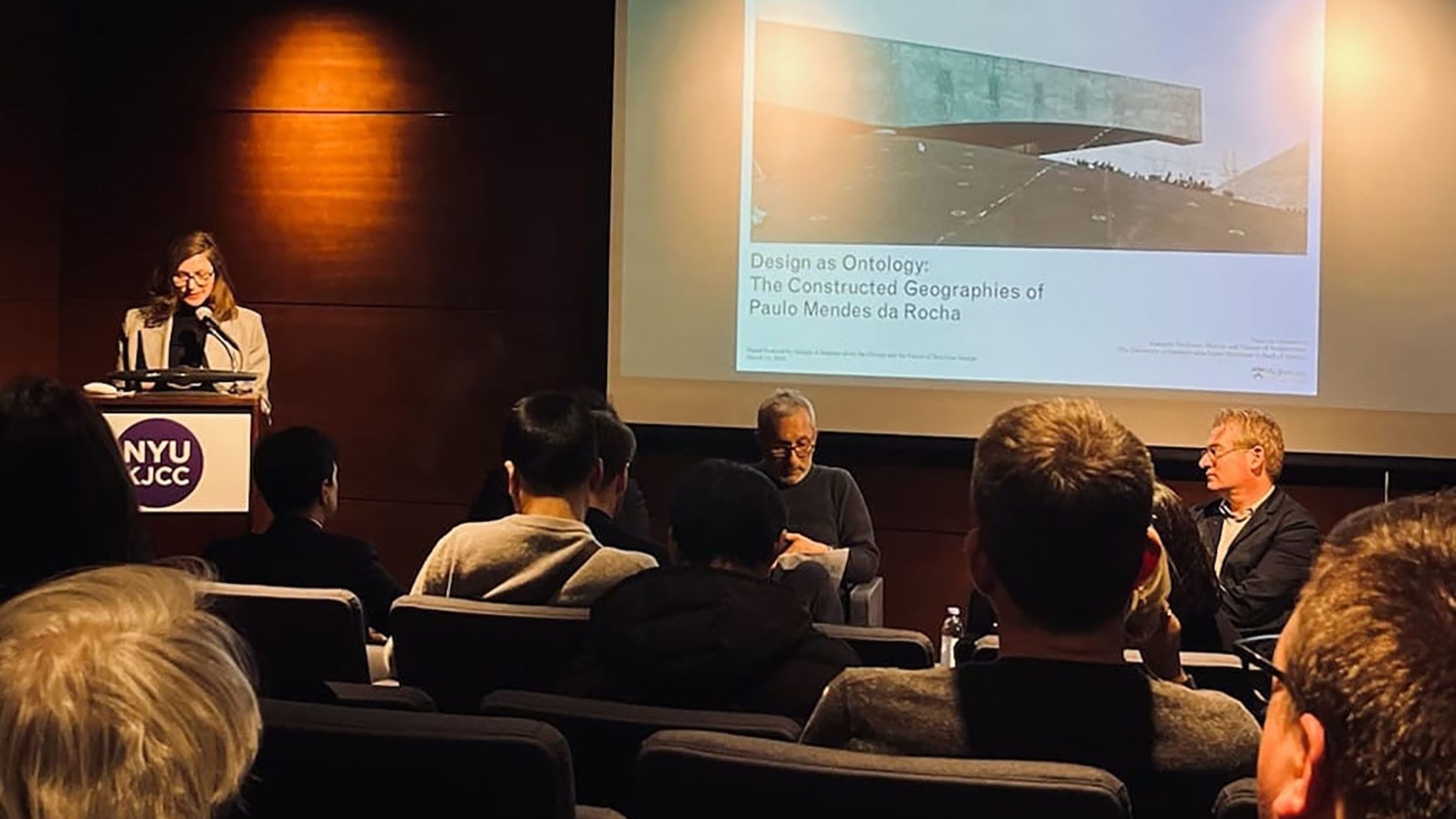
Welcome to the PENN Ph.D. and MS Programs in Architecture. Our graduate group faculty, candidates, students, and alumni welcome you to our website, eager to share with you their commitment to advanced research in architecture. Each in their own way seeks to cultivate knowledge, awareness, and invention in one of the oldest academic disciplines. Dedicated to thinking and making, as well as to critical questions and inventive solutions, the PENN Ph.D. and MS Architecture community invites you to join us.
Read a letter from the Chair
Degree Programs
The latest in phd / ms in architecture.
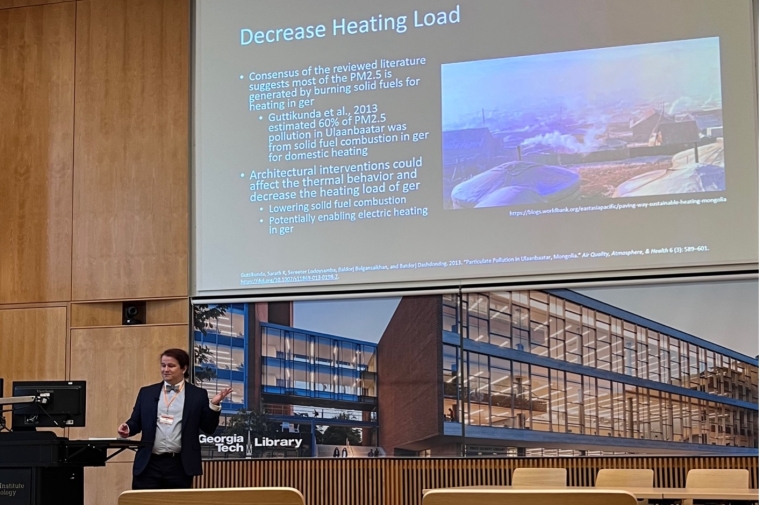
Meet the People of PhD Architecture
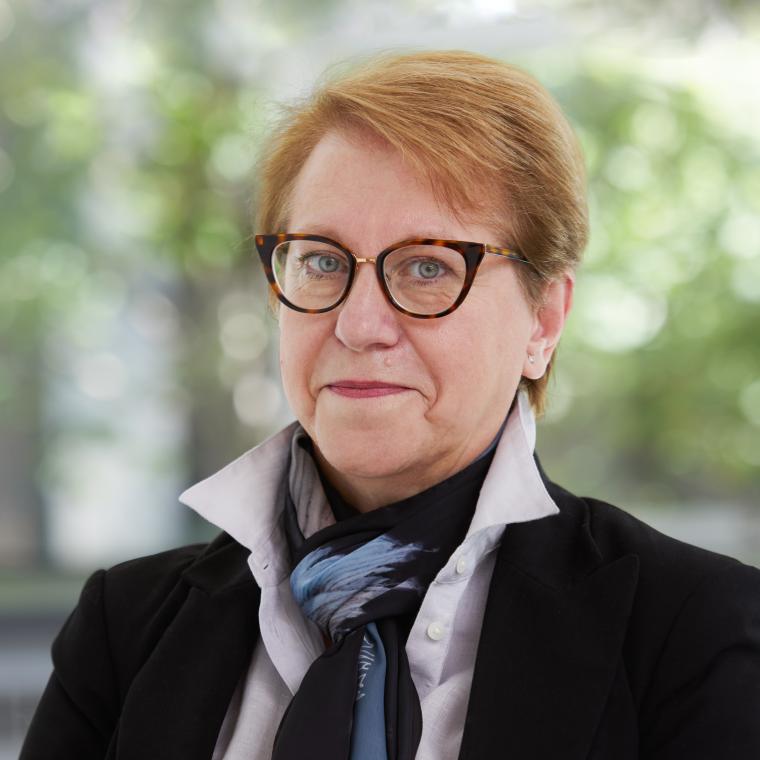
Dissertations
Dissertations in preparation.
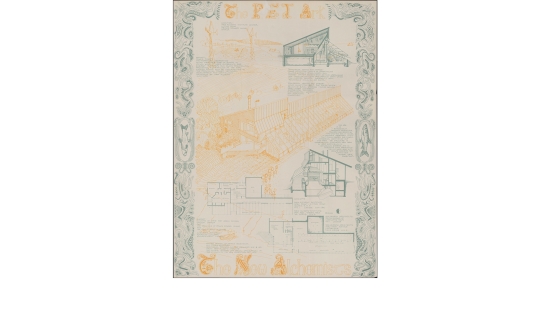
Dissertations Defended
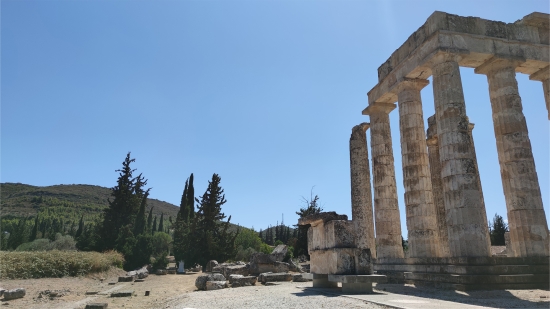
Past Events
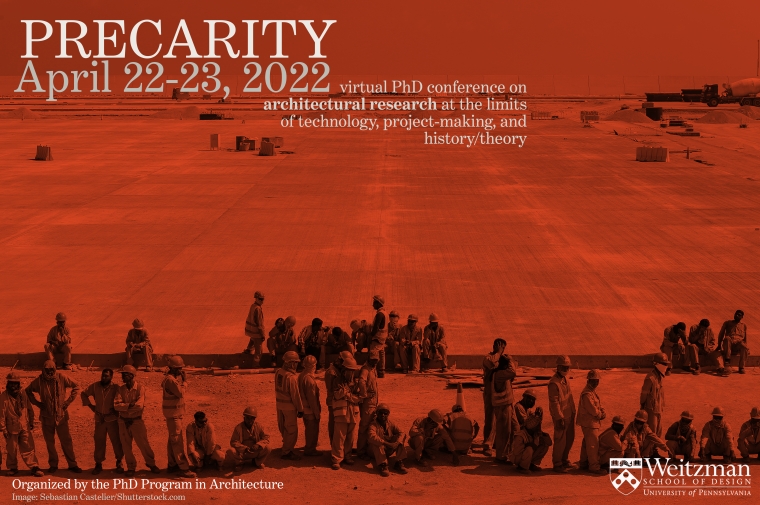

How to get a PhD in Architecture
Whether you’re at a crossroad in your professional career as an architect or in the middle of your BArch or MArch with some doubts on whether you want to practice architecture, pursuing a doctoral program in architecture might be an opportunity to still be involved with the world of architecture albeit not by practicing professionally. Pursuing a PhD in Architecture can easily be seen as a career shift since the point of getting a degree in architecture is to become an architect, however, there is another side to architecture that is less concerned with creating buildings and more on research, a route that can be as important and fulfilling. Nowadays, this can come in different forms of non-professional degrees, one of which is a Doctor of Philosophy in Architecture. In this article, I hope to provide some insight to those who are interested in doing research work in architecture.
A Doctor of Philosophy in Architecture is a relatively new addition to doctoral studies when put next to other fields in the humanities and sciences. At least in the United States, PhD’s in Architecture didn’t emerge until the 1970s. For example, Taubman College in Michigan , one of the first to offer a Doctor of Architecture, only started offering the degree in 1969 while Harvard did not introduce its degree until 1987. This delay shouldn’t come as a surprise since practicing architects have always been able to work in academia with a professional degree alone, leading to a discussion of whether the field of architecture even needed to have this degree. In fact, even the first generation who pursued these degrees continued to practice throughout their time in school. The PhD, however, did allow for architects and designers to more directly involve themselves in academia and have an impact there.
Ultimately, offering a non-professional degree in Architecture as high as a PhD birthed other non-professional degrees that we see today in schools. Alongside the MArch and BArch degrees, there are the MS degrees which are non-accredited degrees that provide studies on a specific research topic. For example, several schools around the United States, including USC , UPenn , and GSAPP , offer master's in historic conservation degrees that focus on historic architecture conservation research. Other concentrations include sustainable design, urban design, architectural history, and even real estate development. Although not required for accreditation, it’s a great opportunity for individuals who are passionate about a specific subject in architecture.
A prerequisite to start your PhD is to have a Master of Arts. This is typically already built into the PhD program itself and could take up to two years to complete. The Master of Arts degree is seen as a preparation for a PhD degree. Although built-in, you may still need to apply to enter the PhD degree once completed. Once you do enter, your years pursuing a PhD will depend on your chosen research. In architecture specifically, this can last between four to seven years. A second language (some institutions even require a third) is often a requirement while pursuing a PhD to be able to understand historical documents on a deeper level. The language depends on your chosen research, but typically they must fall within the modern languages.

The Application
Just like applying to your previous degrees, you’ll want to consider location since you’re expecting to be in school for several years. Most importantly, however, it’s vital to really dive into the school, the department where your PhD lies, and the faculty that is part of that department. In this level of academia within architecture, schools can define their architecture differently. Some schools don’t have a sole architecture department but rather, are integrated within another department such as arts and urban planning. Schools that do have an independent architecture department will also typically present specific tracks for studies. MIT for example has a History and Theory of Architecture track along with a History and Theory of Art. At UC Berkeley , they provide a PhD track of Building, Science, Technology, and Sustainability as a collective, also known as BSTS, and a track of History, Theory, and Society as a collective, also known as an HTS.
Furthermore, looking into faculty who are working on the same interest and passion as you are will be an important consideration as they essentially serve as advisors throughout your research. On top of these, you will have to take the GRE (a good amount of schools are waiving this even for PhD applications), an essay talking about what you're interested in researching and why, and recommendations from previous employers, faculty and so forth. PhD applications are typically due by the end of the year, but each school will vary in its specific dates.

Compared to paying a tuition fee in a professional degree such as BArch and MArch, pursuing a PhD relies on funding from grants and scholarship as research work can be seen as work in itself. The initial funding and conditions will vary from each school. The common thread, however, is that becoming a TA or even teaching a full course at the institution is a way to receive money while doing your research. Because PhD’s are primarily seen as a route towards academia (not always exclusively), this will serve as a great opportunity for those who are interested in practicing their skills in teaching. Just like any degree, outside scholarships and grants are opportunities for more funding and typically, this is seen as a way to avoid doing teaching jobs to focus on doing your research and writing a dissertation.
The Dissertation
If you have a BArch or MArch, you might already be familiar with the idea of a thesis. The dissertation is essentially going to be your thesis that you’ll be working on pretty much your whole time in your PhD. A dissertation is the main requirement for you to obtain your Doctor of Philosophy degree, typically a book-length research project which you would defend to a committee. Schools will go about this differently but nonetheless, expect to do a lot of reading and writing within your PhD degree to cultivate your research work.
Job Prospects
A Doctor in Philosophy is the main way to get into academia. There is still a lot of debate on what kind of professionals should be teaching studios and seminars in architecture schools, nonetheless, you will find an array of schools that provide some sort of architectural study to students, lying in different places within the spectrum of the built work and the historical theory work. Another route to consider would be a job at a research institution focusing on the arts and culture such as museums as they can also provide openings due to architecture falling within the humanities. Ultimately, the point of a PhD is to be able to have the space and time for an individual to research a topic which that individual feels passionate about and believes to be an important topic. This specificity can lead towards a more specialized workforce, whether that is in academia, the arts, or even urban planning.
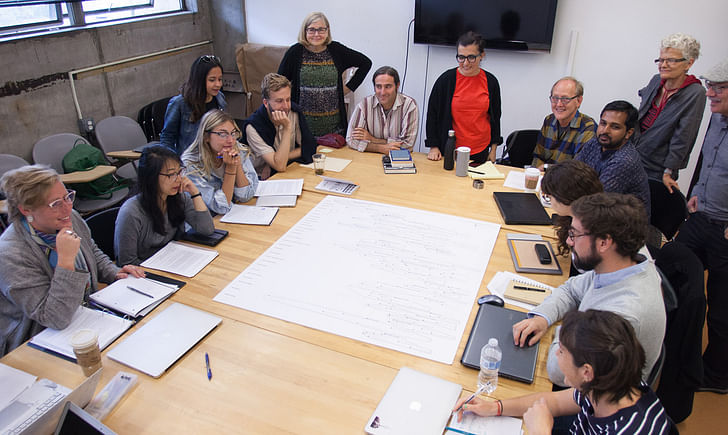
Because architecture is mainly a practicing profession, doing research work can be an anomaly. However, this is not to say that the work cannot have value in the world of architecture. Architecture can live through different mediums — from living in the built environment to existing in a piece of writing. Regardless of which medium you resonate the most with, it’s important to remember that executing your interests and passions can spark and inspire ideas, and architecture should continue cultivating a diverse set of thoughts. So if you have a passion for a certain topic, find ways to cultivate it. Whether it be by building something or writing about it.
Similar articles on Archinect that may interest you...

About the Author
Lance Arevalo

22 Comments
APRIL 6, 2021 | 3:00PM ET / 12:00PM PT
"Expanding the View into Post-Professional Degree Programs"
https://www.acsa-arch.org/webi...
great and awesome idea !
I see more unplayable student loans in someone future. Focus on helping current professionals make more money. Creating more elite intellectuals does not help.
thisisnotmyname
"Typical funding for the doctoral degree includes four years of full funding (tuition fellowship, benefits, and stipend based on a Graduate Student Instructorship or a Graduate Student Research Assistantship) and two additional years of tuition only fellowship (TOF) with benefits, if required. "
I knew a few PHDs from UMich, they didn't have to pay anything. You might be projecting.
phd programs are almost always 100% funded, with a stipend on top.
now, is a phd in architecture a necessary degree? still debatable- i wasn't aware how new this type of degree is in architecture.
It's a jumping off point to get deep into research or academia. People aren't doing this to go do the same thing as all the MArchs and BArchs. With that in mind, I would say it's a great approach if that is your intent.
Nam Henderson
i'm speaking more about the broader philosophical debate about the nature of the degree.. i think prior to the 70's, what was common was an art history phd with a focus in architecture, which i think there is plenty of argument in it being sufficient enough.
A PhD in architecture is great, but only if there are available teaching slots open. Though it goes back to the larger point where architecture expertise should be valued more in media, government, etc. Biden's about to pass a 3 trillion dollar infrastructure bill with no apparent design vision -- just a lot of economist BS. Meanwhile there are no popular critics left, and the few venues left are keen to pretend like the McMansion lady has something interesting to say.
JJArchitect
PhD acronym 'piled high and deep'
DesignGnome
One of the offices I worked at has an office in Honolulu, many of my co-workers there have PHDs in arch
Context is key. University of Hawaii has a professional DArch degree. It is very different than the other Arch PHDs as far as I understand.
Yea, don't do this unless you want to struggle to find a middling academic job. Even if the doctorate is heavily subsidized, this is a complete waste and will no way help you in your architectural business. On top of it, they put the most bizarre, out of touch professors in this sector - or you are learning on you're own / in thesis mode - which you could do without being a PHD student.
Just a reminder to those in college thinking about pursuing this degree path - a PhD in Architecture - if you bypass getting licensed (per NCARB and State Board requirements) to obtain your PhD and take a career path in academia, it is illegal to call yourself an 'Architect' in the U.S. Please don't confuse the two.
I mean, if you just don't get licensed regardless of what you do in academia technically it's illegal... Unless you work in IT ;D Anyway, the two things are entirely unrelated, you can get a PHD and conceivably still get licensed, you could get a MArch and not get licensed. I know there are a lot more unlicensed MArchs out there calling themselves Architects than PHDs calling themselves architects. This seems like a rather non-problem.
My comment was directed more to those in the age bracket I often mentor (high school students and college students) looking to become licensed Architects. Many of them are always looking for the least path of resistance to become licensed Architects - merely providing clarity the article did not address. Designers/people misrepresenting themselves as or doing work as 'Architects' is an issue - Google how state Architecture boards are cracking down on people misrepresenting themselves as 'Architects'. One of the states I'm licensed in issues rulings and legal cases each month the State brought against designers/people working as or misrepresenting themselves as 'Architects'. The cases often end in hefty fines and/or in extreme cases more punitive legal ramifications for the individuals.
Am curious as to how the profession protects the term 'Architect' but doesn't really work to heighten the terms standing in the world. Most clients are happy with a designer, developer, planner or interest to do most of the work, perhaps getting an architect to stamp when necessary. All of this does little for the 'Architect' as it was understood by Frank Lloyd Wright or anyone else.
J D J... That's fair. Getting a doctorate is definitely not least path of resistance though. As for the legal actions. I also see that in the state I am licenced in, but it's almost exclusively for people who have represented themselves as architects for the purpose of performing architectural services. Which, is of course illegal and the main point. However, I have also know hundreds of recent grads and young professionals who refer to themselves as "architectural designers" or something like that, which is illegal and they technically know it.
My favorite is the Honorary Doctorate.
Dr. Sean "P. Diddy" Combs
Dr. Aiec Baldwin
Dr. Robert DeNiro
Dr. Conan O'Brien
Dr. Usain Bolt
Dr. L.L. Cool J
Dr. William Shatner
Odd, nothing in the alphabet letter salad following J Daniels Jenkins name above indicates that he is an architect.
wrong- aia indicates licensure vs assoc aia.
By the way, Harvard began its Ph.D. in Architecture program in the 1900s.
Block this user
Are you sure you want to block this user and hide all related comments throughout the site?
This is your first comment on Archinect. Your comment will be visible once approved.
- Back to Features List... Back to Top ↑
- » Architectural Issues
- » Culture
- » Architects
- » Design
- » Academia
- ↓ More
- » Buildings
- » Business
- » Employment
- » Technology
- » Film/Video/Photography
- » Urban Planning
- » Sustainability
- » Events
- » Landscape
- » Web
- » Competition
- » Furniture
- » View All
- × Search in:
- All of Archinect
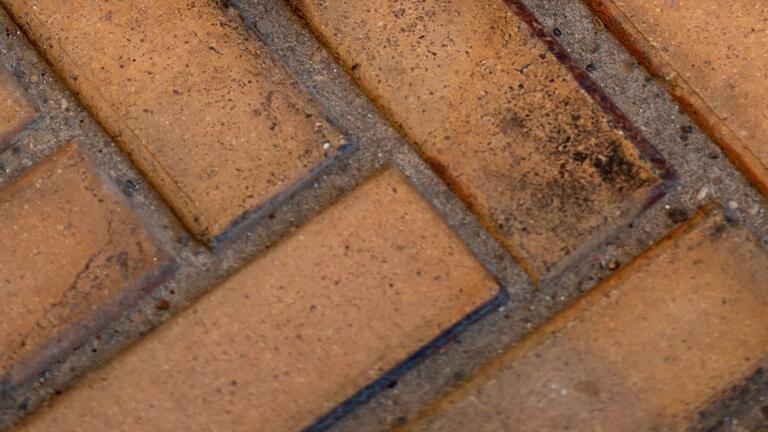
Ph.D. in Architecture
The PhD in Architecture (PhD-Arch) program at Carnegie Mellon advances interpretive, critical and contextual perspectives on the built environment and spatial design. The program offers students an interdisciplinary platform to investigate built environment cultures, practices and politics across a range of historical and geographical contexts.
Nida Rehman
Assistant Professor & PhD-Arch Track Chair

Program Overview
The PhD in Architecture (PhD-Arch) program at Carnegie Mellon advances interpretive, critical and contextual perspectives on the built environment and spatial design. Bringing together methods in history of architecture, urban studies, critical spatial practices, environmental humanities, digital humanities, environmental justice and community-oriented research, the program offers students an interdisciplinary platform to investigate built environment cultures, practices and politics across a range of historical and geographical contexts.
The intellectual foundation of the program is informed by Carnegie Mellon Architecture’s commitments to racial and spatial justice in architectural epistemology, pedagogy and practice. The program builds on and extends the foundational work in the school in the area of community-oriented urban design and research and is supported by the wide-ranging expertise and resources in the school and across the university, particularly in the arts and humanities.
Admission Information
Program Curriculum
Learn more about the PhD-Arch curriculum below.
PhD-Arch Curriculum
Program Faculty
For more information about the PhD-Arch program, please contact track chair Nida Rehman .
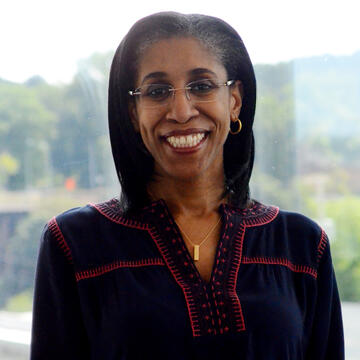
Erica Cochran Hameen
Assistant Professor, DEI Director & DDes Track Chair
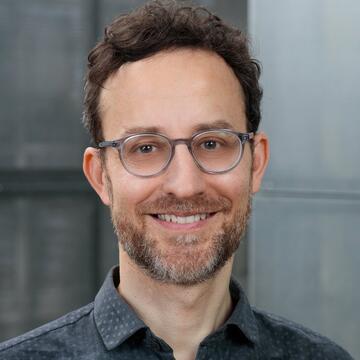
Stefan Gruber
Associate Professor, MUD Track Chair & RCI Director
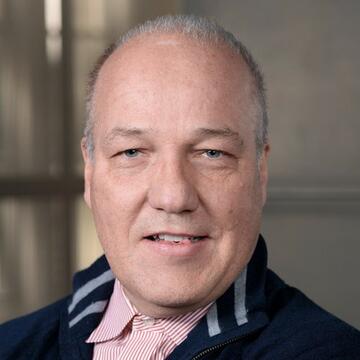
Kai Gutschow
Associate Professor & Associate Head for Design Ethics
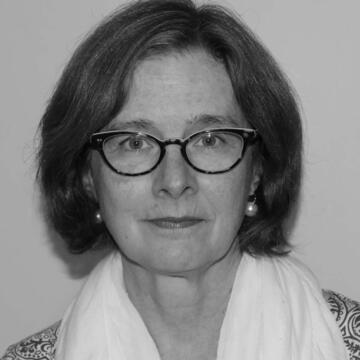
Associate Professor
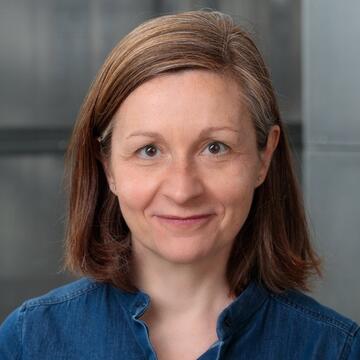
Francesca Torello
Special Faculty
Admissions Resources
Are you a current student looking for resources? Handbooks, procedures and other information can be found on the Student Resources page .
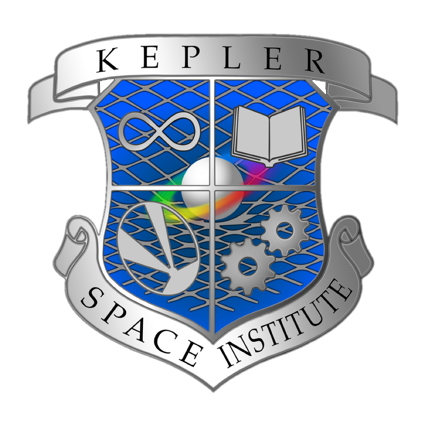
Space Programs
Masters degrees, graduate certificates, space education, space research, masters degrees.

Master of Science Degree Programs
The Master of Science (M.S.) Degree is an interdisciplinary program providing opportunities for those interested in advancing the development of Human Space Exploration and Space Settlements. The M.S. Program features coursework, research training, and collaborations with faculty in a research-led culture emphasizing rigor, creativity, and innovation. Students will join industry leaders to help guide the sustainable development of Space, and with the support of commercial and international partners will conduct impactful research in space-related fields to enable human expansion from Earth to Space.
PROGRAM OPTIONS
Master of Science Degree (M.S. THESIS-BASED)
Master of Science Degree (M.S. PROJECT-BASED)
Master of Science Degree (M.S. COURSE-BASED)
Master of Science Degree (M.S. CO-OP BASED)

M.S. in Space Studies
The objective of the M.S. program is to provide graduate students, who have that developed a high level of knowledge in the field of human space exploration, with expertise in specific aspects of space studies, space settlements, space systems. R&D in space science, and excellence in writing and oral communication. M.S. graduate will possess a strong foundation on which they can be highly successful in science-related positions in government, industry, and other institutions, or carry out high quality research at the PhD level. Graduates of the program go on to become the future stewards of their discipline. They will generate knowledge and contribute to the future of space exploration.
The M.S. in Space Studies program guides students through the challenges of space exploration. The program provides opportunities for those interested in space engineering, science, policy and ethics related to human space settlement. Students examine key methods and strategies for human spaceflight, planetary exploration, commercial and scientific aspects of space exploration, mission planning and design, remote sensing satellites, astronomical instrumentation, robotics, human factors, risk management and other technologies to enable the development of space settlements.

M.S. in Space Agriculture
The objective of the M.S. program is to provide graduate students, who have that developed a high level of knowledge in the field of human space exploration, with expertise in specific aspects of space studies, space settlements, space systems,R&D in space science, and excellence in writing and oral communication. M.S. graduate will possess a strong foundation on which they can be highly successful in science-related positions in government, industry, and other institutions, or carry out high quality research at the PhD level. Graduates of the program go on to become the future stewards of their discipline. They will generate knowledge and contribute to the future of space exploration.
The M.S.in Space Agriculture program guides students through key areas related to agriculture in space. The program investigates thechallenges ofcrop production incontrolled environments, effective management of ecosystems, and the evolution of agri-food systems in space-based mission architectures.Students learn to be active problem solvers focused on long-term solutions for human space settlement and drive the development of alternative agricultural systems for sustainable production for communities in space.

M.S. in Space Architecture
The objective of the M.S. program is to provide graduate students, who have that developed a high level of knowledge in the field of human space exploration, with expertise in specific aspects of space studies, space settlements, space systems, R&D in space science, and excellence in writing and oral communication. M.S. graduate will possess a strong foundation on which they can be highly successful in science-related positions in government, industry, and other institutions, or carry out high quality research at the PhD level. Graduates of the program go on to become the future stewards of their discipline. They will generate knowledge and contribute to the future of space exploration.
The M.S. in Space Architecture program guides students through the challenges of designing and building inhabited environments in outer space. The program considers the complexities of sustainable design at multiple scales for continuous human habitation in extreme conditions, ranging from energy-efficient systems to development of space infrastructure. Students explore advanced space architecture to assess the key issues of establishing human space settlements.

M.S. in Space Health
The M.S. in Space Health program guides students through the challenges to human health while living and working in space. The program provides opportunities for those interested in the health and well-being of space communities to support the achievement of long-duration space missions. Students examine key methods and strategies on identifying, monitoring, and prevention strategies to minimize the impact of the space environment on human health that will enable humanity to thrive beyond Low Earth Orbit.

M.S. in Space Operations
The M.S. in Space Operations program guides students through the issues associated with the planning, operation launch, and management of space systems. This program guides students through sustainable space operations, space systems requirements and design specifications, payload and mission support, and space systems analysis in the global environment of the space industry. Students will gain an understanding of the technical, strategic and economic drivers required to conceive, design, and operate systems within the rapidly changing space sector.

M.S. in Planetary Science
The M.S. in Planetary Science program guides students through the physics of planetary and space environments, including planetary surfaces and sub-surfaces, atmospheres and magnetospheres for planets within our solar system and extrasolar planets. The program offers students the opportunity to investigate the formation of the solar system and other planetary systems by examining the physical and chemical processes that shape planets and celestial bodies. Students will gain an understanding of planetary systems, solar-system bodies, and their individual and collective evolutionary histories.

M.S. in Space Resources
The M.S. in Space Resources program guides students through the evolving challenges of the responsible use of available resources in the Solar System. The program focuses on the identification and management of space resources, including the advancing the development of science and technologies related to extraction, processing, and manufacturing in space. Students explore novel mission architectures that may be enabled by utilizing resources in space.

M.S. in Space Science
The M.S. in Space Science program guides students through the challenges of addressing evolutionary systems for multigenerational success in space settlements. This program takes an interdisciplinary approach to examine the balance of dynamic processes to enable life to flourish in space, focusing on expansion of life support systems, influence of climates and weather conditions, and preservation of resources for generations to follow. Students will gain an understanding about the effects of gravity, interrelationships between celestial bodies, climate cycles, and the impact of human activities on a universal scale.

M.S. in Space Systems
The M.S. in Space Systems program guides students through the processes and methods of vehicles and infrastructure working together to perform tasks in the space environment. This program guides students through the fundamentals of systems engineering as applied to space systems. Students will gain an understanding of development of space systems and subsystems, techniques and methodologies for scientific analysis and management across operations on Earth and in space, electronics, mechatronics, software, and controls, along with risk assessment and mitigation planning.
GRADUATE CERTIFICATES

Graduate Studies
Our online programs encompass focused Interdisciplinary Space Studies, graduates will join industry leaders to help guide the sustainable development of Space, and with the support of commercial and international partners will create employment opportunities and enhance the expertise of global citizens to benefit society.
To be awarded a Graduate Certificate, students must take four courses. Three courses must be taken within the desired Graduate Certificate program. The fourth course may be taken as an elective from any of the Graduate Studies Programs.

Human Factors for Space Settlement
Students enrolled in this Graduate Certificate program will examine human factors for space settlement, taking into consideration the unique challenges posed by long-term space travel and human habitability in the hazardous space environment. This program is designed to familiarize students with space settlement concepts, functions, and experiences focusing on application and development of related systems to improve safety and advance the performance of equipment, spacecraft design, procedures, health and nutrition. An emphasis will be placed on human centered design systems, related to but not limited to: psychology, perception performance limitations and errors, the human experience and simulations in mixed reality environments, and the evolving impacts of anthropometrics, biomechanics and ergonomics of human effectiveness.

Space Commercialization and Entrepreneurship
Students enrolled in this Graduate Certificate program will study the economic drivers of sustainable space settlement and commercialization of space exploration addressing industry opportunities. This program examines exploration enterprises in development, launch, operations and disposal to develop mechanisms to drive innovation through technological advances, facilitating social benefits, scientific progress, and breakthroughs in satellite applications.
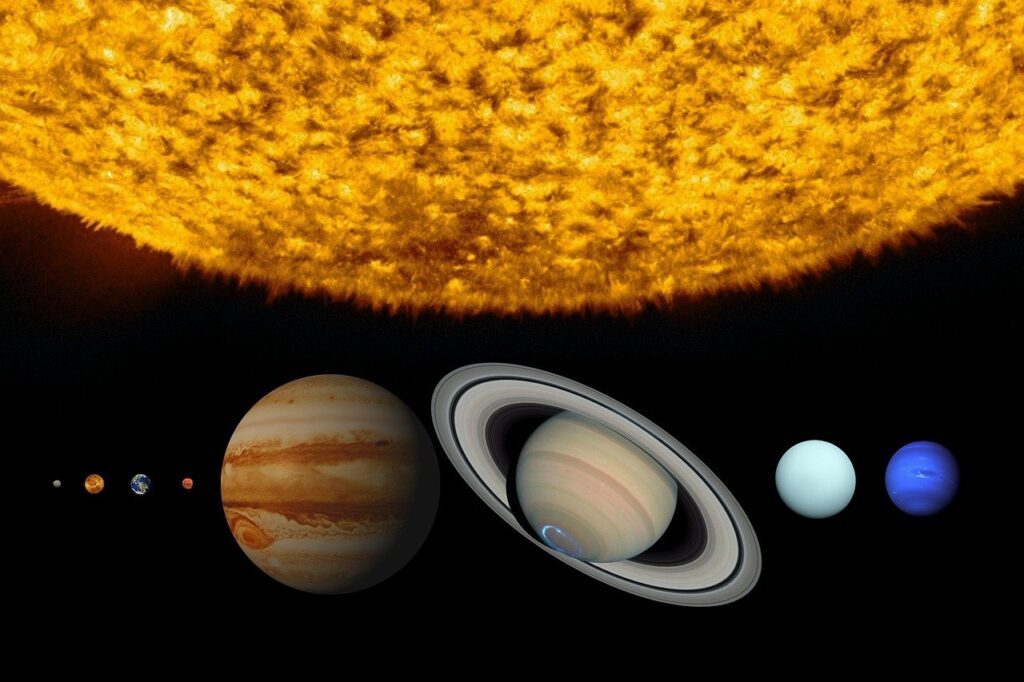
Leadership, Policy, and Governance
Students enrolled in this Graduate Certificate program will study and analyze evolving challenges in the private/public space programs regarding policy perspectives, social structures, and governance models. Students will survey existing international legal and regulatory frameworks for space activities and establish new models and frameworks for the effective performance of stakeholders for long-term sustainable use of space.
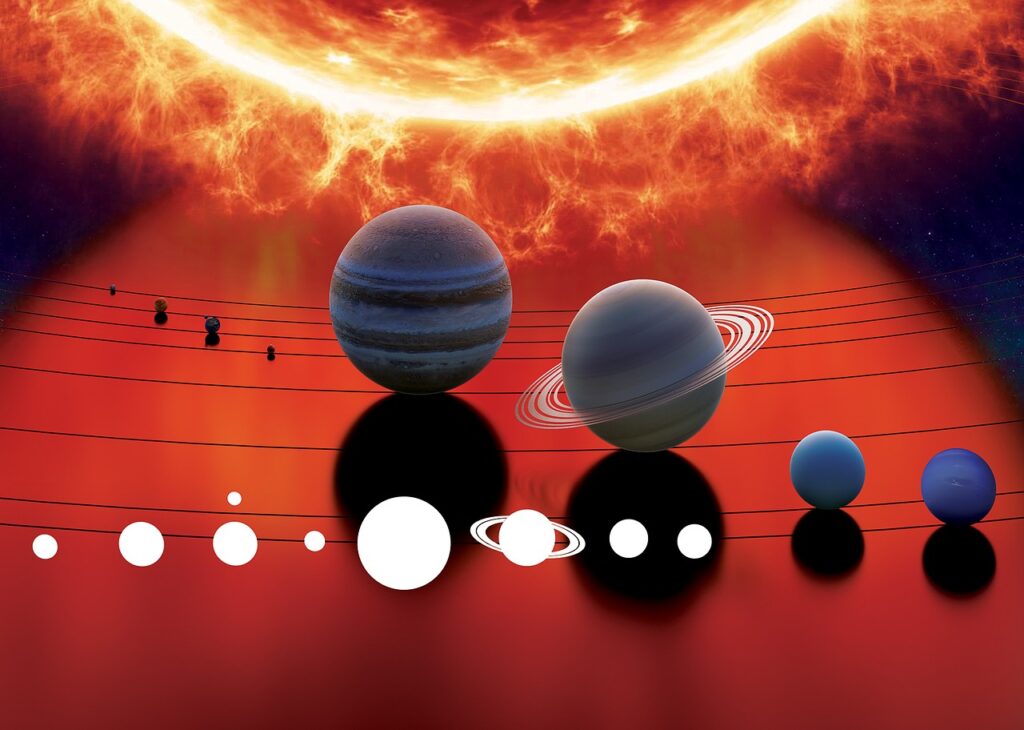
Space Infrastructure and Sustainable Exploration
Students enrolled in this Graduate Certificate program will investigate technologies to develop space infrastructure and sustainable exploration of the solar system and beyond. This program is designed to guide students through methodologies of building space infrastructure, remote sensing, space science, space management and operations. In addition to exploring the development of a broad set of space systems, students will delve into surveying supporting systems for space settlement and roadmaps for technological growth and expansion.

Space Philosophy and Theory
Students enrolled in this Graduate Certificate program will study and explore such questions as: What should be the philosophical foundation for the future of humans in space? What beliefs and values will drive humans in space settlements? What are the possible futures for humankind if it remains on Cradle Earth and the implications of human settlement beyond? Students will be exposed to historical perspectives of philosophy, ethics, metaphysics, and epistemology, as well as other topics central to understanding humankind’s journey to living and working in space.

Students enrolled in this Graduate Certificate program will study the evolving contemporary issues in education that impacts research, policy, and practice. This program takes an interdisciplinary approach and emphasizes collaboration, investigation of novel educational systems and capacity building in space settlements. In addition to gaining a core foundational knowledge in theory, methods and research in education, students will address a range of domains including: human development, equity, learning and teaching, equality and justice, communities, institutions and societies on Earth and settlements in Space.

Space Technology and Engineering
Students enrolled in this Graduate Certificate program will establish a foundation in space systems, integrated design methodologies, and interdisciplinary engineering sciences. This program guides students through identifying trends, requirements, develop strategies, and implement innovative solutions driven by technological advancements to enable future space settlements. Students will learn to think critically and gain valuable experiences in applying research and problem-solving skills to evaluate, analyze, and improve processes.

Space Architectural Technology
Students enrolled in this Certificate Program will study the theory and practice of designing and building inhabited environments in outer space. This program is designed to guide students through architectural design of humans living and working environments in space. Students will gain an understanding about designing these forms of architecture and the challenges to ensure and support safety, sustainability, habitability, reliability and crew efficiency, productivity and comfort in the context of extreme environments.
SPACE EDUCATION

Kepler offers a wide range of dynamic and immersive space programs designed specifically for students. These programs provide a unique opportunity to delve into the captivating world of space exploration and gain hands-on experience in various disciplines. Through interactive workshops, simulations, and engaging lectures delivered by renowned experts, students will acquire a solid foundation in space science, technology, engineering, and related fields. These programs foster critical thinking, teamwork, and problem-solving skills, empowering students to become the next generation of space leaders.

Kepler’s graduate studies program is tailored for individuals seeking advanced education and specialization in space-related fields. With a focus on interdisciplinary research and collaboration, the program offers a diverse range of areas of study, including astrophysics, planetary sciences, space engineering, space policy, and more. Students engage in advanced research projects under the guidance of esteemed faculty, contributing to the advancement of knowledge and pushing the boundaries of space exploration. The program provides a nurturing and intellectually stimulating environment that fosters innovation, critical analysis, and leadership development.

Research Projects
At Kepler, research is at the core of our mission. Through our research projects, students and faculty have the opportunity to explore fascinating and impactful areas of space science and technology. From studying celestial bodies and cosmic phenomena to developing novel space technologies and instruments, research projects offer an avenue for discovery and innovation. Students are actively involved in experimental design, data collection, analysis, and publication of their findings. These projects not only contribute to the advancement of scientific knowledge but also cultivate valuable research skills and instill a passion for exploration and discovery.


Internships
Kepler’s internship programs provide students with invaluable hands-on experience in real-world space-related settings. Through collaborations with leading space agencies, private companies, and research institutions, students have the opportunity to work alongside professionals in various fields, including engineering, mission planning, space medicine, and more. Interns gain practical skills, industry insights, and networking opportunities that enhance their career prospects and deepen their understanding of the challenges and opportunities in the space sector. These internships are a stepping stone to a successful and fulfilling career in the space industry.

Co-op Placements
Kepler’s co-op placement programs offer students the chance to engage in extended work experiences in the space industry while pursuing their academic studies. These placements typically span several months, allowing students to immerse themselves in a professional work environment and contribute to meaningful projects. Co-op students work closely with industry professionals, gaining exposure to real-world challenges and applying their academic knowledge to practical applications. These experiences provide students with a competitive edge, valuable industry connections, and a deeper understanding of the intricacies of the space sector. Co-op placements offer a bridge between academia and the workforce, preparing students for successful careers in the space industry.
SPACE RESEARCH

Kepler stands at the forefront of groundbreaking space research, leading the charge in advancing our understanding of the universe and pioneering innovative solutions for the challenges of space exploration and habitation. With a diverse team of renowned scientists, engineers, and scholars, we are dedicated to pushing the boundaries of knowledge of how humans will live and work in space.
Our research endeavors span a wide range of disciplines, encompassing astrophysics, planetary sciences, space technology, robotics, life sciences, space medicine, and beyond. At Kepler, we believe in the power of interdisciplinary collaboration. Our researchers work hand in hand, combining expertise from various fields to tackle complex problems and spark new insights. This collaborative approach fosters synergy, promotes innovation, and enables us to address multifaceted challenges with comprehensive solutions.
Through our research initiatives, we are actively engaged in projects that have far-reaching implications for humanity’s future in space. From designing advanced propulsion systems for interplanetary travel to developing sustainable habitats for long-duration space missions, our scientists are at the forefront of innovation, driving forward the frontiers of human space exploration.
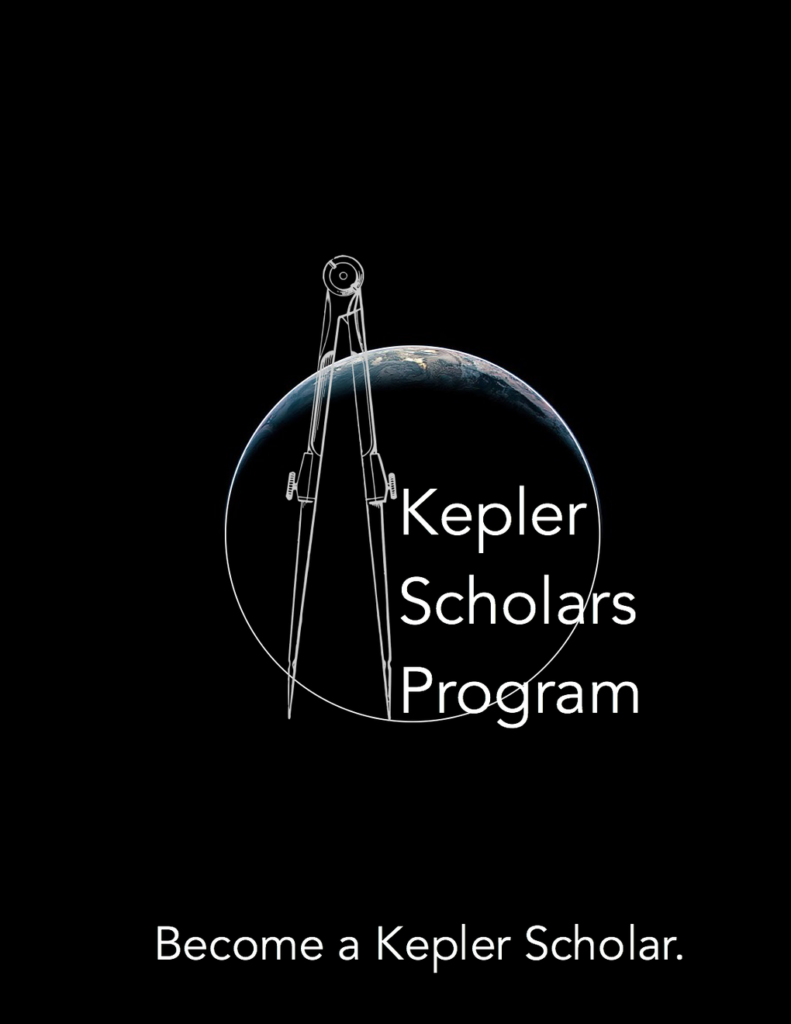
Kepler Scholars
The Kepler Scholars Program is looking for scholars to support research and development supporting the expansion of human civilization from Earth to space. We are recruiting exceptional people with a passion for space exploration. We provide education in science, engineering, or medicine and to develop new knowledge and experience in pioneering fields of research related to human living and working in space.
We are looking for explorers, tinkerers, and innovators who are research savvy – pioneers who love to dive deep into the numbers but who can also take a step back from them and think about the big picture. Kepler Scholars are motivated individuals who are curious about the issues that matter most to our society, and pursuing excellence bridging their passions and academic pursuits to bring a meaningful contribution to the migration of humans into space.

Space Settlements
Space settlements, envisioned as self-sustaining communities beyond our home planet, are designed to support human life and foster scientific, technological, and cultural advancements. They offer a unique environment for innovation, collaboration, and the pursuit of knowledge, pushing the boundaries of what humanity can achieve.These future settlements, whether on the Moon, Mars, or in orbital habitats, will be testaments to human ingenuity, showcasing our ability to thrive in extreme environments and adapt to the challenges of space. They will serve as stepping stones for further exploration and provide invaluable insights into sustainable living, resource utilization, and long-duration space missions.
Imagine a world where researchers, scientists, engineers, and artists from around the globe converge in these cosmic havens to unlock the secrets of the universe. From groundbreaking scientific experiments to the creation of awe-inspiring works of art, space settlements will become hotbeds of creativity, fostering interdisciplinary collaborations that transcend traditional boundaries. Furthermore, space settlements hold immense promise for addressing some of the most pressing global challenges we face on Earth. They provide opportunities to pioneer sustainable technologies, harness renewable energy sources, and develop innovative solutions for food production, water management, and waste recycling. Lessons learned in space settlements can be applied back home, paving the way for a more sustainable and resilient future for our planet.

Training & Development
We offer a wide range of comprehensive and innovative training and development programs designed to equip aspiring space professionals with the skills, knowledge, and mindset needed to thrive in this exciting frontier. Our programs cover diverse areas of expertise, including space exploration, engineering, astrophysics, planetary sciences, space law and policy, space medicine, and much more. Whether you are a recent graduate, a seasoned professional seeking a career shift, or an enthusiast eager to delve deeper into the mysteries of the cosmos, we have a program tailored to meet your specific needs and aspirations.
At Kepler, we pride ourselves on delivering cutting-edge curriculum taught by leading experts in their respective fields. Our faculty consists of esteemed researchers, accomplished practitioners, and industry pioneers, ensuring that you receive the highest quality education and training. You will have the opportunity to engage in hands-on projects, simulations, and internships that provide practical experience and prepare you for the rigors of real-world space missions and operations.
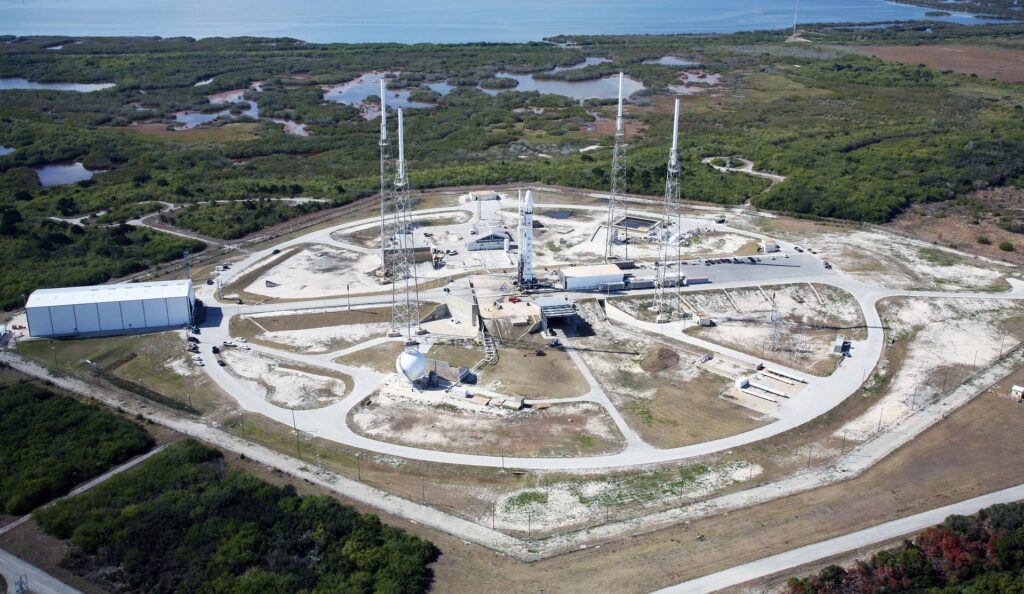
Publications
The Journal of Space Philosophy (JSP) is a prestigious publication dedicated to advancing the field of space philosophy and fostering insightful discussions on the philosophical implications of human exploration, settlement, and activities in space. As an esteemed platform for intellectual exchange, the JSP invites scholars, researchers, and thinkers from diverse disciplines to contribute their groundbreaking research and thought-provoking perspectives.
The JSP serves as a catalyst for expanding the horizons of our understanding of the philosophical dimensions of space exploration. It offers a unique opportunity for scholars to delve into profound questions related to the nature of human existence, our place in the universe, ethical considerations of space exploration, the impact on society and culture, and the profound implications for our collective future.
The JSP welcomes a wide range of submissions, including original research articles, review papers, commentaries, and book reviews. It embraces interdisciplinary perspectives that bridge the realms of philosophy, astrophysics, planetary sciences, anthropology, ethics, sociology, and more. Whether you are a seasoned philosopher or a budding researcher, the JSP provides a platform to share your unique insights and contribute to the collective knowledge in this dynamic field.
GRADUATE ADMISSIONS
At Kepler, we welcome motivated and passionate individuals to join our graduate programs and pursue advanced studies in the field of human space exploration. Our rigorous admissions process ensures that we select candidates who demonstrate exceptional academic potential, research aptitude, and a genuine commitment to advancing the frontiers of space science and technology. To apply, please submit your completed application along with the required documents, including transcripts, letters of recommendation, a statement of purpose, and any additional program-specific requirements. We look forward to receiving your application and considering you for a place in our esteemed graduate community.
TRANSFER TO KEPLER
Thinking of transferring to a university where your dreams of space exploration can take flight? Kepler Space Institute welcomes transfer students from other institutions who are looking to transition to the space industry Our transfer admissions team is dedicated to ensuring a smooth and seamless transition for transfer students, evaluating your previous coursework and experience to determine the transferable credits that will count toward your degree.
TUITION & FEES
We understand the importance of accessible education. While our programs offer unparalleled opportunities and resources, we are committed to keeping tuition and fees reasonable and transparent. Our tuition structure is designed to reflect the exceptional quality of education and the comprehensive support services we provide to our students. We encourage you to explore our website or contact our admissions office to learn more about the specific tuition and fee details for your desired program. Additionally, keep in mind that Kepler offers various scholarships, grants, and financial aid options to assist eligible students in funding their education.
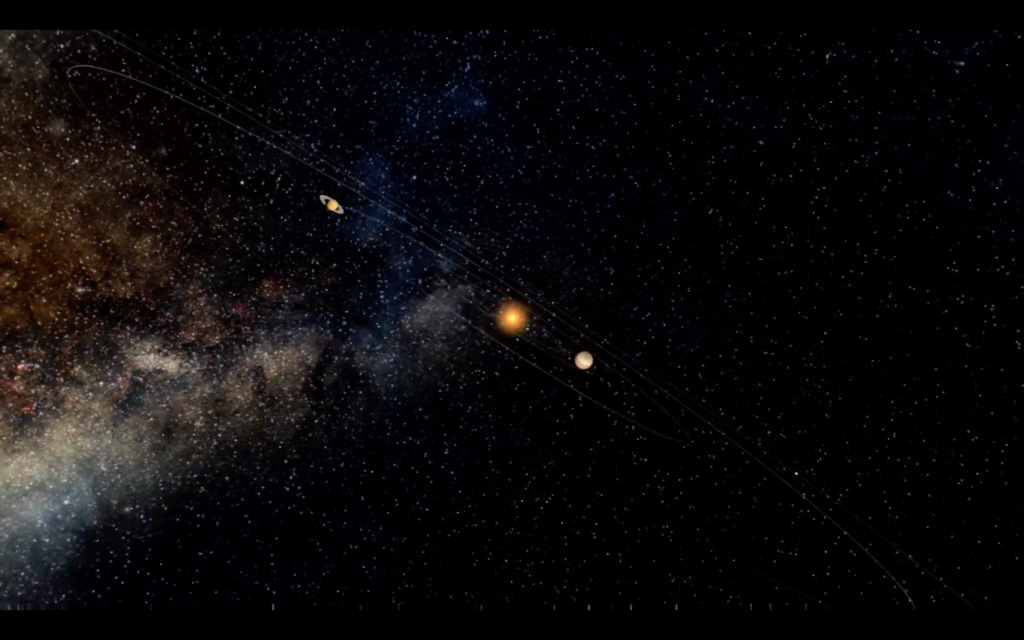
FINANCIAL AID
We believe that financial barriers should never hinder a student’s dreams of reaching for the stars. We offer a range of financial aid options to help make your space education affordable and attainable. Our dedicated financial aid team is committed to assisting students in navigating the various financial aid programs, scholarships, and grants available. We encourage you to explore the options and eligibility requirements on our website or contact our financial aid office for personalized guidance and support. Together, we can ensure that your financial circumstances do not limit your ability to pursue an education and contribute to the future of space exploration.
Degrees & Programs
Journal of space philosophy, the arcs of excellence, archives and special collections, degrees and programs, explore a wide variety of degree programs in space sciences and related fields., enjoy the flexibility of online learning to suit your schedule and lifestyle., learn from engaging faculty who are experts in space exploration and research., our curriculum keeps you up-to-date with industry advancements., gain practical hands-on experiences and internships for real-world application., benefit from our strong alumni network and career support services for future opportunities., journal of space philosophy, dive into captivating articles exploring the philosophical dimensions of space sciences., discover thought-provoking insights and discussions on the implications of space exploration., showcase your research by submitting your work to this prestigious scholarly publication., join a community of scholars passionate about exploring the philosophical aspects of space., kepler scholars, develop new skills and pursue your passion, contribute to the future of human space exploration, benefit from mentorship and networking opportunities with renowned experts., gain access to specialized resources and unique research opportunities., collaborate on exciting projects with industry partners, space agencies, and research institutions., explore innovative projects with real-world applications, contribute to ongoing research projects and gain valuable hands-on experience., connect with a vibrant research community dedicated to the expansion of humanity from earth to space, the arcs of excellence, benefit from advanced technologies, resources, and funding for your research initiatives., conducting pioneering research to benefit all members of spaceship earth., engage with dedicated research centers focused on various aspects of human space exploration., collaborate across disciplines with fellow researchers, fostering shared expertise., archives and special collections, discover a curated collection of historical documents, artifacts, and resources related to space exploration., explore special collections highlighting the contributions of renowned space pioneers., immerse yourself in the rich legacy and milestones of space exploration., engage with archival materials and contribute to ongoing documentation efforts., future explorers, prospective students, current students, faculty & research, partnering for impact, space islands, information applicable to graduate studies programs, program completion.
To be awarded a certificate, students must successfully complete four courses for a total of twelve hours of course credit. To be awarded a master’s degree, students must successfully complete twelve courses for a total of thirty-six hours of course credit.
Program completion dates are determined by the student’s course enrolment schedule and pace.
Class schedules, times, and dates are included in the course registration materials found atwww.KeplerSpaceInstitute.com. Specific information about course registration dates can be found in the Academic Calendar.
Academic Calendar
Spring Semester 2023
Summer Semester 2023
Fall Semester 2023
Financial Obligation
Application Fee (one -time, nonrefundable): $150 Subscription to The Space Library (required each semester): $150 All Certificate Programs (four courses at $2,000 per course): $8,000 Graduation Fee Digital Graduate Certificate (one-time, non-refundable): $100 or Graduation Fee Digital and Hardbound Graduate Certificate (one-time, non-refundable): $250.
Total cost for Graduate Certificate Program is $8,150, $150 per semester for library fees, and graduation fee.
Total cost for Master of Science Degree Program is $24,150 plus $150 per semester for library fees and graduation fee.
All books and resources are covered under subscription to The Space Library. The Institute accepts only secure online payments via credit or debit cards or PayPal. Financial arrangements for the satisfaction of student account balances must be completed prior to the first day of classes.
All financial obligations must be satisfied.
Refund Obligations
Students officially withdrawing from a course or courses on or before the withdrawal deadline for the corresponding semester will receive a prorated tuition credit as described below. Refer to the appropriate term in the current academic calendar for exact dates.
- On or before the add/drop deadline (7 calendar days after first day of class) – 100% credit
- On or before ten calendar days after the end of the add/drop period – 75% credit
- After the deadline of the 75% credit until the withdrawal deadline – 50% credit
- After the withdrawal deadline – no credit
- Students withdrawing after deadline due to emergency, death in family, Illness, etc. please contact the office of the Provost for review to obtain tuition refund
Any amount credited under this section will be applied first to any unpaid charges on the student’s account. Any remaining tuition will be refunded and made to students within 30 days of withdrawal date or last attendants.
No adjustments are made for any fees. Any appeal regarding withdrawals or drop refunds should be directed to the Vice President for Finances.
Dates and Deadlines
Start dates for classes each semester are listed in the academic calendar which can be found in the Kepler Space Institute catalog and online at www.KeplerSpaceInstitute.com.
Withdrawals
If an enrolled student wishes to withdraw from the Institute, dropping all courses, he or she must comply with the withdrawal process described below. Withdrawal covers all course enrollments for a given registration period regardless of their meeting schedule. The policy for dropping an individual course is described in the Student Withdrawal and Dropped Courses section on page 41 of the catalog. Students who leave the Institute without proper permission automatically suspend themselves and can be re-admitted only by special approval of the dean of the appropriate department. A grade of F is recorded for all courses when a student leaves without prior approved withdrawal.
Medical Withdrawal
Students seeking a medical withdrawal should contact the office of the Provost and Vice President for Student Affairs, which serves as administrator of medical withdrawals for all students. Students who are granted medical withdrawal will receive a grade of “W” assigned for each course. No credit is earned, and the grade point average is not affected. Medical withdrawals have no effect on the student account balance other than the normal withdrawal policies stated under the Student Withdrawal and Dropped Courses section on page 41 of the catalog. The medical withdrawal form is available on www.KeplerSpaceInstitute.com.
Official Student Withdrawal Procedures
- The student must complete the withdrawal process at least two weeks prior to the last day of classes in a semester. Students may not withdraw during the last two weeks of a semester.
- The withdrawal process is initiated with and must be approved by the dean of the program in which the student is enrolled. The withdrawal form can be found on www.KeplerSpaceInstitute.com.
- To complete the withdrawal process, the withdrawal form must be submitted to the dean of the program in which the student is enrolled. Once initiated, the withdrawal process must be completed within seven calendar days. No withdrawal forms will be accepted after 4:30 p.m. on the last day to officially withdraw during that semester.
- If completed before the mid-term withdrawal date (see the Academic Calendar for specific date), a grade of W will be assigned for each course. No credit is earned, and the grade point average is not affected.
- If completed after the mid-term withdrawal date, a grade of WP or WF will be assigned for each course according to the instructor’s evaluation of the student’s performance to that point. WF’s are treated as credits attempted, and the grade point average is affected. WP’s do not affect the grade point average and no credit is earned.
- Students who stop attending class/completing assignments and do not use the official withdrawal process will have their refund held and will be placed on administrative probation until such time as their circumstances are reviewed by the provost or provost designee.
- In the event that there is no resolution of the refund, contact the organization listed below.
The Commission of Independent Education Florida Department of Education 325 West Gaines Street, Suite 1414 Tallahassee, FL 32399-0400 Phone: 888-224-6688
Termination of Admission Agreement
This contract is terminated if and when officially or unofficially withdrawals from all programs. Once terminated student must reapply to the Institute for re-admission.
Certified Higher Education Professionals

The “TESSERAE” name and multi-tile structure hearken to the small, colored tiles used in Roman mosaics, where many standard pieces, or “tesserae,” interlock to form a larger creation. We make this reference to ancient history, when designing an artifact of our space exploration future, to tie architectural elements together across scales and across millennia.
TESSERAE will function as multi-use, low-cost orbiting modules that supply a critical space infrastructure for the next generation of zero gravity habitats, science labs, staging areas for on-surface exploration, and more. TESSERAE should be thought of as flexible and reconfigurable modules to aid in both small-scale, agile mission operations and grand-scale, iteratively expanding space architecture. Our mission concept focuses on supporting LEO, Lunar and Mars operations, with dual-use orbit and surface capability:
- Tiles are packed flat and condensed for launch
- Tiles are released after orbit insertion to quasi-stochastically self-assemble into the target geometry, while floating in microgravity
- Once assembled, the structure can be reconfigured on demand (e.g., where a berthing port tile was needed yesterday, a cupola tile can be replaced tomorrow)
- Tiles can be disassembled entirely, packed flat again in an EDL (Entry, Descent and Landing) vehicle, and then deployed and "snap-assembled" with astronaut assists on the lunar or martian surface
Multiple, interlocking TESSERAE can serve as a larger volume orbiting base (e.g., "MOSAIC": Mars Orbiting Self-Assembling Interlocking Chambers), in addition to supporting the coming waves of space tourists and space hotels in low Earth orbit.
Microgravity Testing & Development
#1. parabolic flight, 2017.
An early TESSERAE prototype was successfully deployed on the Space Exploration Initiative's November 2017 zero gravity flight. This research mission validated the v1 mechanical structure, magnet polarity arrangements, and self-assembly protocol.
2017 Parabolic Flight with Space Exploration Initiative
#2. Suborbital Rocket Launch (interior cabin), 2019
A deployment on Blue Origin's suborbital launch vehicle, New Shepard, tested the embedded sensor network, communication architecture between tiles, on-demand actuation of electropermanent magnets for tile-tile bonding control, and power budget over three sustained minutes of microgravity.
2019 Suborbital Launch with Blue Origin
#3. ISS 30 day mission (interior), 2020
On March 6th, 2020, the SpaceX launch (CRS-20) brought seven TESSERAE v3 hardware tiles to the International Space Station for a 30 day mission. The tiles (two pentagons, five hexagons) were selectively released on station, inside the NanoRacks "BlackBox" platform, to test autonomous self-assembly and docking over many days of sustained microgravity. These latest prototypes include an extensive suite of sensing and electro-permanent magnet actuation control code for full diagnostic capability (determining "good" and "bad" bonds between tiles as they join together) and structure reconfigurability. Tiles successfully self-assembled in micro-gravity and demonstrated effective use of the electro-permanent magnets for error correction.
SpaceX CRS-20 launch and 30 day mission
#4. Axiom Space Ax-1 mission, 2022
TESSERAE (Tessellated Electromagnetic Space Structures for the Exploration of Reconfigurable, Adaptive Environments) is a multi-year research program, in collaboration with the Aurelia Institute, exploring self-assembly methods for in-space construction. Named after the small tiles in ancient Roman mosaics, the modular TESSERAE tiles can join to create a larger structure. TESSERAE tiles pack flat for launch; once activated, they form a robotic swarm of autonomous and self-assembling units used for on-demand construction, with future applications ranging from an extra room on a space station, to parabolic mirrors, to a home base on other worlds. The prototypes launching on the Ax-1 mission include an extensive suite of sensing and electro-permanent magnets that monitor diagnostics – provide insight into the quality of bonds between tiles – and drive conformations. This scaled demonstration will build on previous microgravity evaluations of the TESSERAE experiment to explore a new frontier for in-orbit construction of satellites and future space habitats.
Ax-1 research expands access to ISS
TESSERAE Peer-Reviewed & Conference Publications:
Ekblaw, Ariel, David Zuniga, Keith Crooker, and Joseph Paradiso. “Self-Assembling and Self-Regulating Space Stations: Mission Concepts for Modular, Autonomous Habitats.” 50th International Conference on Environmental Systems, July 2021.
Ekblaw Ph.D. Thesis on TESSERAE:
Ekblaw, Ariel. "Self-Aware Self-Assembly for Space Architecture: Growth Paradigms for In-Space Manufacturing." PhD diss., Massachusetts Institute of Technology, 2020.
- Won AIAA Space Architecture Technical Committee 2019/2020 BEST PROFESSIONAL PAPER for: Ekblaw, Ariel, Anastasia Prosina, Dava Newman, and Joseph Paradiso. "Space Habitat Reconfigurability: TESSERAE platform for self-aware assembly." 30th IAA SYMPOSIUM ON SPACE AND SOCIETY (Space Architecture: Habitats, Habitability, and Bases). Proceedings of the IAF International Astronautical Congress 2019.
- Ekblaw, A. and Paradiso, J.A., "Self-assembling Space Architecture: tessellated shell structures for space habitats," In AIAA Scitech 2019 Forum, Smart/Adaptable Deployable Structures (p. 0481).
- Ekblaw, Ariel, and Joseph Paradiso. “ Self-Assembling Space Habitats:TESSERAE Technology and Mission Architecture for Zero-g Construction, ” In the Proceedings of the IEEE Aerospace Conference (2019).
- Venkatapathy, Aswin, Ariel Ekblaw, Michael ten Hompel, and Joseph Paradiso. “Decentralized brain in low data-rate, low power networks for collaborative manoeuvres in space.” To appear in Wireless for Space and Extreme Environments (WiSEE) , 2018 IEEE International Conference.
- Ekblaw, Ariel, and Joseph Paradiso. "Self-assembling Space Structures: Buckminsterfullerene Sensor Nodes." In 2018 AIAA SciTech / AHS Adaptive Structures Conference , p. 0565. 2018.
- Ekblaw, Ariel, and Joseph Paradiso. "TESSERAE: self-assembling shell structures for space exploration." In Proceedings of the Annual Symposium of the International Association of Shell and Spatial Structures, p. 317. 2018.
Follow TESSERAE in the news:
- TESSERAE in CNN's Beyond Earth series
- Space Architecture on BBC Future video series
- TESSERAE discussed in Wall Street Journal op-ed , applying principles of urban planning to Low Earth Orbit
- Project TESSERAE, a self-assembling space architecture on Hackster.io
- Coverage @TNW2018: "Making Star Wars a Reality through Design Thinking"
- Ars Technica piece on self-assembling space stations & biomimicry
- TESSERAE in Axiom Space's description of Ax-1 mission
- TESSERAE in Hackaday's recap of Ax-1 mission
- CNET on self-assembling tech in Ax-1 mission
- SciTechDaily on space architecture in Ax-1 mission
- dezeen on modular space architecture
- Archinect on self-assembling space architecture

Creative Commons
Attribution 4.0 International

MIT Media Lab
Research Topics
Project at a glance, the media lab flies in zero g.
The Space Exploration initiative's inaugural research flight in zero gravity
Space is poised for explosive growth. Let’s get it right.
Before low-earth orbit is clogged with hotels, satellite traffic, and debris, we should plan for the extra-planetary community we want.

TESSERAE: Self-Assembling Shell Structures for Space Exploration
Ekblaw, Ariel and Joseph Paradiso. "TESSERAE: self-assembling shell structures for space exploration." In Proceedings of the Annual Symposium of the International Association of Shell and Spatial Structures: Extra Planetary Architecture, p. 317 (2018).
Self-Assembling Space Structures: buckminsterfullerene sensor nodes
Ekblaw, Ariel, and Joseph Paradiso. "Self-assembling Space Structures: Buckminsterfullerene Sensor Nodes." In 2018 AIAA SciTech / AHS Adaptive Structures Conference, p. 0565. 2018.
Requirements
Students may study for a PhD degree in architecture, landscape architecture, and urban planning. The program is jointly administered by a committee of the Faculty of Arts and Sciences in cooperation with the Faculty of Design. The program is intended for persons who wish to enter teaching and advanced research careers in the history and theory of architecture, landscape architecture, and urban form from antiquity to the present; or the analysis and development of cities, landscapes and regions with emphasis on social, economic, ecological, transportation and infrastructural systems. (The PhD program does not prepare students for licensing as design practitioners in any of these fields. For information on professional masters’ programs, please contact the Admissions Office .)
Coursework is directed towards advanced scholarly research, usually historical or theoretical in nature. Students are required to take 16 “half-courses” (i.e., semester-length courses). Coursework is divided between the GSD and departments in FAS. Each student’s curriculum is closely tailored to her or his specific interests. Students are eligible for the A.M. degree after successful completion of 8 half courses.
Generally, there is one course each semester specifically designed for and limited to students in the PhD program. Each fall or spring a senior faculty member teaches a proseminar titled “Discourses and Methods,” which is required of all students in their first and second years. These reading-intensive courses introduce students to important methods of scholarship and provide a general knowledge of the field.
Students are assigned two academic advisors upon entering who stay with them until the completion of general examinations. The student’s dissertation committee is formalized during the the prospectus stage. View PhD Guidelines for the General Exams .
Academic training opportunities extend beyond coursework. Senior faculty conduct regular workshops on topics ranging from grant writing to conducting archival research. Most students serve as teaching fellows within the GSD or other departments after the completion of their coursework. Additional resources are offered by the Derek Bok Center for Teaching and Learning and the Harvard Griffin GSAS Fellowships & Writing Center .
Academic Residence
Two years of full-time study while registered in the Harvard Kenneth C. Griffin Graduate School of Arts and Sciences are required.
Program of Study
Course information for most courses at Harvard (including both the Faculty of Arts and Sciences and the Graduate School of Design) may now be found in the my.harvard Course Listings . The Cross Registration catalog is a helpful resource for courses at other Harvard professional schools.
- Students are expected to prepare in each of the following areas: General Knowledge of the Field: The PhD is an academic degree, but PhD holders in our fields may be interacting with professionals as well as with other scholars. In fact, many may elect to teach in professional schools. Therefore, in addition to academic requirements, it is required that every PhD student be generally knowledgeable of the basic skills of the respective design professions.
- Major Subject: The interfaculty structure and purposes of the program require that students cross disciplinary boundaries. All students must master a major area of their respective field, including the historic development and current state of research on the subject. In addition, every student must demonstrate competence in the methods of inquiry used for research in his or her major subject.
- All students must also achieve a thorough grounding in the theory and methods of one of the arts or sciences related to their major subject, such as history of art, cultural history, economics, philosophy, government, sociology, or history of science equivalent to at least one year of full-time graduate study.
- Languages and Mathematics: Candidates for the degree in architecture must normally have a reading knowledge of at least two languages other than English in which there is broad and important literature related to their field or major subject; those in urban planning must have one other language. Every student must have a level of mathematical skills appropriate for research in the major subject.
- 9690 Discourse and Methods I This is the one of two seminars fulfilling a requirement for successful completion of the PhD curriculum. The seminar is designed as an introduction to the methodologies that have shaped the fields of architecture, landscape architecture, and/or urbanism. We probe critical perspectives on architecture, the landscape, and the city’s relation to society as well as examine the enduring historical and epistemological significance of these perspectives. Topics may include: autonomy and formalism; capitalism, institutions, and space; history and historiography; anthropology; phenomenology; semiotics; gender and psychoanalysis; ecology and environment; the metropolis; the avant-garde; science, technology, and society. Prerequisites: This course is normally open only to doctoral students in the PhD Program in Architecture, Landscape Architecture, and Urban Planning and Design. Doctoral students from other programs or post-professional masters students at the GSD may participate with the instructor’s permission.
- 9692 Discourse and Methods II This is the one of two seminars fulfilling a requirement for successful completion of the PhD curriculum. The seminar is designed as an introduction to some of the canonical texts in the history and theory of architecture, landscape architecture, and/or urbanism, which have come to define practices and the disciplinary conception of these respective domains. We thereby address the subjects of history, theory, and the human sciences as they have been enlisted in writings about the building, the landscape, and the city for students preparing for or enrolled in PhD degree programs. Prerequisites: This course is normally open only to doctoral students in the PhD Program in Architecture, Landscape Architecture, and Urban Planning and Design. Doctoral students from other programs or post-professional masters students at the GSD may participate with the instructor’s permission.
The Harvard Kenneth C. Griffin Graduate School of Arts and Sciences requires that all students maintain an average of B or better in each year of graduate study. All incomplete grades must be removed before the end of the next regular term.
If students are cross-registered in Schools where the grading system does not use letter grades, they should ask the course instructor to issue letter grades.
Faculty Advisor and Student’s Graduate Committee
The chair of the PhD committee will assign a faculty member as the student’s advisor at the time of registration in the program. This advisor will assist in planning the student’s academic program. In addition, not fewer than three faculty members, appointed by the chair in consultation with the student, will be made available for consultation regarding the general examination and the dissertation.
General Examination
Students are expected to take the general examination in the fifth term of residence, and no later than one year after completion of the required coursework. The examination is given only during the fall and spring terms of the academic year. The examination tests the student’s mastery of their general field of scholarship, specific interpretive problems within that field, and their ability to research and write a dissertation.
At least two months prior to the date of the examination, the student should meet regularly with the examination committee (see “Advising”) and, with its help, should formulate a proposal describing the general and specific fields to be covered in the examination and possible examination questions.
The examination comprises a general field and a specific field. The general field is ordinarily a broad area of history and theory of architecture, landscape architecture, or urban planning (for example, “modern architecture from 1750 to the present”). The specific field is a narrower area of study chosen by the student and subject to faculty review; in principle it should comprise a coherent and clearly defined area of scholarly inquiry which may be interdisciplinary in nature.
The examination will normally consist of both an oral and written exam. The expectation will be that the oral will be used for the general field and the written for the specific. This may be inverted if the student and committee feel it is of more value to do it in that manner. Two or three written essays (total eight hours) will be assigned for the specific field. Within one week of the written examination, the student and the examination committee will meet to evaluate the entire examination and discuss plans for the dissertation. Students whose performance on the examination is not satisfactory will be given one opportunity to repeat all or part of it.
Dissertation
The dissertation will be directed by a dissertation committee consisting of one primary advisor and at least two secondary advisors or readers. Two readers must be from the Faculty of Arts and Sciences or the Committee on Architecture, Landscape Architecture, and Urban Planning ; one reader will normally be from the area of the student’s disciplinary minor and one reader must be from the Harvard Graduate School of Design.
No later than five months (within the academic calendar) after the successful completion of the general examination, students will submit to the chair a written dissertation proposal and the names of the faculty persons who will supervise it. The student will confer with the examination committee to discuss and develop the proposal. The committee will conduct an oral examination of the dissertation proposal, whose purpose is to provide for the student a formal occasion to discuss and gain approval of the dissertation topic.
Students are normally expected to complete their program (including approval of the dissertation) within seven years of entering the program. Students who require more than five years to complete the dissertation after passing the General Examination must petition the Committee on the PhD Program in Architecture, Landscape Architecture, and Urban Planning to extend their time.
After the approval of the dissertation by the faculty members who are its director and reader(s), three copies must be presented to the committee on the PhD not less than six weeks before the degree recommendations of that committee are due at the Registrar’s Office. The committee will receive the recommendations of the advisor and reader(s), and must formally vote on the recommendation for the degree. The final copy of the dissertation must conform to the requirements described in The Form of the PhD Dissertation .
- Dean’s Letter
- Administration
- Student Work
- Media Archive
- Master of Architecture
- M.S. Advanced Architectural Design
- M.S. Computational Design Practices
- M.S. Critical, Curatorial & Conceptual Practices
- Ph.D. Architecture
- New York/Paris
- Intro Program
- M.S. Architecture and Urban Design
- M.S. Urban Planning
- Ph.D. Urban Planning
- M.S. Historic Preservation
- Ph.D. Historic Preservation
- M.S. Real Estate Development
- Initiatives
- Exhibitions
- Publications
- Academic Calendar
- Hybrid Pedagogy Guide
- Policies & Resources
- Career Services
- COVID-19 Resources
- Student Organizations
- Avery Library
- Arthur Ross Architecture Gallery
- Making Studio
- Output Shop
- Preservation Technology Lab
- Thinking About Applying
- Application Process
- After You’re Admitted
- Tuition & Aid
Ph.D. in Architecture

The PHD in Architecture addresses the development of modern architectural form and ideas as they have been affected by social, economic, and technological change. In broad terms, it encompasses the relations between the profession, practice, civil institutions, and the society at large.
As a doctoral program, it is oriented toward the training of scholars in the field of architectural history and theory. Its structure reflects a dual understanding of the scholar’s role in the discipline at large: as a teacher and as a researcher making an original contribution to the field, with an emphasis on expanding and reinterpreting disciplinary knowledge in a broad intellectual arena. Course requirements are therefore designed to give entering students a solid foundation in historical knowledge and theoretical discourse, with sufficient flexibility to spark and support individual research agendas. The program’s focus is on the history and theory of modern and contemporary architecture and urbanism in an international and cross-cultural context, from the mid-eighteenth century to the present. Within this, a wide range of research is supported through the varied expertise of the faculty and through strong relationships with other departments throughout the university and beyond.
The Ph.D. in Architecture is a program within the Graduate School of Architecture, Planning and Preservation (GSAPP) while the actual degree is granted by the Graduate School of Arts and Sciences (GSAS).
Admission for 2024
- The application deadline for 2024 admissions was January 4, 2024 and is now closed.
- For additional information on the application process and requirements, please see the GSAS website.
Lucia Allais Barry Bergdoll (Art History) Ateya Khorakiwala Reinhold Martin Mary McLeod Felicity Scott Mark Wigley Mabel Wilson
Affiliated Faculty
Zeynep Celik Alexander Anooradha Iyer Siddiqi
All students entering the PhD program in Architecture receive two Residence Units of Advanced Standing, having entered with a master’s degree in architecture, architectural history, or a related field. As such, students must complete the M.Phil. degree within three years from initial registration and the Ph.D. within eight years from initial registration.
Year 1: Students begin required coursework, including language proficiencies Year 2: Students complete required coursework and language proficiencies; begin required teaching apprenticeship Year 3: Students complete required teaching apprenticeship; complete M.Phil. Examination (by mid-February); and defend the Dissertation Prospectus (by early May) Year 4+: Students research, write, and defend the doctoral dissertation
At least once each semester, students should meet individually with the director of the program or with their program or dissertation adviser. Students are assigned a program advisor in the first year, the duties of which are assumed by their dissertation advisor in the third year. Students must have acquired a dissertation advisor by the seventh week of their sixth semester. Students are allowed to change both their program and dissertation advisers during the course of their studies.
All students are expected to meet the requirements of Satisfactory Academic Progress as stipulated by the Graduate School of Arts & Sciences. Renewal of student funding packages each year is dependent upon their maintaining good academic and administrative standing .
Students are required to spend four semesters in residence during which time they are expected to take thirteen courses (39 credit points), of which at least eight must be taken for a letter grade. The remaining five courses can be taken for R credit. The required academic course work breaks down into the four sections described below. In addition to the doctoral colloquia and doctoral seminars, five further classes should be seminars (not lecture courses). At least six of the thirteen courses should be taken with faculty from the Ph.D. in Architecture committee. It is assumed that these thirteen courses will be spread out approximately evenly over the first four semesters of study, although students can complete a larger number of courses in the first year to accommodate teaching requirements in the second year.
For any course in which a student receives an incomplete, the student must complete all outstanding coursework before the beginning of the next academic year. To remain in good standing with the program, students cannot hold more than one incomplete at any time. Students must complete all incomplete coursework prior to taking their M.Phil. examination.
Section 1: Doctoral Colloquia All students are required to take two doctoral colloquia in the fall semester and at least two doctoral seminars in the spring semester over the four-semester sequence. Three of these must be taken for a letter grade.
Section 2: Architectural History/Theory To complete distribution requirements, students will be required to take graduate-level courses from the following areas of study:
- One pre-1750 (Western or non-Western)
- Two courses either in Eighteenth-Century Architecture and Theory or Nineteenth-Century Architecture and Theory
At least half of the syllabus must address these time frames for a course to satisfy the requirement. At the discretion of the program director, these requirements may be modified for students who have had previous, relevant graduate-level courses.
Section 3: Social and Critical Studies Students should take at least one course outside of Architecture and Art History. Representative departments in the Graduate School of Arts and Sciences with an emphasis on comparative historical and critical studies include: African American and African Diaspora Studies, Anthropology, East Asian Languages and Cultures, English and Comparative Literature, Germanic Language and Literature, History, Latin American and Iberian Cultures, Middle Eastern, South Asian and African Studies, Philosophy, and Political Science, or within relevant University Centers and Institutes. The specific topic and the choice of faculty will be decided in consultation with the student’s program adviser or the director of the program.
Section 4: Electives Remaining coursework is completed through elective courses in students’ areas of interest, the selection of which should be decided in consultation with the student’s program adviser or the director of the program.
The four-semester program has been designed to give doctoral candidates sufficient training for the M.Phil. examination, with a special emphasis on the ability to teach classes in modern architectural and urban development and its relationship to parallel developments in material history and contemporary thought. Students must complete their M.Phil. (generals) examination no later than their sixth semester in the program.
The M.Phil. qualifying examination is divided into three interrelated sections:
Three revised coursework papers, chosen to reflect the student’s research interests and abilities
Two essays written in response to specific questions formulated by the examining committee, one essay pertaining to the major field and one to the minor field. Students will receive two questions pertaining to the major field but only answer one of them.
The oral examination
The qualifying exam will be divided into major and minor fields. These fields are to be determined in consultation with the program faculty supervising the exam. The major field should be fairly broad and involve cross-cultural comparisons and/or cover at least a century in time. The minor field should focus on another topic, historical or theoretical in character, distinct from the major field. Students must consult the relevant supervising faculty in deciding on their major and minor fields.
The examining committee will be comprised of three members, two covering the major field and one covering the minor field. At least two members of the examining committee should be drawn from the Ph.D. committee or from the program’s associated faculty. Each student prepares the two bibliographies in consultation with these faculty and distributes final versions of the bibliographies one month prior to the oral examination. Each member of the committee will be responsible for one question, which the student receives a week after submitting the bibliographies. The papers are to be completed in a two-week period and submitted at least one week prior to the oral examination. The oral exam consists of discussion of the submitted essays, the coursework papers, and the bibliographies.
To receive the degree of M.Phil. students must complete the required coursework, the M.Phil. exam, the required four semesters of teacher training, and must have demonstrated proficiency in two languages other than English.
After successfully completing the qualifying examination, each student defends his or her dissertation proposal before a faculty committee, composed of the student’s dissertation adviser, who must be on the list of approved Architecture Doctoral Dissertation Advisors , and two other readers, at least one of whom should be from the list of Architecture dissertation advisors or associated faculty. Defense of the dissertation prospectus must take place before the end of the sixth semester.
The student will then be free to pursue the research topic independently, in ongoing consultation with the dissertation adviser. It is expected that the dissertation be completed approximately two to three years after approval of the topic. Since all students come into the program with Advanced Standing, students must complete the dissertation within eight years of entering the program, approved Leaves of Absence notwithstanding.
The dissertation must be submitted four weeks before the dissertation defense. A copy is to be provided for each member of the examining committee. This committee consists of five people, at least three of whom are approved as a dissertation advisor in Architecture or the associated faculty. At least one member of the committee must be from outside GSAPP. The student is granted the Ph.D. upon defending the dissertation successfully and depositing the final copy in accordance with University regulations.
For more information on the Ph.D. dissertation, refer to the GSAS Dissertation Toolkit .
- For information on Ph.D. student employee compensation and benefits, click here .
- For information on available resources for parents, click here .
- For more information on the GSAPP PhD Travel, Conference, and Exhibition Participation Support program, click here .
Spring 2024 Courses
Related events, other architecture programs at gsapp.
Dual M.S. Degree in Aerospace Engineering and Space Architecture
Rationale for the program.
Graduate students interested in the related fields of Aerospace Engineering and Space Architecture can combine their studies in a Dual Aerospace Engineering/Space Architecture Master of Science degree program . The dual degree allows students to obtain a M.S. degree in Aerospace Engineering and a M.S. degree in Space Architecture by completing 46 credit hours of relevant graduate coursework. Hence, with the appropriate selection of graduate courses within the Aerospace Engineering and the Space Architecture programs students can be awarded both degrees. Hence, the dual degree plan significantly reduces the total number of credit hours needed if the two degrees were pursued separately.
Admission to the Program
New students should apply to Mechanical Engineering graduate program for admission and indicate their interest to pursue the dual Aerospace Engineering/Space Architecture M.S. degree.
To be unconditionally admitted to the Dual MS degree program, an applicant should have:
- A Bachelor's degree in Mechanical Engineering, Aerospace Engineering or a related field, preferably from an accredited engineering program. Students with a Bachelor's degree in architecture, natural sciences or mathematics may apply but will have to meet appropriate coursework prerequisites.
- A grade point average of at least 3.00 out of 4.00 on the last 60 semester credit hours attempted exclusive of grades received for activities such as seminars, physical education, industrial internships, etc.
- An adequate score on the Graduate Record Examination (GRE). Texas law prohibits the definition of minimum acceptable scores on the GRE. However, 160 to 163 is a typical average score on the Quantitative section across all degree programs for an admission class.
- A minimum score of 6.5 on the IEL TS, with a minimum writing score of 6.5, or 79 on the internet-based TOEFL examination, with a minimum writing score of 20, for students whose native language is not English.
- Three letters of recommendation attesting to the student's capacity to perform in the classroom and (for applicants to the thesis program) in a research capacity. A minimum of two letters should be from tenured or tenure-track faculty members who have observed the academic performance of the applicant, and one can come from an engineering industry supervisor.
- A statement of purpose that is consistent with the areas of instruction and (for applicants to the thesis program) the current research areas within the Department.
Acceptance to the program is based on a competitive combination of academic background, GRE scores, recommendation letters and the statement of purpose. Domestic applicants who are not clearly competitive in these areas may be admitted on a conditional basis at the discretion of the Director of Admissions. Nonimmigrant visa holders may not be admitted conditionally.
Students may begin their graduate studies in one program and apply for admission to the dual degree program at a later date. However, the decision by a student to pursue the dual degree should be made prior to the completion of 18 hours of coursework.
Program of Study
Within the 46 completed credit hours, students must fulfill the program requirements for each separate degree. Hence, the course selections should simultaneously comply with the course requirements of the Aerospace Engineering M.S. program and the core area course requirements of the Space Architecture M.S program.
Completion of the program with a Thesis option is possible and in this case the corresponding degree will be an M.S. with Thesis degree. Specific plan of study requirements for the Dual M.S. Program without Thesis and the Dual M.S. Program with Thesis are outlined below:
Program of Study for the Dual M.S. Program without Thesis
- Eighteen hours of coursework from the approved Aerospace Engineering courses in the core areas of a) Aerodynamics & Heat Transfer, b) Structural Mechanics and Materials, and c) Controls and Dynamics. Students can select a core area of concentration where they take the majority of their core courses. However, as a breadth requirement, students should take at least six semester hours of core course work outside their core area of concentration.
- Sixteen hours of coursework from Space Architecture core courses, exclusive of Special Problems/Independent Study (SPAC 6298 and SPAC 6398) and Master's Project (SPAC 7410).
- Twelve hours of approved coursework at the 6000-level or above from any department in the College of Engineering or the College of Natural Science and Mathematics. A total of no more than six hours can be from the Gerald D. Hines College of Architecture and Design and the Bauer College of Business and Law.
Program of Study for the Dual M.S. Program with Thesis
- Nine hours of thesis or Master's project credits. For MS in AE nine hours of thesis credits (the first three for MECE 6399, the remaining for MECE 7399) are required. For MS in SPAC nine hours of thesis credits (the first four for SPAC 7410, the remaining for SPAC6298 and SPAC6398)
- Eighteen hours from the approved Aerospace Engineering courses in the core areas of a) Aerodynamics & Heat Transfer, b) Structural Mechanics and Materials, and c) Controls and Dynamics. As in the non-thesis option at least six semester hours of core course work should be completed outside a core area of concentration.
- Sixteen hours of Space Architecture courses, exclusive of Special Problems/Independent Study (SPAC 6298 and SPAC 6398) and Master's Project (SPAC 7410).
- Three hours of approved coursework at the 6000-level or above from any department in the College of Engineering or the College of Natural Science and Mathematics.
If a graduate course is dual-listed with an undergraduate 5000-level section, the student must enroll in the corresponding graduate section. Approval of any course that falls outside of the description given here must be requested by petition to the Director of Graduate Studies. Approval must be received prior to enrollment in the course. Non-thesis students should not enroll in research or thesis courses (MECE 6x98, MECE 6399, MECE 7399 or SPAC 7410).
Graduation Requirements
The graduation requirement for the dual-degree program is an overall minimum 3.00/4.00 grade point average, as well as, a minimum 3.00/4.00 grade point average on the eighteen or more hours of the core area Aerospace Engineering courses.
Appendix: Comparison of individual and dual degree plans
Without Thesis:
Aerospace Engineering: 30 credit-hours of coursework with:
- 18 in the core areas of a) Aerodynamics & Heat Transfer, b) Structural Mechanics and Materials, and c) Controls and Dynamics and
- 12 in approved graduate electives.
Space Architecture: 30 credit hours of coursework with
- a minimum of 16 from Space Architecture core courses and
- the remaining from Special Problems/Independent Study {SPAC 6298 and SPAC 6398) and other approved graduate electives.
Dual Degree: 46 credit hours of coursework with
- 18 in the core Aerospace Engineering areas of a) Aerodynamics & Heat Transfer, b) Structural Mechanics and Materials, and c) Controls and Dynamics
- 16 in core Space Architecture courses and
- 12 of approved electives.
With Thesis:
- 9 hours of thesis
- 3 in approved graduate electives.
- 9 hours of Master's project
- the remaining from Special Problems/Independent Study (SPAC 6298 and SPAC 6398) and other approved graduate electives.
- 9 hours of thesis or Master's project
- a minimum of 16 in core Space Architecture courses and
- Message from the Interim Chair
- UH Calendar
- Open Positions
- A Decade of Progress
- Research Areas
- Faculty Expertise
- Laboratories & Facilities
- Centers and Consortia
- CTFM Seminars
- Theses and Dissertations
- Industrial Relations
- Accreditation
- Program Administration
- Curriculum Flow Chart
- Advising Information
- Societies & Organizations
- Capstone Design
- Scholarships
- Degree Programs
- Online Graduate Degrees
- Non-Degree Certificate Programs
- Graduate Courses
- Degree Plans
- Graduate Student Association
- UH-Extend Online ME Graduate Programs
- Online Programs at the Cullen College
- Momentum Magazine
The PhD programme
- About the programme
- Curriculum research course
- Completion of the PhD Programme’s educational component (30 ECTS)
- a written monograph
- a compilation of several written works (article-based thesis)
- a compilation of written and performing works (work-based thesis)
- Approved trial lecture on a given topic
- Approved public defence of the thesis (disputation)
- demonstrates thorough understanding of a substantial body of knowledge with expertise that is at the forefront of an academic discipline or area of professional practice.
- masters the field’s philosophy of science and/or artistic issues and methods.
- can evaluate the expediency and application of different methods and processes in research and scholarly and/or artistic development projects.
- can contribute to the development of new knowledge, new theories, methods, interpretations, and forms of documentation in the field.
- can conceptualize, design, and implement advanced scholarly research and/or artistic work for the generation of new knowledge, applications, or understanding.
- masters the academic practices and/or artistic practices (conference presentations, publishing academic papers, writing research proposals) within their own discipline.
- engages in critical reflection on the roles, formats, and objectives of academic research and/or artistic research.
- comprehends advanced academic writing.
- manages complex interdisciplinary assignments and projects.
- can communicate ambiguous ideas, issues, and conclusions clearly and effectively to specialist and non-specialist audiences.
- can participate in debates in the field in international forums.
- can assess the need for, initiate, and practice innovation.
- “Designing Research Methods: Introduction to Interdisciplinary PhD Research in Architecture and Design” run by the AHO PhD Programme (7 ECTS)
- “Apparatus: Reading” run by the AHO PhD Programme (7 ECTS)
- “Apparatus: Writing” run by the AHO PhD Programme (2 ECTS)
- “Apparatus: Framing” run by the AHO PhD Programme (2 ECTS)
- 2 ECTS Institute higher seminar presentations
- 6-7 ECTS courses tailored to the individual field of study, e.g., national or international research schools/PhD courses or specially tailored collaborative courses with the AHO Masters Programmes
- 3-4 ECTS in research mediation
- “Designing Research Methods” October to December.
- “Apparatus: Reading” runs October to April.
- “Apparatus: Writing” runs March/April.
- “Apparatus: Framing” runs April/May.
- Institute Seminar presentations, External courses and research mediation activities can be undertaken at any time to suit the timetable of the candidate.
Relevant links
- AHO Research
- AHO PhD Theses Archive
Chair of PhD programme: Tim Ainsworth Anstey
PhD programme coordinator: Jan Morten Øien
FIND YOUR SCHOOL
Degree program, areas of focus, tuition range.
Continue to School Search
- Where to Study
- What to Know
- Your Journey

Designing for Space: From NASA to FIU
"Although it is an architecture class, students must apply to their designs computation, robotics, and biology to overcome the challenges of designing for space exploration."

(via FIU News )
Nasa Fellow Teaches Students How to Design for Outer Space
A new Architecture seminar, Space Fictions, offered at the Florida International University , places students within the framework of outer space, challenging them to design a habitat in space while considering practical issues like radiation and weightlessness. Their work is inspired by design fiction, a design method that uses narrative scenarios to envision, explain and raise questions about possible futures for design and society.
During the first part of the course in Fall 2015, students researched space architecture and design fictions. In Spring 2016, the same students are taking a design studio that focuses on work based on their previous research. The goal is for students to deliver design projects that lift the discourse of space architecture to a new level, “beyond the mercilessly practical,” says Professor Neil Leach , “into a realm of truly inspirational utopian dreaming.”

Earthship rendering by Space Fictions student Zoe Russian Moreno
Zoe Russian Moreno , a senior architecture student in Space Fictions, took the class because of its innovative and unique curriculum. In their projects, the students’ designs must be integrated within a narrative and work with the story. Moreno says she enjoys most this narrative aspect of designing for outer space. “It’s like being the art director of a movie,” said Zoe. “Also, the idea of pushing sci-fi design into ‘reality’ makes me wonder how architecture can be ‘weird’ and unorthodox while still retaining some type of functional program.”
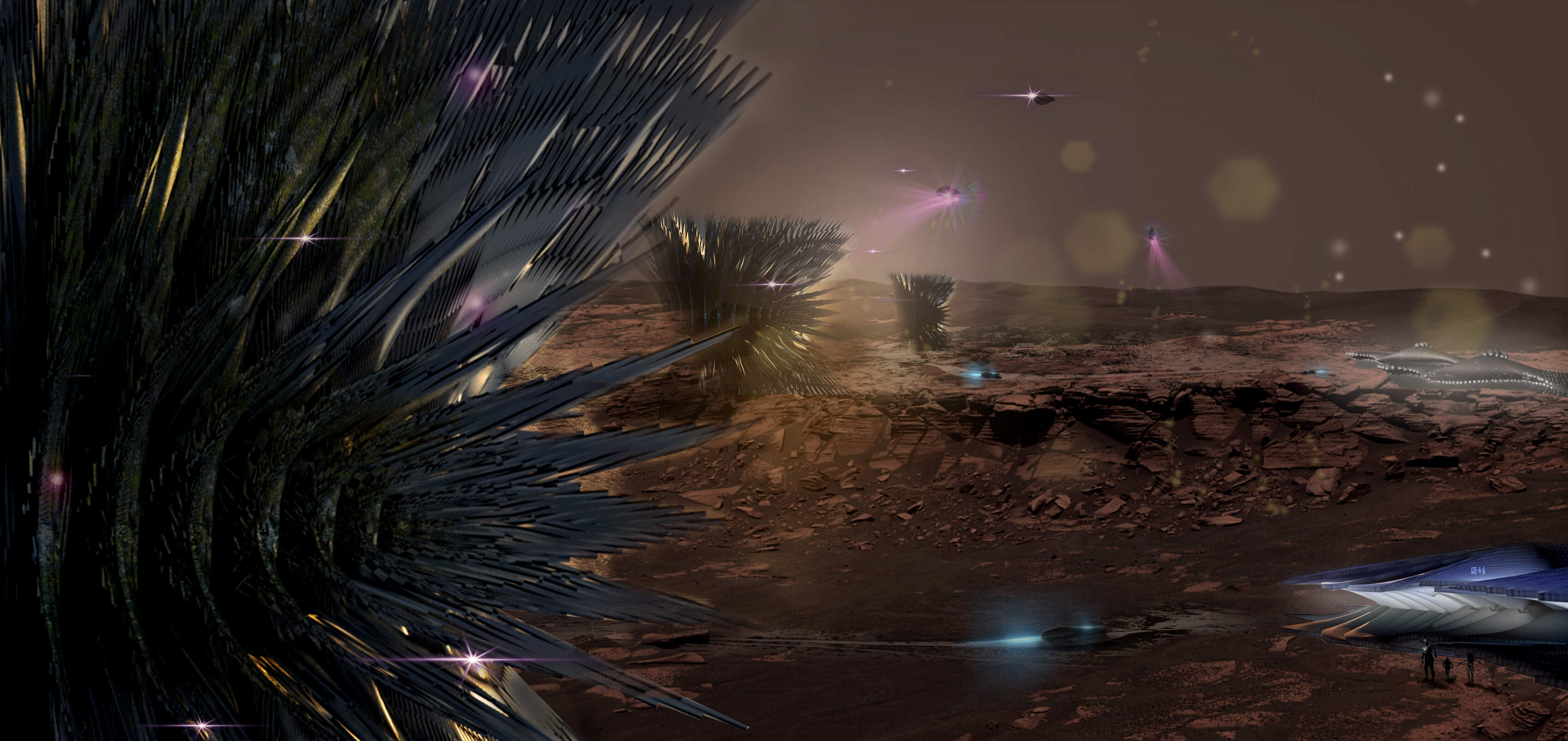
Mars rendering by Space Fictions student Catherine Pageau
Third-year student Catherine Pageau said that she enjoys most how Leach exposes them to the interdisciplinary aspect of the class. She said that although it is an architecture class, students must apply to their designs computation, robotics, and biology to overcome the challenges of designing for space exploration.
For Pageau, enrolling in the class was a step in a different direction as an architect. “…[T]his was an opportunity to get out of my comfort zone and create a project within a very non-conventional context,” she said. “Without the constraints of real clients and the real world, this was the time to creatively explore different areas within and outside architecture.”
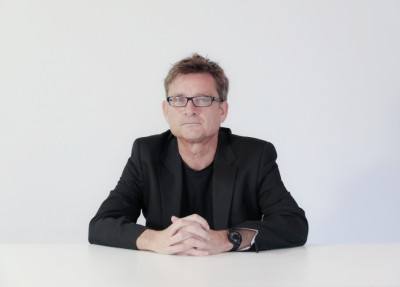
Visiting Professor Neil Leach, FIU Department of Architecture
Neil Leach , an architect, interdisciplinary scholar and NASA Innovative Advanced Concepts Fellow. As a NASA fellow, Leach has worked on a robotic fabrication technology for 3D printing structures on the moon and Mars. In his own words from a chapter in Space Architecture: The New Frontier for Design Research , as a NASA fellow Leach has explored “the use of 3D-printed fabrication technologies that would allow habitats and infrastructure to be constructed by robots” at a certain location in space before humans even arrive at said location. This would “reduc[e] the risk of radiation exposure for construction workers,” said Leach.
In addition to being a NASA fellow and visiting professor at FIU Architecture, Leach is a translator of Medieval Latin ( On The Art of Building in Ten Books ) , a visiting professor at Harvard GSD and Tongji University, a professor at the European Graduate School, and an academician of the Academia Europaea . The Academia Europaea is Europe’s most distinguished, invitation-only scholarly academy that boasts over 50 Nobel laureates among its members. Leach is one of only two architects to have been elected to the academy. Leach also holds a distinguished Chinese government ‘High End Foreign Expert’ visiting professorship at Tongji University. He has close ties with academicians in China and has served as director of the American Academy in China.
Previously, Leach has taught at the Harvard Graduate School of Design , SCI-Arc , Architectural Association, Cornell University , Columbia GSAPP , USC , University of Nottingham and Dessau Institute of Architecture. He holds MA and Dip Arch degrees from the University of Cambridge and a PhD degree from the University of Nottingham. He has published 27 books, which have been translated into several languages. Leach just released his newest book Digital Factory: Advanced Computational Research .
“At the beginning I was in awe and honestly intimidated by his accomplishments,” said Space Fictions student Zoe. “However, as time passed by and I got to work with him more, I realized that his knowledge helped me as a designer and architect. He made me realize what I truly wanted out of this career and what I could apply to it. He has truly become a mentor, and I am honored to work with him for my thesis.”
(via FIU News )
Share this entry
- Share on Facebook
- Share on Twitter
- Share by Mail

About Study Architecture


2024–25 Architecture Research Fellowships Announced
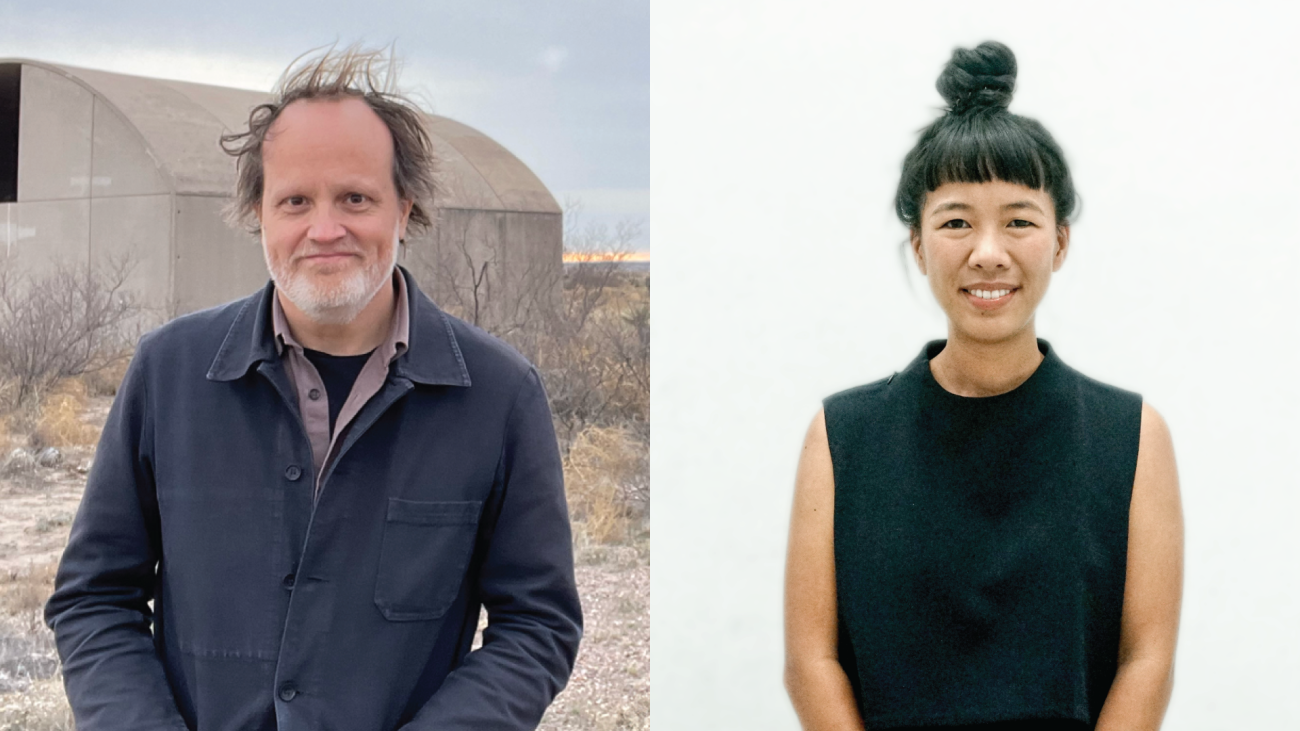
The Rice University School of Architecture is excited to announce that Associate Professor Troy Schaum and Assistant Professor Maggie Tsang are the inaugural recipients of a Rice Architecture Research Fellowship (ARF). This program, funded by the Office of Research and debuting with the 2024–25 academic year, provides a $30,000 research grant and teaching leave, giving faculty the time and space to focus on major scholarly projects.
These awards will support the architecture faculty as they continue to lead the way in research encompassing various forms of thinking, making, and discourse. The establishment of the ARF demonstrates Rice’s commitment to scholarly distinction by supporting the architecture faculty in tackling, holistically and imaginatively, the most pressing issues of our planet and to contributing to thriving urban communities.
Schaum’s research project, “Conservation Entanglements,” investigates how political entanglements and contradictions contribute to the design of buildings and cities and, particularly, how they contribute to the conservation and preservation of cultures, buildings, and communities. With a focus on Marfa and West Texas—or North America’s “Middle Landscape”—the project will result in a two-part international symposium and exhibition at the Chinati Foundation and Rice Architecture.
Referencing the seminal architecture text Learning from Las Vegas , Tsang’s proposal, “Learning from the Swamp,” examines the inscrutability of the swamp and its instrumentality to the urban and environmental history of the American South, where it has long functioned as an ecologically complex site offering alternative ways of seeing, knowing, and representing more-than-human relationships and worlds. The project will include articles, presentations, and, ultimately, a book-length study of swamps as a framework for examining not only natural but also cultural and built environments.
Reflecting on the inaugural ARF projects, Executive Vice President for Research Ramamoorthy Ramesh observed, “This new initiative will be truly transformative for the school and the university, allowing us to expand the breadth of scholarly inquiry across the entire spectrum of the university, including architecture, urbanism, and the built environment more broadly.”
“The Architecture Research Fellowship recognizes both the importance of scholarly inquiry in our field and its immense diversity,” said Igor Marjanović, William Ward Watkin Dean of Rice Architecture. “Research in architecture encompasses a broad spectrum of inquiry—from design to history, theory, and technology—including many methodologies and scales, from local to global, from the scale of individual objects to that of the entire environment. I am delighted that our first cohort of ARF fellows also exemplifies that breadth, clearly demonstrating why architecture matters in a changing world.”
The Architecture Research Fellowship awards will be presented during Rice Architecture’s annual awards ceremony in Farish Gallery, MD Anderson Hall, on Wednesday, April 24, 2024, at 5:00 p.m. A reception will follow the ceremony.
Apply Undergraduate
Undergraduate applications, apply graduate, graduate applications, school overview, about rice architecture, school give, support rice architecture.
Australia's Katherine Bennell-Pegg graduates from European Space Agency astronaut program
It's been a journey of countless small steps, along with a few giant leaps into the unknown, but Katherine Bennell-Pegg is hoping her future as a space traveller is finally on the launch pad as she graduates as a fully qualified astronaut.
"It's still so surreal that this is happening," said the 39-year-old Adelaide resident, who grew up on Sydney's northern beaches.
"When I dreamed of becoming an astronaut, as a child growing up in Sydney, I never thought it possible to do so representing Australia."
For the past 12 months she's been training to become an astronaut at the European Astronaut Centre in Germany.
The mother-of-two was initially among 22,500 other applicants for the training program with the European Space Agency.
Ms Bennell-Pegg is one of six to graduate.
"It's been such an intense year and … I'm yet to take a breath and step back and realise that, 'Today I become an Australian astronaut and I'm spaceflight ready'," she said.
"It's really 'pinch me' stuff.
"I'm filled with gratitude, because this isn't my accomplishment alone. Throughout my life, throughout this year, I've been very well supported by my family, by my schools, by my colleagues. It's just incredible."
While her graduation from the astronaut training program is not in itself a guarantee of being selected for a future space mission, Ms Bennell-Pegg joins a select group of "space-ready" individuals eligible for consideration.
"There's no flight guaranteed for me. That's not unusual for astronauts when they graduate," she said.
"For my class, I'm graduating with five others. All five of them will go to space by 2030 and I'm so excited to see them go up and I'll be cheering them on.
"And who knows, maybe one day I'll see them up there too, but the decision for if or when I fly is a decision for Australia to take in the future when the time becomes right to take it."
If that happens, Katherine Bennell-Pegg will not be the world's first Australian-born astronaut.
That distinction already belongs to Paul Scully-Power who joined a NASA mission in 1984.
Fellow Aussie Andy Thomas also went to space with NASA in 1996.
Both men were United States citizens when they went to space.
But Ms Bennell-Pegg has pushed into a new frontier by becoming the first person to be trained as part of Australia's own space program.
At the front of the line
That means she is well-placed to potentially become the first person sent into space as part of an Australian mission.
"Well, the future is full of promise, but still unknown," Ms Bennell-Pegg said.
"Australia has a long and proud history in space, but we've only just accelerated our capabilities in recent years.
"Our space agency is quite young, so it's early days.
"And I really stand on the shoulders of giants here as well. Not only the first Australians to go to space in recent decades, but the many others who have worked to build Australia's space sector over the years."
With her training secondment to the European Space Agency at an end, Ms Bennell-Pegg returns to her day job as director of space technology at the Australian Space Agency.
It was an arduous 12 months for the Sydney woman as she tackled the rigorous training required to help her become accustomed to the physical and mental demands of space flight.
That included learning to speak Russian, long hours underwater in scuba equipment practising how to perform spacewalks, and stints in centrifuges and oxygen low-pressure chambers.
Simulated weightlessness flights have been a particular favourite.
"Oh, it's absolutely incredible," Ms Bennell-Pegg.
"When we go on zero-G flights, as they're called, you experience weightlessness for about 22 seconds at a time.
"You lift off the floor and your belly goes into your throat and stays there, but as the gravity kind of drops off, you just get the biggest smile on your face.
"It's the most different feeling. You just have this feeling of absolute freedom."
Regardless of whether she travels into space one day, Ms Bennell-Pegg hopes she can be a trailblazer for future generations of Australian kids ready to set their sights sky-high.
"For those that want to become astronauts, it's absolutely as fun as you can imagine," she said.
- X (formerly Twitter)
Related Stories
Adelaide woman to become first female to train as astronaut under australian flag.
This Australian astronaut has some advice for surviving self isolation
One small step for Sydney: Australia's first man in space joins team NSW in agency pitch
- Astronomy (Space)
- Human Interest
- Space Exploration
- University of Wisconsin-Madison

CBE PhD student Seth Anderson selected for DOE Graduate Student Research program
Departments:, categories:.
Renewable energy technologies, like solar and wind power, are an important element in the clean energy transition. But they do have one major drawback; they don’t produce energy unless the breeze is blowing or the sun is shining. To get around this, it’s possible to use their electricity to power electrochemical reactions that generate clean burning hydrogen. That hydrogen could then be used to generate electricity, power cars and trucks, and be used in industrial processes 24/7.

The problem is, making hydrogen electrochemically is challenging. That’s why Seth Anderson, a PhD student in chemical and biological engineering at the University of Wisconsin-Madison, is planning to use a Department of Energy Office of Science Graduate Student Research award to advance the technology. The program enables highly qualified graduate students to pursue their thesis research for up to one year while working at one of the United State’s national laboratories. Anderson will pursue his research at Lawrence Berkeley National Laboratory in Berkeley, California.
Anderson currently studies electrochemistry in the lab of CBE Assistant Professor Matt Gebbie . In particular, Anderson studies the water reduction reaction, or hydrogen evolution reaction, that occurs when water reacts with an electrode and produces hydrogen gas. Specifically, he studies how various electrolytes, or the fluids in batteries or electrochemical systems that carry an electrical charge, impact the performance of the water reduction reaction.
“I am very interested in how unique electrolyte compositions can influence the way water structures itself at the catalyst surface,” he says. “Essentially, I am trying to link water reduction performance with aspects of electrolyte composition and water hydrogen-bond structures near the catalyst.”
At Lawrence Berkeley National Laboratory (LBNL), Anderson will work with Dr. Maximillian Jaugstetter to further study these unique electrolytes and how the water structures they create can impact reaction rates. At LBNL, Anderson will have access to a synchrotron, a type of particle accelerator, that will allow him to get high resolution spectra that show how the electrolyte is structured on a molecular level.
“I am stoked out the wazoo at getting this award. I am a very fortunate person to even be in the position to apply and I am just so excited other people are interested in the research we do in the Gebbie lab,” says Anderson. “I think I have always been motivated by trying to do my part to produce green energy and this is just an extension of that. I want to answer basic questions that other people can use to scale up renewable energy processes and this kind of award just makes me feel like I am doing my part.”
This year, the Department of Energy selected 86 graduate students from 31 states and Puerto Rico for the program . Collin Sutton, a PhD student in the Department of Geoscience at UW-Madison, was also selected for the program and will pursue his research at Los Alamos National Laboratory.
You are using an outdated browser. Please upgrade your browser to improve your experience and security.
- Newsletters
- Terms of use
- Contributors
Architects recognised in 2024 NSW heritage awards shortlist
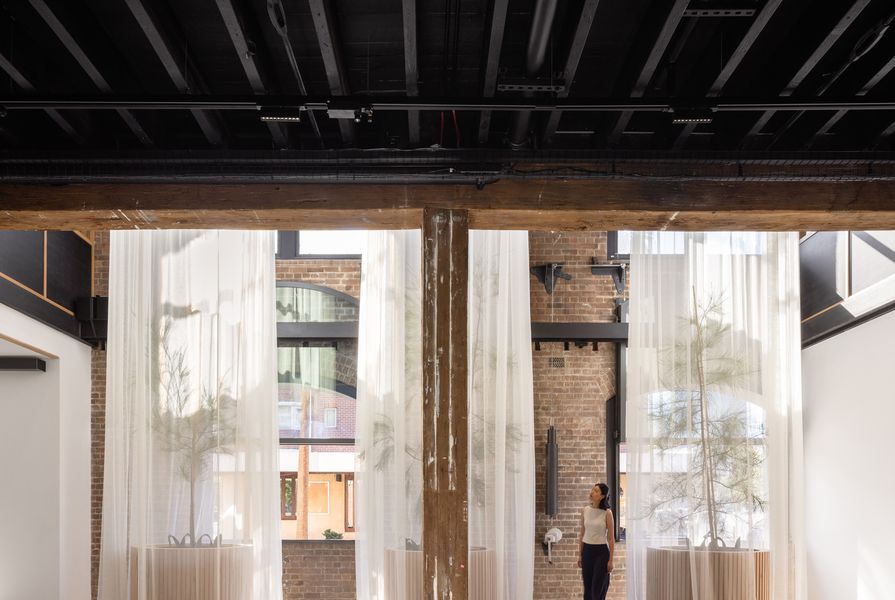
The Gunnery Transformation, Woolloomooloo – entered by Dunn Hillam Architecture and Urban Design.
Image: Katherine Lu
Several architecture practices have been recognised in the 2024 National Trust (NSW) Heritage Awards shortlist for their efforts in preserving history when redeveloping a space.
The annual National Trust (NSW) Heritage Awards program is in its 30th year. This year, architect Matthew Devine chaired the jury, alongside jurors Ann Toy, Barrina South, Dr Caitlin Allen, David Burdon, Kathryn Pitkin, Libby Gallagher and Peter John Cantrill.
The judging categories include Aboriginal Heritage; Advocacy; Architecture; Built Conservation; Interiors and Objects; Landscape; Education and Interpretation; Events, Exhibitions and Tours, and Resources and Publications, among other individual and special categories, including: New Young Achiever; Heritage Skills Lifetime Achievement; Cathy Donnelly Memorial; Judges’ Choice, and the President’s Prize.
The finalists include:
Architecture
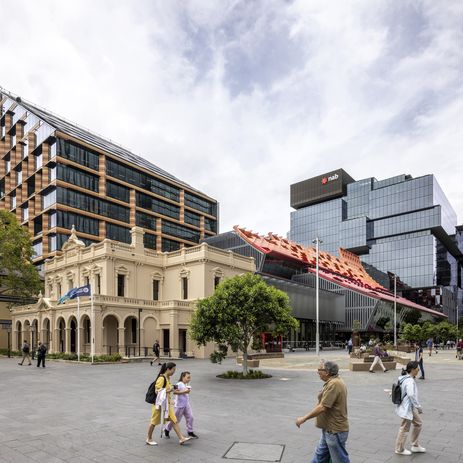
Parramatta Town Hall by DesignInc, Lacoste and Stevenson, Manuelle Gautrand Architecture and TKD Architects.
Image: Brett Boardman
119 Redfern Street, Redfern – entered by Aileen Sage Architects
Bellevue Hill House – entered by Tribe Studio Architects
Birchgrove House – entered by Carter Williamson Architects
Central Station, Sydney – entered by Sydney Metro
Making heritage apartments accessible: new lift at Santa Barbara, Point Piper – entered by Orwell and Peter Phillips
Parramatta Town Hall – entered by DesignInc, Lacoste and Stevenson, Manuelle Gautrand Architecture and TKD Architects
The Estate – entered by Luke Moloney Architecture
The Gunnery Transformation, Woolloomooloo – entered by Dunn Hillam Architecture and Urban Design
Built Conservation

White Bay Power Station by heritage architecture firm Design 5 and FDC Construction and Fitout.
Image: Toby Peet
Albury Railway Station Roof Conservation Works – entered by Transport for NSW
Chullora Heritage Hub – Tank Annex – entered by Arenco (NSW) Pty Ltd
Glass House: Bill and Ruth Lucas, Castlecrag – entered by Cracknell and Lonergan Architects
McKanes Bridge Capacity Upgrade, South Bowenfels – entered by Transport for NSW
Parliament of NSW Facades Restoration Project, Sydney – entered by Department of Parliamentary Services
Preservation, Restoration and Reconstruction of Trim Cottage, Armidale – entered by Jesse Dick and Tahlia Stewart
Refurbishment of the Sawtell Reserve Hall – entered by City of Coffs Harbour
Restoration of Building 10 (Estimating and Drawing Office) at Cockatoo Island / Wareamah – entered by Sydney Harbour Federation Trust
St Vincents College Conservation Works, Potts Point – entered by VS Architecture
The Australian Metal Workers’ Union Building, Surry Hills – entered by Hector Abrahams Architects
The White Bay Power Station , Rozelle – entered by Placemaking NSW, Design 5 Architects, CBRE and FDC
Interiors and Objects
NSW Parliament Chambers Restoration Project, Sydney – entered by Department of Parliamentary Services
Parramatta Town Hall – Restoration and Reproduction of Original Stencilling to Main Hall, Foyer and Stairs – entered by Paintwrights
Restoration of D class Tramcar 117 of 1899, Loftus – entered by Sydney Tramway Museum
The Irving Street Brewery, Chippendale – Objects and Salvaged Machinery – entered by Urbis Ltd
The SSILO project, Coffs Harbour – entered by City of Coffs Harbour and International Conservation Services (ICS)
Clontarf Tidal Pool Renewal – entered by Northern Beaches Council
Tomaree Coastal Walk, Tomaree National Park, Port Stephens – entered by NSW National Parks and Wildlife Service
West Head Lookout, Ku-ring-gai Chase National Park – entered by Oculus and Bruce Mackenzie with NSW National Parks and Wildlife Service
Wilson Park Water Feature (Map of Australia), Lawson – entered by Blue Mountains City Council
See the full shortlist for the NSW Heritage Awards on the National Trust’s website .
The winners will be announced at the National Trust Heritage Awards ceremony on 17 May 2024 at Doltone House in Pyrmont. To purchase tickets for the awards ceremony, visit here .
Related topics
More industry news.

A proposal for a $276 million tower above two heritage listed buildings on Collins Street will be put before the City of Melbourne, with the …

The City of Sydney has proposed a number of amendments to the Sydney Local Environment Plan that would encourage developers to create more build-to-rent and …
PRODUCTS by

Latest on site

LATEST PRODUCTS

Parramatta Town Hall by DesignInc, Lacoste and Stevenson, Manuelle Gautrand Architecture and TKD Architects.
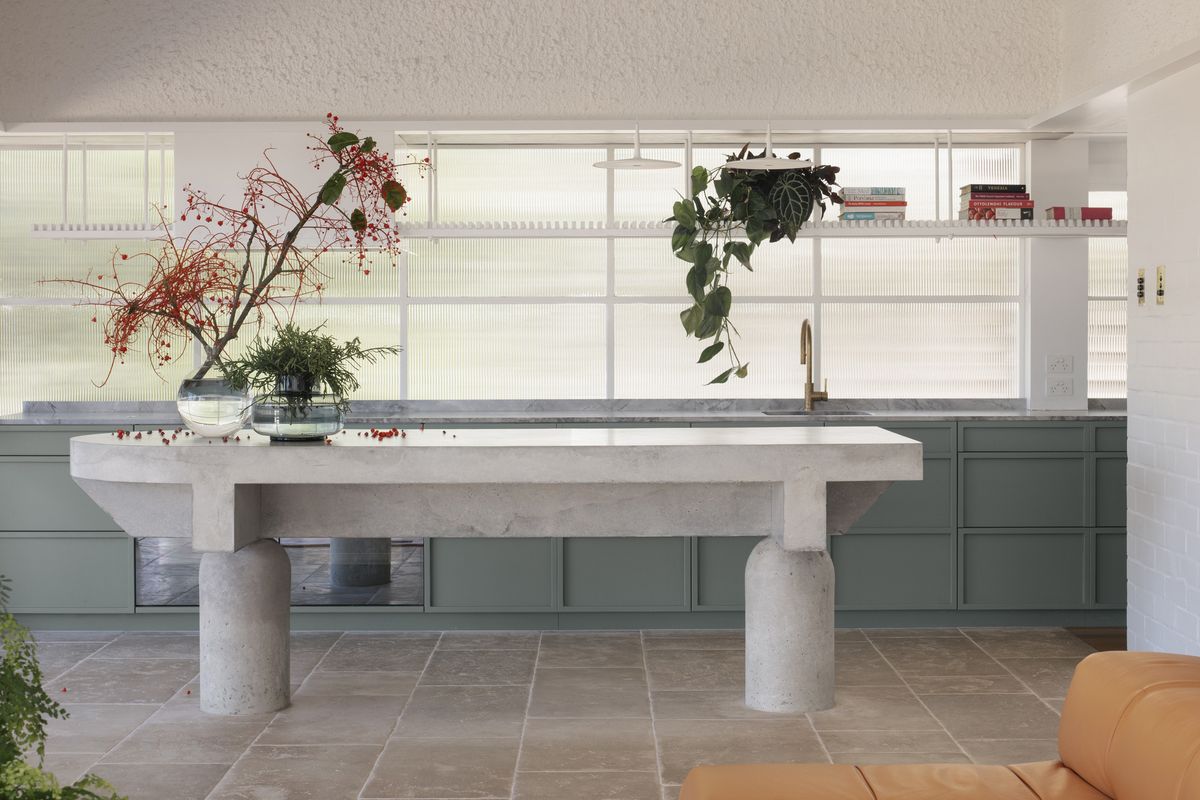
Bellevue Hill House by Tribe Studio Architects.
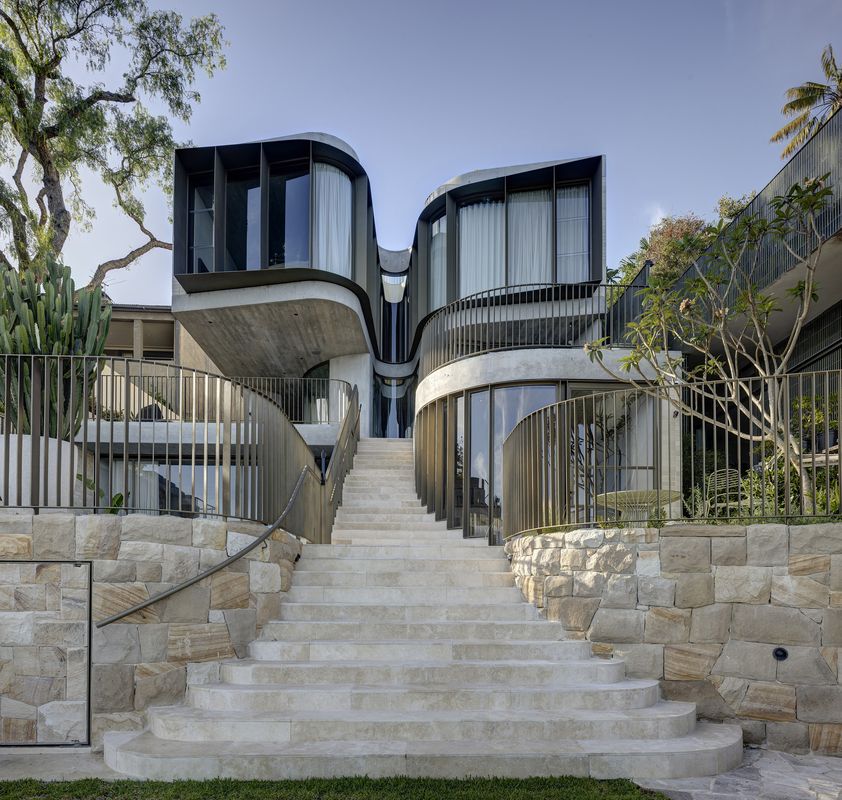
Birchgrove House by Carter Williamson Architects.

White Bay Power Station by heritage architecture firm Design 5 and FDC Construction and Fitout.
Architecture Media acknowledges the Traditional Custodians of the land and waters of Australia.
Tell us where we should send the Latest news
Join our architecture and design community for the latest news and reviews. Be first to know.
You may also like other Architecture Media network newsletters:
- Washington State University
- Go to wsu twitter
- Go to wsu facebook
- Go to wsu linkedin
Voiland College names 2024 outstanding students

Washington State University Voiland College of Engineering and Architecture recognized outstanding students at its annual convocation ceremony on April 11. The event was sponsored by the Boeing Company. Honored award winners included:
- Outstanding Sophomore: Rylee Gannon A chemical engineering major with a 3.8 GPA, Rylee Gannon is a research assistant for Professor Steve Saunders, where she synthesizes and characterizes nanomaterials for use as catalysts in oxidation reactions Gannon also works in the Frank Innovation Zone and is an active member of the Society of Women Engineers.
- Outstanding Junior: Ethan Villalovoz Ethan Villalovoz is a computer science student with a GPA of 3.99, specializing in data mining, machine learning, and data science. Some of his more notable achievements include being a CS Research Mentorship Program Scholar, a Generation Google Scholarship Recipient, and a Hispanic Scholarship Fund Scholar. He has also engaged in extensive extracurricular activities, including internships at Google and a research position at Carnegie Mellon University.
- Outstanding Senior: Katy Ayers A Fulbright Fellowship Award and Marshall Scholarship Semifinalist, Katy Ayers is the first WSU student to win the Udall Scholar in Environment award. Her thirst for knowledge has given her robust research experience around the country and the world. One of Ayers’ nominators said, “Although I have worked with many outstanding students in my 20 years of teaching at the undergraduate level, I don’t think I have met anyone with Katy’s experiences, accomplishments and passion. She is motivated, demonstrates curiosity and critical thinking and communicates incredibly well.”
- Outstanding Teaching Assistant for grading/office hours: Kutay Sesli Kutay Sesli’s nominators were impressed by his innovative approaches and genuine care for students this past year. Kutay recognized that that conventional ways to grade assignments might not provide a full picture of where students need improvement, so he took the initiative to develop an innovative, consistent, fair, and detailed grading system that helped students develop trust in the grading process and a better understanding of how to improve their performance throughout the semester. He approaches each task with the mindset of a true engineer, and the results left no doubt that his grading was done with meticulous attention to detail and with the best outcomes for students in mind. Among the feedback students have given include: “Kutay is the best TA all semester, excellent job!” and “Kutay is dope!”
- Outstanding Teaching Assistant — Teaching/Instruction: Chris Pereyda Chris Pereyda has served as teaching assistant in several courses, including Introduction to Computer Programming. In one of his courses there were more than 500 students. One of those students said of Chris: “He is one of the best TAs I have ever had the pleasure of learning from. Being a Computer Science student can be difficult, but his explanations and knowledge of the source material helped me grasp some of the concepts better and persevere.” One of his faculty members said, “Chris was one of my most reliable, impactful, and effective TAs during my twenty years of teaching at WSU. Chris is the ideal example of a lead teaching assistant. He is knowledgeable in the area, patient with TAs and students, flexible and adaptive to different TAs’ and students’ styles and paces. There is not a better example of a TA than Chris.
- Outstanding Research Assistant: Ali Mahmoodigahrouei As a PhD candidate at WSU, Ali Mahmoodigahrouei has shown an exceptional academic record and research skills. Since joining WSU in 2022, he has published 14 impactful papers with over 300 citations, earning several prestigious awards, including the David C. Goss Scholarship and the “UTC Outstanding Student of the Year Award.” His nominators feel he consistently goes above and beyond expectations, managing multiple projects simultaneously and with great success. He also excels as a mentor, effectively supervising undergraduate students while providing valuable assistance to other PhD students in his research group.
- Outstanding Dissertation: Lin Shao Lin Shao’s nominators say that he is a truly exceptional graduate student and has done excellent research on chemical recycling of plastic waste by aminolysis and utilization of the recycled compounds for preparation of new polymer materials. His thesis research has received a broad interest from researchers around the world. Shao, as one of guest speakers, was invited to give a seminar at the Royal Society of Chemistry and Chemistry World. His research was also featured by “The Voice of America.”

Todd Butler resigns as dean of the College of Arts and Sciences
Recent news.

WSU to study effect of controversial drug on racehorses

Regents start search process for next WSU president

Second chances: Graduate student receives NSF research fellowship

Extension tackles climate awareness
Regents approve new degree programs, discuss faculty listening sessions.
one house design sculpts undulating silhouettes for fluid versatile workspace in shanghai
Designer fang lei plans shanghai transaction succeed office.
The Shanghai Transaction Succeed Office, designed by One House Design, reimagines office space with a focus on combining multiple functional areas. The design explores the combination and interaction of multiple spaces by excavating the distinctive features of the company, and by extracting, breaking down, and developing from the elements of its logo. Repeating organic forms, undulating silhouettes, and multi-dimensional mapping overlap create a fluid space that mimics a wormhole. The project integrates exhibition, office, banquet, and recreational activity areas, presenting a unique encounter between people and space.
The interior, conceptualized by founder Fang Lei and the One House team, emphasizes a contemporary, minimalist, and efficient design. This ‘borderless, parallel workspace’ accommodates various work scenarios, aiming to adapt to the future of office spaces and support business growth. At the entrance, mirrors on the ceiling and walls blur the lines between virtual and real, creating depth and tranquility. Free-flowing silhouettes flood the interior, opening up from a glass front punctuated by curved windows. The design explores aesthetic contrasts through the use of color, material, and shape, adding artistic layers to the overall experience.
The display section features a raised floor, a tiered roof, and a built-in BOX block, creating a visually interconnected fluid space with undulating silhouettes, multi-dimensional mapping, and organic forms. This area serves both as a gallery and exhibition space, with an art installation with contrasting colors and lighting as the central hub. The open office space offers visual permeability and clean lines, featuring large floor-to-ceiling windows that merge the interior with the exterior.
organic forms and reflective finishings flood the interior
The design uses minimalist approaches in the general manager’s office, emphasizing simplicity. The adjacent reception area provides a casual setting for social interaction, where a harmonious ensemble of shapes, colors, and textures is conveyed with a sense of volume, fluidity, and enveloping comfort. A circular layout of traffic flow lends flexibility to the space while connecting each functional zone. A glass curtain encloses the atrium, filtering out noise without blocking sunlight. Covered in reflective stainless steel, the column appears floating with rows of storage cabinets, channeling versatility and clean minimalism with a circular hallway.
The banquet room, with sliding doors and rich textures, provides a private yet connected area. The teppanyaki section is adorned with a metal grid, offering tactile textures and a play of light and shadow. Open and private at the same time, the banquet room is a continuation and integral part of the entire space, dotted with the same materials, shapes, and details.
A vibrant cultural and entertainment area is included for clients’ children, featuring music, study, and physical training spaces including a climbing wall. The music room’s design incorporates futuristic elements and changing colors for a dynamic atmosphere. With a focus on lightness and translucency, the study area features light-emitting ceiling films and curved elements. For the design, One House , led by Fang Lei, combines modernism, avant-garde, and inclusiveness to create an environment that balances daily routines with future possibilities, enhancing the connection between work and life.
free-flowing silhouettes and curved windows open up the space from the glass front
a circular layout provides flexibility to the space, connecting functional zones and enhancing fluidity
project info:
name: Shanghai Transaction Succeed Office
architect: One House Design
lead designer: Fang Lei
design team: Li Huang, Wang Jiarui, Zhao Binjie
area: 1600 sqm
location: Yuejie Expo Park, Huangpu District, Shanghai, China
visual display: Wendy Li, Pass Pan, Chen Ying
photography: Zhu Qingyan
designboom has received this project from our DIY submissions feature, where we welcome our readers to submit their own work for publication. see more project submissions from our readers here.
edited by: christina vergopoulou | designboom
ARCHITECTURE IN SHANGHAI (205)
Where people work (850), product library.
a diverse digital database that acts as a valuable guide in gaining insight and information about a product directly from the manufacturer, and serves as a rich reference point in developing a project or scheme.
- architecture in the czech republic (136)
- brick architecture (306)
- christian kerez (4)
- residential architecture and interiors (3818)
- architecture on stilts (79)
- fictional architecture (217)
- glass art and design (161)
- shipping container architecture (196)
- architecture in colombia (33)
- facades (241)
- school architecture and design (686)
- thomas heatherwick (103)
- architecture in japan (1489)
- architecture interviews (263)
- concrete architecture and design (695)
- mariko mori (5)
designboom will always be there for you

The Bartlett Development Planning Unit
- Advisory Services
- Publications

PhD student Alban Hasson successfully defends thesis on Urban Agriculture and Democratisation
23 April 2024
Congratulations to Alban Hasson who has successfully defended his thesis on the contributions of urban agriculture (UA) practitioners in London in expanding the political space towards a democratic food regime.

Image Credit: Alban Hasson
Alban Hasson's thesis built on Webster and Engberg-Pedersen’s political space framework (2002), argues that democratisation is emerging from a set of contestations by UA practitioners within existing and emerging institutional channels, but also through the historical struggle of contesting hegemonic political discourses. This arguments considers these contestations as being co-constituted through developments in specific social and political practices.
His research compares the allotment and community garden trajectories in their diversity and assesses the democratic processes produced in seeking another way of engaging with food. Through historical and ethnographic in-depth case studies, the thesis sheds light on the practices of commoning and the struggles faced by UA practitioners to create a more just and sustainable food regime.
He considers five democratic processes of UA necessary to expand the political space of food towards a more democratic food regime: fostering food security, expanding health benefits, reclaiming the commons, building places of interaction and representation, and decoupling from the regimes; and exploring how community UA practitioners engage with, negotiate, or resist current governance networks to expand the political space towards these democratic processes.
In so doing, his thesis highlights some of the discriminations at play and enables the proposition of solutions to continue to build intersectional environmental and food justice in London’s UA trajectories.
Related News

IMAGES
VIDEO
COMMENTS
The Sasakawa International Center for Space Architecture (SICSA) is a unique interdisciplinary research, design and teaching academic center that supports the world's only Master of Science (MS) degree in Space Architecture.In 2015 The Texas Higher Education Coordinating Board approved changing the degree to a master of science with a STEM — science, technology, engineering and math ...
About this degree. Architectural Space & Computation MPhil/PhD is associated with the world-renowned Space Syntax Laboratory.With its empirical base, this programme is aimed at researchers seeking to advance knowledge by studying the relations between spatial patterns and social outcomes, and between architectural design knowledge and computation.
What types oF graduate degrees do you oFFer in space architecture? The UH Cullen College of Engineering offers an M.S. degree (thesis) in space architecture. For more inFormation For more information on eligibility and admis-sions requirements, please visit sicsa.egr.uh.edu/ welcome/ms-space-architecture-curriculum
Breathing Space: The Architecture of Pneumatic Beings (2018). Abstract. Anna Bokov. Teaching Architecture to the Masses: Vkhutemas and the Pedagogy of Space, 1920-1930 (2017). Abstract. ... The program in Architecture considers teaching to be an important part of graduate training. Students in the Ph.D. program in Architecture are expected to ...
The SICSA offers two types of curriculum in the Space Architecture program of the University of Houston, one for full-time students (3 semesters) and another for part-time local industry employees (5 semesters). University of Houston. Houston , Texas , United States. Top 2% worldwide.
PhD in Architecture. This program prepares students to enter the academic professions, either in architectural history, architectural design, or other allied fields. ... Her master's thesis focused on the Indian Forest Act of 1865, and elucidated the conceptualization of the space of the 'forest' through the lenses of its literary ...
Version 1.12.8. The Doctor of Philosophy is intended for persons who wish to enter teaching and advanced research careers in the History and Theory of Architecture, Architectural Technology, Landscape Architecture and Urban Form from Antiquity to the Present; or The Analysis and Development of Buildings, Cities, Landscapes, and Regions with an ...
Lecture Franca Trubiano Architecture Wednesday, March 22, 2023 6:30 pm Rare Books Room, Fisher Fine Arts Building 220 S 34th Street, Philadelphia, PA. Welcome to the PENN Ph.D. and MS Programs in Architecture. Our graduate group faculty, candidates, students, and alumni welcome you to our website, eager to share with you their commitment to ...
The Degree. A prerequisite to start your PhD is to have a Master of Arts. This is typically already built into the PhD program itself and could take up to two years to complete. The Master of Arts degree is seen as a preparation for a PhD degree. Although built-in, you may still need to apply to enter the PhD degree once completed.
The PhD in Architecture (PhD-Arch) program at Carnegie Mellon advances interpretive, critical and contextual perspectives on the built environment and spatial design. The program offers students an interdisciplinary platform to investigate built environment cultures, practices and politics across a range of historical and geographical contexts ...
Doctoral. The Bartlett School of Architecture has a world-class and thriving research community. Students study towards their PhD within five different streams. We are a multi-disciplinary department with researchers active in architectural design, history, theory, practice, computation and space syntax, who bring together approaches from the ...
The objective of the M.S. program is to provide graduate students, who have that developed a high level of knowledge in the field of human space exploration, with expertise in specific aspects of space studies, space settlements, space systems. ... Students explore advanced space architecture to assess the key issues of establishing human space ...
Fundamentally, space architecture is an extension of Earth architecture. Earth is a celestial body in space; so is Mars; so is the Moon. Space architecture beyond Earth differs from terrestrial architecture by extreme environmental conditions: high radiation, low (or no) atmospheric pressure, low (or no) apparent gravity, and large temperature ...
Ekblaw, Ariel. "Self-Aware Self-Assembly for Space Architecture: Growth Paradigms for In-Space Manufacturing." PhD diss., Massachusetts Institute of Technology, 2020. 2019. Won AIAA Space Architecture Technical Committee 2019/2020 BEST PROFESSIONAL PAPER for: Ekblaw, Ariel, Anastasia Prosina, Dava Newman, and Joseph Paradiso. "Space Habitat ...
Sasakawa International Center for Space Architecture (SICSA) of the Cullen College of Engineering, University of Houston, offers the world's only Master of Science in Space Architecture degree. MS-Space Architecture is an interdisciplinary program and fully dedicated to the field of space architecture.
Admissions. Applicants to the PhD program must have completed a four-year Bachelor of Arts or Bachelor of Science degree. A professional degree in architecture, landscape architecture, or urban planning is recommended but not necessary. For students planning to pursue the Architectural Technology track within the PhD program, a background in ...
Students are required to take 16 "half-courses" (i.e., semester-length courses). Coursework is divided between the GSD and departments in FAS. Each student's curriculum is closely tailored to her or his specific interests. Students are eligible for the A.M. degree after successful completion of 8 half courses.
The PHD in Architecture addresses the development of modern architectural form and ideas as they have been affected by social, economic, and technological change. In broad terms, it encompasses the relations between the profession, practice, civil institutions, and the society at large. As a doctoral program, it is oriented toward the training ...
History of modern architecture; urbanism and urban culture; skateboarding, graffiti and urban arts; public space; experiences of architecture; film, photography and other urban representations; critical theory and cultural studies. Roberto Bottazzi The aesthetic, spatial and philosophical impact of digital technologies on architecture and urbanism.
Rationale for the Program. Graduate students interested in the related fields of Aerospace Engineering and Space Architecture can combine their studies in a Dual Aerospace Engineering/Space Architecture Master of Science degree program.The dual degree allows students to obtain a M.S. degree in Aerospace Engineering and a M.S. degree in Space Architecture by completing 46 credit hours of ...
125th Anniversary Scholarships for Black British Researchers - Space-based solutions for improved space sustainability. University of Birmingham School of Metallurgy & Materials. We seek an enthusiastic and capable individual to join our team as a PhD researcher in the field of space-based solutions for a sustainable space future. Read more.
The Programme brings together research approaches from the arts, humanities, social sciences, and engineering to the study of architecture and design. The degree of Philosophiae Doctor (PhD) is conferred on the basis of: Completion of the PhD Programme's educational component (30 ECTS) Approved academic doctoral thesis.
(via FIU News). Nasa Fellow Teaches Students How to Design for Outer Space. A new Architecture seminar, Space Fictions, offered at the Florida International University, places students within the framework of outer space, challenging them to design a habitat in space while considering practical issues like radiation and weightlessness.Their work is inspired by design fiction, a design method ...
The Rice University School of Architecture is excited to announce that Associate Professor Troy Schaum and Assistant Professor Maggie Tsang are the inaugural recipients of a Rice Architecture Research Fellowship (ARF). This program, funded by the Office of Research and debuting with the 2024-25 academic year, provides a $30,000 research grant ...
The mother-of-two was initially among 22,500 other applicants for the training program with the European Space Agency. Ms Bennell-Pegg is one of six to graduate. "It's been such an intense year ...
The problem is, making hydrogen electrochemically is challenging. That's why Seth Anderson, a PhD student in chemical and biological engineering at the University of Wisconsin-Madison, is planning to use a Department of Energy Office of Science Graduate Student Research award to advance the technology. The program enables highly qualified ...
The Gunnery Transformation, Woolloomooloo - entered by Dunn Hillam Architecture and Urban Design. Several architecture practices have been recognised in the 2024 National Trust (NSW) Heritage Awards shortlist for their efforts in preserving history when redeveloping a space. The annual National Trust (NSW) Heritage Awards program is in its ...
2024 Voiland College of Engineering and Architecture outstanding students with Dean Partha Pande and Associate Dean Shelley Pressley. Washington State University Voiland College of Engineering and Architecture recognized outstanding students at its annual convocation ceremony on April 11. The event was sponsored by the Boeing Company.
Shanghai Transaction Succeed Office, designed by One House, combines multiple functional areas. organic forms and undulating silhouettes mimic a wormhole, creating a fluid, multidimensional space ...
Alban Hasson's thesis built on Webster and Engberg-Pedersen's political space framework (2002), argues that democratisation is emerging from a set of contestations by UA practitioners within existing and emerging institutional channels, but also through the historical struggle of contesting hegemonic political discourses.